Affaire Dreyfus
Affaire Dreyfus
ドレフュス事件
★【梗概】
ドレフュス事件(仏: affaire
Dreyfus、発音: [afɛ
dʁʁ])は、1894年から1906年の解決まで、フランス第三共和政を二分した政治スキャンダルである。このスキャンダルは1894年12月、ユダヤ
系アルザス人のフランス人砲兵将校アルフレッド・ドレフュス大尉(35歳)が、パリのドイツ大使館にフランスの軍事機密を伝えたとして国家反逆罪で不当に
有罪判決を受けたことから始まった。彼は終身刑を宣告され、海外にあるフランス領ギアナの悪魔の島の流刑地に送られ、その後5年間、非常に過酷な環境で投
獄生活を送った。
1896年、主にスパイ対策責任者ジョルジュ・ピカール中佐の調査によって、真犯人がフェルディナン・ワルサン・エステルハージというフランス陸軍少佐で
あることが判明した。軍高官たちはこの新証拠を封じ込め、軍法会議はわずか2日間の裁判の後、満場一致でエステルハージを無罪とした。陸軍は偽造文書に基
づき、ドレフュスに対してさらなる告発を行った。その後、作家エミール・ゾラが『オーロール』紙に発表した公開書簡「私は告発する...!」が、ドレフュ
スを支持する政治的な動きを煽り、ドレフュスの裁判を再開するよう政府に圧力をかけた。
1899年、ドレフュスは再び裁判を受けるためにフランスに戻された。ドレフュスを支持するサラ・ベルナール、アナトール・フランス、シャルル・ペギー、
アンリ・ポアンカレ、ジョルジュ・クレマンソーなどの「ドレフュス派」と、ドレフュスを非難する、反ユダヤ主義的な新聞『ラ・リーブル・パロール』の発行
人であったエドゥアール・ドラモンなどの「反ドレフュス派」にフランス社会は二分された。新たな裁判の結果、ドレフュスは再び有罪判決を受け、10年の刑
期を言い渡されたが、赦免され釈放された。1906年、ドレフュスは釈放された。フランス陸軍少佐に復職したドレフュスは、第一次世界大戦の全期間に従軍
し、中佐の地位でその任務を終えた。1935年に死去した。
ドレフュス事件は、フランス語圏における現代の不公正を象徴する事件となった[1]。ドレフュス事件は、フランスを親共和主義的で反神権的なドレフュス派
と親陸軍的でほとんどがカトリックの反ドレフュス派に分裂させ、フランスの政治を混乱させ、急進化を促した[2]。報道機関は、情報を暴露し、対立する双
方の世論を形成し表現する上で重要な役割を果たした。
★【時系列】
1)1894年7月20日 マリー=シャ ルル=フェルディナン・ワルシン・エ ステラージ少佐は、パリ駐在ドイツ大使館附武官マクシミリアン・フォン・シュヴァルツコッペンに面会を申し入れ、フランス陸軍に関わる機密 情報の売却を持ちかける。
2)エステラージ少佐とシュヴァルツコッ ペンの間で、複数回の面会と書面の交換がおこなわれる。
3)120ミリ砲制動機使用法等「数日中 に入手見込み」軍事情報が書かれたエステラージ作成の1通の手紙が、6片に破られて・シュヴァルツコッ ペンの屑篭に捨て置かれる。
4)ドイツ大使館の掃除婦を装ったフラン ス側のスパイであるバスティアン夫人が、焼却処分を装いその屑篭の中味を、拾い出す。
5)同年9月26日バスティアン夫人は、 フランス陸軍参謀本部統計局に中味を委ねる。
6)統計局内でスパイの実務を引き受けて いたユベール=ジョゼフ・アンリ少佐は、この文書を「明細書」と名付けて、翌9月27日、局長ジャン・ サンデール大佐に実物を示し報告する。
7)その場にいたマトン大尉は、明細書の 中味から、明細書の書き手は、参謀本部内の砲兵士官である可能性を示唆する。
8)サンデールは、9月27日のうちに、 参謀次長ルヌアールを通じて、陸軍大臣メルシェに事実関係を報告する。メルシェは真相究明を指示。
9)9月28日以降の数日間に、ルヌアー ル、サンデール、アンリによる内偵がすすむ。
10)明細書の筆跡を調べ、写真版を作成 し、部署の局長級に配布し、同様の、類似書類がないかの作業を依頼する。
11)10月5日までは、なんの進展もな かった。
12)10月6日。同日に着任した参謀本 部第4局次長ダボヴィル中佐は、 局長ファーブル大佐に対して、容疑者の可能性について独自の自説を披 露する(同日昇進の勇みがあったのではないか言われる)。それは、「明細書」の内容が、ひろく局内の情報に分散していたために、自由に局内(第1〜4局ま である)に出入りできるのは、参謀本部付きの研修生であると。
13)ファーブル局長は、過去4,5名の 研修生を受け入れており、個別に評価を認めている。
14)ファーブル局長の予見は、前年 1893年の下半期で第4局で研修を受けて、当時大尉であったアルフレッド・ドレフュス大尉を焦点があてら れた。
15)その理由は、ファーブルの評価がド レフュスに対して低いものであることにつきた(後に裁判に証拠として文書が提出される)。評価書の記述 「士官として欠陥あり。知力、才気ともに申し分なきも、矜持に満ち、性格、良心、勤務態度の面で参謀本部に配属されるための条件を満たしておらず」(菅野 2002:9)。
16)しかし、このファーブルの評価書 は、部下で研修生の指導に関わるロジェ中佐とベルタン=ムロー少佐の報告をそのまま鵜呑みにしたもので あった(破毀院, 2:41)。また、ベルタン=ムロー少佐は、自らのユダヤ系出自(母方)を気に病みそれを忘れ去るかのように反ユダヤ言説を標榜す。
17)ファーブル局長に取り入ったダボ ヴィル中佐は、「明細書」の筆跡と、ドレフュスの筆跡が類似であることを多数の文書から「確信」するに至 る。
18)ファーブル大佐は、参謀総長ボワ デッフル将軍、参謀次長ゴンス将軍に、ダボヴィル中佐の調査結果を報告する。
19)同時に、ドレフュスの名と履歴は、 陸軍大臣メルシェ、統計局長サンデールにも報告される。サンデールは額を叩き「そんなことだと思ってい た」と叫んだ(レンヌ再審 1:578)。メルシェ将軍は、ドレフュスと自分がアルザス(Alsace, Elsàss, Elsäß, Elsass)出身であることに「身の毛のよだつ思い」をしたという。
20)サンデールの口からはこの件に関し て「ユダヤ人」という言葉が頻出する。
21)ダボヴィル中佐とファーヴル (ファーブル)大佐の筆跡鑑定だけでは説得力に欠けると判断したメルシェ将軍は、参謀本部内に筆跡分析に心得 ある部下を探し、参謀本部第3局のアルマン=オーギュスト=シャルル=フェルディナン=マリー・メルシェ・デュ・パティ・ド・クラム少佐を指名する。
22)1894年10月6日夕刻、デュ・パティ少佐は、ゴ ンス将軍のもとに呼ばれ、「明細書」と名前を付したドレフュスの筆跡をみせられ、その間に「一致」があると証言した。ゴンス将軍は直後に、デュ・パティ少 佐にその筆跡はドレフュスのものだと告げられる。
23)翌10月7日は日曜だったが1日が かりで鑑定作業をおこない、完全な一致はないものの、司法鑑定として一致を結論づけるだけの類似性はあ ると、報告書を作成する。
24)10月8日から11日までの4日間 は、政界工作に費やされる。メルシェ将軍が会談を重ねたのは、パリ軍事総監ソーシエ将軍、共和国大統領 カジミール=ペリエ、首相デュピュイ、法務大臣ゲランら。とくに、外相アノトーは、ドイツ帝国との一大外交事件にならぬように「明細書」以外の確実な情報 のさらなる提出を求めたという。
25)10月12日、メルシェ将軍は、法 務大臣から推薦されたフランス銀行専属筆跡鑑定士アフレッド・ゴベールを 陸軍に召喚するよう依頼。拡大写真等を手渡される。ボワデッフル参謀 総長に呼び出されたデュ・パティ少佐は、司法警察史として事件にあたるよう命令される。
26)10月13日(土)午前、ゴベール は鑑定の結果「明細書の筆跡とドレフュスの筆跡は一致せず」と結論づける。同時に、同じ鑑定依頼をうけ たパリ警察司法人体測定課アルフォンス・ベルティヨンは「偽造の形跡はあるが、ふたつの筆跡は完全一致」の結論を出す。
27)10月13日(土)午前の同時期 に、ドレフュスの自宅には、週明けの10月15日平服にてボワデッフル将軍の執務室に出頭せよとの命令が くだる。
28)10月14日(日)ダボヴィル中佐 は、重罪被告人の準備をせよと陸軍監獄司令に書き送り、デュ・パティ少佐は、警察庁と協議して逮捕と尋 問のシナリオを準備する。
29)10月14日(日)夕方、メルシェ 将軍を囲んで最終打ち合わせがおこなわれる。デュ・パティ少佐は口実をつけてドレフュスに「明細書」に 似た文面を書かせて、心理的動揺を与えて逮捕するというシナリオを開陳した。また、ドレフュス当人の自決を想定し提案したデュ・パティ少佐は、メルシェ将 軍の無言の頷きにより、弾1発を込めた回転拳銃(リヴォルバー)をさりげに被疑者の近くに置く、という段取りまで整えた。
30)ドレフュスは、平服にて、10月 15日午前9時に出頭。種々のやりとりがあり、逮捕の宣言があり、ドレフュスは無罪を主張する。
31)1894年10月15日ドレフュス
大尉は、シェルシュ=ミディ陸軍監獄に収監される。ただし、この事件はすぐには報道されなかった。
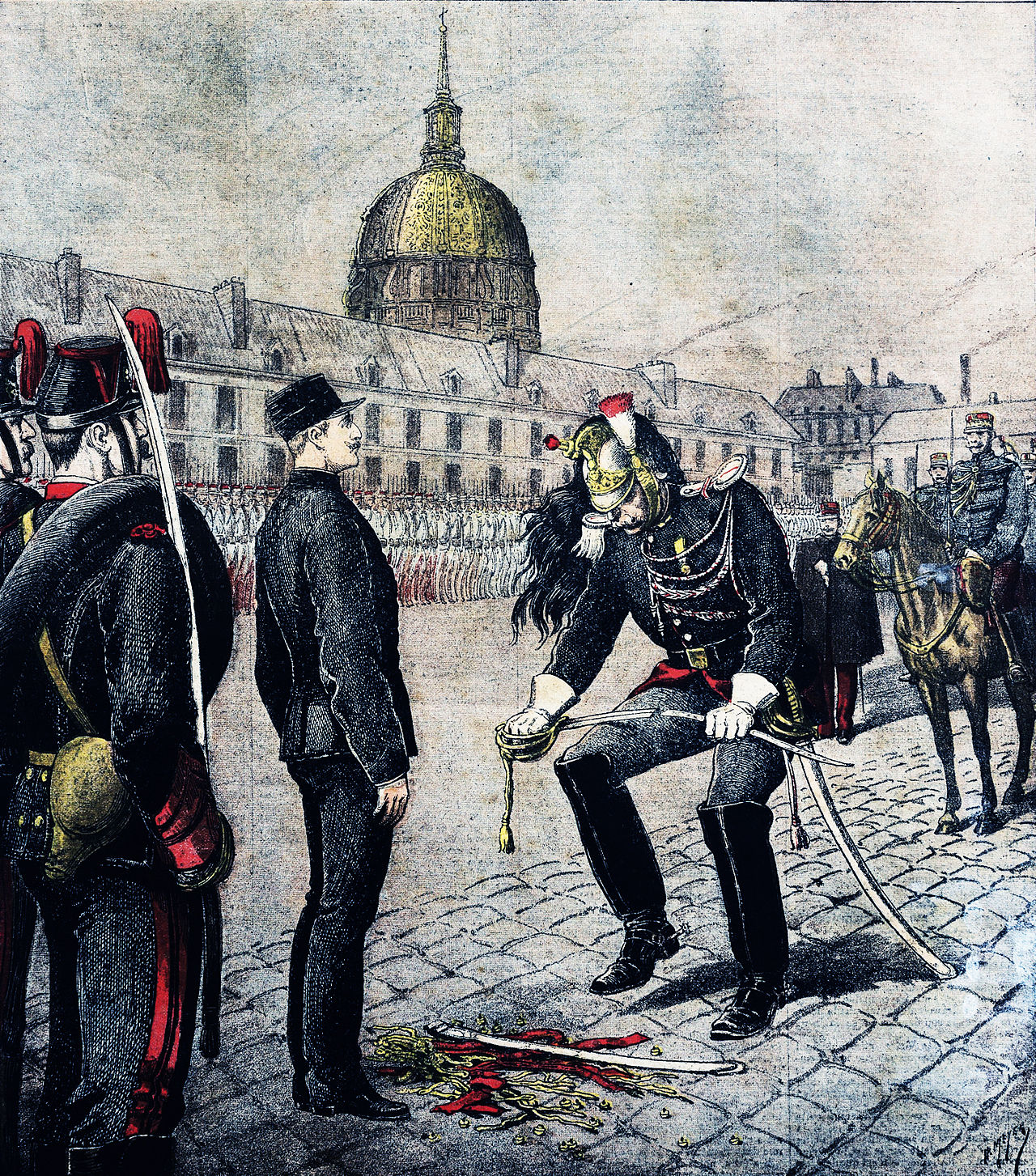
ドレフュス大尉の不名誉な除隊を描いた挿 絵(官位剥奪式で剣を折られるドレフュス=左側)"The traitor: Degradation of Alfred Dreyfus, degradation in the Morland Court of the military school in Paris"
1894 「反ユダヤ系の新聞「自由言 論」がすっぱ抜きで大々的に報じ、ユダヤ人は祖国を裏切る売国奴であり、その売国奴を軍部が庇っていると 論じて、軍部の優柔不断を糾弾」(ウィキ、以下同様)
1895? 「軍上層部は、証拠不十分の まま非公開の軍法会議においてドレフュスに「有罪」の判決を下し、南米の仏領ギアナ沖のディアブル島 (デヴィルズ島)に終身城塞禁錮とした」(ウィキ)
---- 「ドレフュスは初めから無罪を 主張しており、彼の誠実な人柄から無実を確信した妻のリュシーと兄のマテューらは、再審を強く求めると ともに、真犯人の発見に執念を燃や」す。
1896 情報部長に着任したピカール中 佐は、真犯人はハンガリー生まれのフェルディナン・ヴァルザン・エステラージ少 佐であることを突き止めた。しかし、軍上層部はフランス陸軍大臣 のシャルル・シャノワーヌが再審に反対[2]したように軍の権威失墜を恐れてもみ消しを図り、ピカールを脅して左遷、形式的な裁判でエステラージを「無罪」とし釈放した(エステルアジはイギリスに逃亡し、そこで 平穏な生涯を終えた)
1898 「1月13日号の新聞「オー ロール(フランス語版、英語版)」紙は、一面に「私は弾劾する」(フランス語: J'accuse)という大見出しで、作家のエミール・ゾラによる大統領フェリックス・フォール宛ての公開質問状を掲載した。その中でゾラは、軍部を中心 とする不正と虚偽の数々を徹底的に糾弾した。」
---- 「世論は沸騰し、それまで細々 と続けられてきたドレフュス支持の運動が一挙に盛り上る一方、各地でユダヤ人迫害事件が頻発した。ゾラ も名誉毀損で告発されて有罪判決を受け、一時はイギリスへ亡命を余儀なくされた。ドレフュスらの再審を求める勢力はフランス人権同盟[3]を結成して、正 義と真理、自由と平等を唱え、軍国主義批判を展開した。反対派、反ドレフェス派はフランス祖国同盟を結成して国家の尊厳を力説」
---- 「こうして事態はドレフュス個 人の事件から、自由と民主主義・共和制擁護か否かの一大政治闘争の色彩を帯び始め、フランス世論を二分 して展開された。その後、ドレフュスの無実を明らかにする事件(彼の有罪の証拠となったものが、偽造されたものであることが判明)が続いたため、軍部は世 論に押されてやむなく再審軍法会議を開いた。しかし、ドレフュスの有罪は覆されなかった」
1906 「ドレフュスは時の首相により
特赦で釈放されたが、その後も無罪を主張し続け、1906年、ようやく無罪判決を勝ち取って名誉を回復
することとなった。ドレフュスを擁護した民主主義・共和制擁護派が、その後のフランス政治の主導権を握り、第三共和政はようやく相対的安定を確保すること
ができた。」
| The Dreyfus affair
(French: affaire Dreyfus, pronounced [afɛːʁ dʁɛfys]) was a political
scandal that divided the Third French Republic from 1894 until its
resolution in 1906. The scandal began in December 1894 when Captain
Alfred Dreyfus, a 35-year-old Alsatian French artillery officer of
Jewish descent, was wrongfully convicted of treason for communicating
French military secrets to the German Embassy in Paris. He was
sentenced to life imprisonment and sent overseas to the penal colony on
Devil's Island in French Guiana, where he spent the following five
years imprisoned in very harsh conditions. In 1896, evidence came to light—primarily through the investigations of Lieutenant Colonel Georges Picquart, head of counter-espionage—which identified the real culprit as a French Army Major named Ferdinand Walsin Esterhazy. High-ranking military officials suppressed the new evidence, and a military court unanimously acquitted Esterhazy after a trial lasting only two days. The Army laid additional charges against Dreyfus, based on forged documents. Subsequently, writer Émile Zola's open letter J'Accuse...! in the newspaper L'Aurore stoked a growing movement of political support for Dreyfus, putting pressure on the government to reopen the case. In 1899, Dreyfus was returned to France for another trial. The intense political and judicial scandal that ensued divided French society between those who supported Dreyfus, the "Dreyfusards" such as Sarah Bernhardt, Anatole France, Charles Péguy, Henri Poincaré and Georges Clemenceau; and those who condemned him, the "anti-Dreyfusards" such as Édouard Drumont, the director and publisher of the antisemitic newspaper La Libre Parole. The new trial resulted in another conviction and a 10-year sentence, but Dreyfus was pardoned and released. In 1906, Dreyfus was exonerated. After being reinstated as a major in the French Army, he served during the whole of World War I, ending his service with the rank of lieutenant colonel. He died in 1935. The Dreyfus affair came to symbolise modern injustice in the Francophone world;[1] it remains one of the most notable examples of a miscarriage of justice and of antisemitism. The affair divided France into pro-republican, anticlerical Dreyfusards and pro-Army, mostly Catholic anti-Dreyfusards, embittering French politics and encouraging radicalisation.[2] The press played a crucial role in exposing information and in shaping and expressing public opinion on both sides of the conflict. |
ドレフュス事件(仏: affaire Dreyfus、発音:
[afɛ
dʁʁ])は、1894年から1906年の解決まで、フランス第三共和政を二分した政治スキャンダルである。このスキャンダルは1894年12月、ユダヤ
系アルザス人のフランス人砲兵将校アルフレッド・ドレフュス大尉(35歳)が、パリのドイツ大使館にフランスの軍事機密を伝えたとして国家反逆罪で不当に
有罪判決を受けたことから始まった。彼は終身刑を宣告され、海外にあるフランス領ギアナの悪魔の島の流刑地に送られ、その後5年間、非常に過酷な環境で投
獄生活を送った。 1896年、主にスパイ対策責任者ジョルジュ・ピカール中佐の調査によって、真犯人がフェルディナン・ワルサン・エステルハージというフランス陸軍少佐で あることが判明した。軍高官たちはこの新証拠を封じ込め、軍法会議はわずか2日間の裁判の後、満場一致でエステルハージを無罪とした。陸軍は偽造文書に基 づき、ドレフュスに対してさらなる告発を行った。その後、作家エミール・ゾラが『オーロール』紙に発表した公開書簡「告発する...!」が、ドレフュスを 支持する政治的な動きを煽り、ドレフュスの裁判を再開するよう政府に圧力をかけた。 1899年、ドレフュスは再び裁判を受けるためにフランスに戻された。ドレフュスを支持するサラ・ベルナール、アナトール・フランス、シャルル・ペギー、 アンリ・ポアンカレ、ジョルジュ・クレマンソーなどの「ドレフュス派」と、ドレフュスを非難する、反ユダヤ主義的な新聞『ラ・リーブル・パロール』の発行 人であったエドゥアール・ドラモンなどの「反ドレフュス派」にフランス社会は二分された。新たな裁判の結果、ドレフュスは再び有罪判決を受け、10年の刑 期を言い渡されたが、赦免され釈放された。1906年、ドレフュスは釈放された。フランス陸軍少佐に復職したドレフュスは、第一次世界大戦の全期間に従軍 し、中佐の地位でその任務を終えた。1935年に死去した。 ドレフュス事件は、フランス語圏における現代の不公正を象徴する事件となった[1]。ドレフュス事件は、フランスを親共和主義的で反神権的なドレフュス派 と親陸軍的でほとんどがカトリックの反ドレフュス派に分裂させ、フランスの政治を混乱させ、急進化を促した[2]。報道機関は、情報を暴露し、対立する双 方の世論を形成し表現する上で重要な役割を果たした。 |
| Contexts Political In 1894, the Third Republic was twenty-four years old. Although the 16 May Crisis in 1877 had crippled the political influence of both the Bourbon and Orléanist royalists, its ministries continued to be short-lived as the country lurched from crisis to crisis: three years immediately preceding the Dreyfus affair were the near-coup of Georges Boulanger in 1889, the Panama scandals in 1892, and the anarchist threat (reduced by the "villainous laws" of July 1894). The elections of 1893 were focused on the "social question" and resulted in a Republican victory (just under half the seats) against the conservative right, and the reinforcement of the Radicals (about 150 seats) and Socialists (about 50 seats). The opposition of the Radicals and Socialists resulted in a centrist government with policies oriented towards economic protectionism, a certain indifference to social issues, a willingness to break international isolation, the Russian alliance, and development of the colonial empire. These centrist policies resulted in cabinet instability, with some Republican members of the government sometimes aligning with the radicals and some Orléanists aligning with the Legitimists in five successive governments from 1893 to 1896. This instability coincided with an equally unstable presidency: President Sadi Carnot was assassinated on 24 June 1894; his moderate successor Jean Casimir-Perier resigned several months later on 15 January 1895 and was replaced by Félix Faure. Following the failure of the radical government of Léon Bourgeois in 1896, the president appointed Jules Méline as prime minister. His government faced the opposition of the left and of some Republicans (including the Progressive Union) and made sure to keep the support of the right. He sought to appease religious, social, and economic tensions and conducted a fairly conservative policy. He succeeded in improving stability, and it was under this stable government that the Dreyfus affair occurred.[3] Military 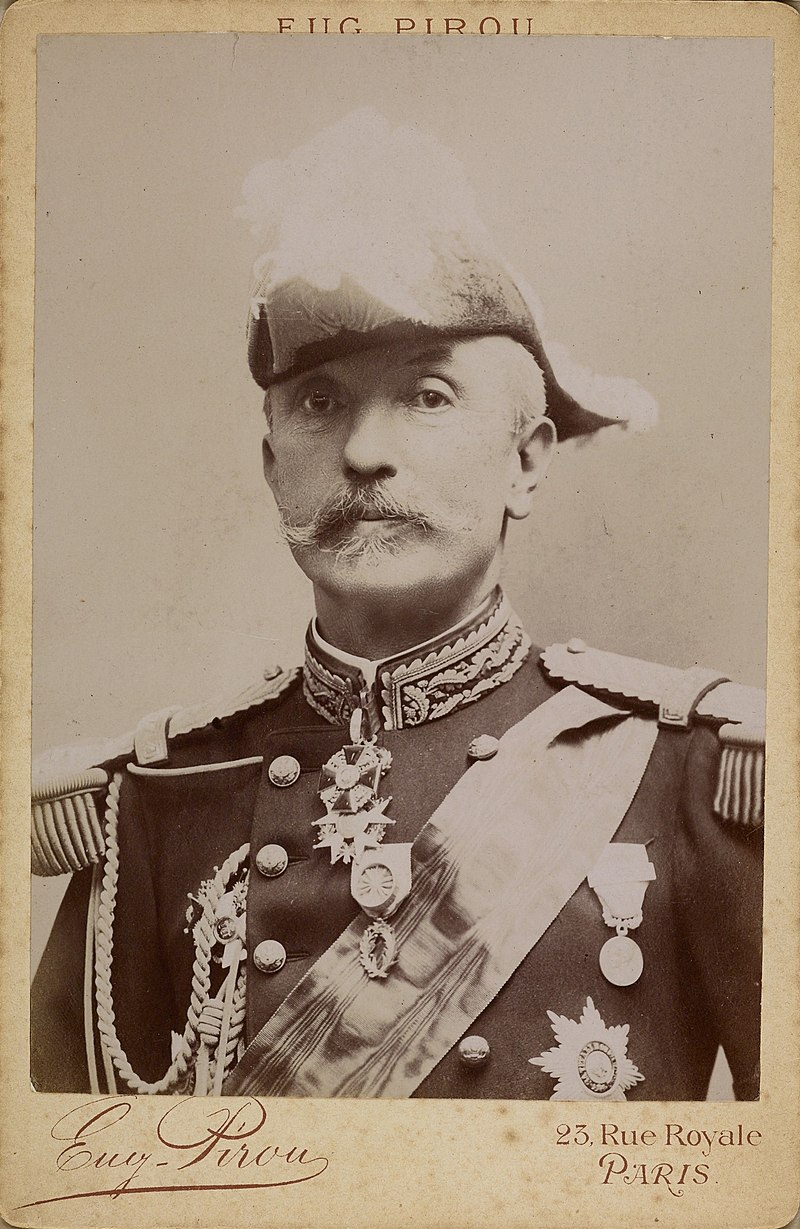 General Raoul Le Mouton de Boisdeffre, architect of the military alliance with Russia The Dreyfus affair occurred in the context of German annexation of Alsace and Moselle, an event that fed the most extreme nationalism. The traumatic defeat of France in 1870 seemed far away, but a vengeful spirit remained. The military required considerable resources to prepare for the next conflict, and it was in this spirit that the Franco-Russian Alliance of 27 August 1892 was signed, although some opponents thought it "against nature".[Note 1] The army had recovered from the defeat, but many of its officers were aristocrats and monarchists. Cult of the flag and contempt for the parliamentary republic prevailed in the army.[4] The Republic celebrated its army; the army ignored the Republic. Over the previous ten years the army had undergone a significant shift resulting from its twofold aim to democratize and modernize. The graduates of the École Polytechnique now competed effectively with officers from the main career path of Saint-Cyr, which caused strife, bitterness, and jealousy among junior officers expecting promotions. The period was also marked by an arms race that primarily affected artillery. There were improvements in heavy artillery (guns of 120 mm and 155 mm, Models 1890 Baquet, new hydropneumatic brakes), but also, and especially, development of the ultra-secret 75mm gun.[5] The operation of military counterintelligence, alias the "Statistics Section" (SR), should be noted. Spying as a tool for secret war was a novelty as an organised activity by governments in the late 19th century. The Statistics Section was created in 1871 but consisted of only a handful of officers and civilians. Its head in 1894 was Lieutenant-Colonel Jean Sandherr, a graduate of Saint-Cyr, an Alsatian from Mulhouse, and a convinced antisemite. Its military mission was clear: to retrieve information about potential enemies of France and to feed them false information. The Statistics Section was supported by the "Secret Affairs" of the Quai d'Orsay at the Ministry of Foreign Affairs, which was headed by a young diplomat, Maurice Paléologue. The arms race created an acute atmosphere of intrigue from 1890 in French counter-espionage. One of the missions of the section was to spy on the German Embassy at Rue de Lille in Paris to thwart any attempt by the French to transmit important information to the Germans. This was especially critical since several cases of espionage had already been featured in the headlines of newspapers, which were fond of sensationalism. In 1890, the archivist Boutonnet was convicted for selling plans of shells that used melinite.[6] The German military attaché in Paris in 1894 was Count Maximilian von Schwartzkoppen, who developed a policy of infiltration that appears to have been effective. In the 1880s Schwartzkoppen had begun an affair with an Italian military attaché, Lieutenant Colonel Count Alessandro Panizzardi.[7] While neither had anything to do with Dreyfus, their intimate and erotic correspondence (e.g. "Don't exhaust yourself with too much buggery."),[8] which was obtained by the authorities, lent an air of truth to other documents that were forged by prosecutors to lend retroactive credibility to Dreyfus's conviction as a spy. Some of these forgeries referred to the real affair between the two officers; in one, Alessandro supposedly informed his lover that if "Dreyfus is brought in for questioning", they must both claim that they "never had any dealings with that Jew. ... Clearly, no one can ever know what happened with him."[9] The letters, real and fake, provided a convenient excuse for placing the entire Dreyfus dossier under seal, given that exposure of the liaison would have 'dishonoured' Germany and Italy's military and compromised diplomatic relations. As homosexuality was, like Judaism, then often perceived as a sign of national degeneration, recent historians have suggested that combining them to inflate the scandal may have shaped the prosecution strategy.[10][11] Since early 1894, the Statistics Section had investigated traffic in master plans for Nice and the Meuse conducted by an officer whom the Germans and Italians nicknamed Dubois. This is what led to the origins of the Dreyfus affair. Social 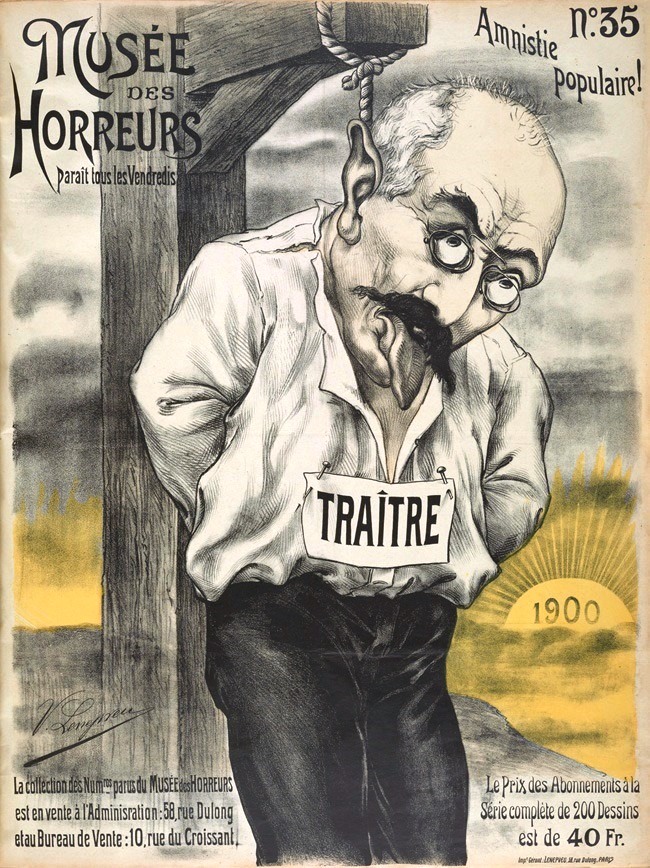 No. 35 Amnistie populaire of the Musée des Horreurs depicts the hanged corpse of an antisemitic caricature of Alfred Dreyfus.[12] The social context was marked by the rise of nationalism and antisemitism. The growth of antisemitism, virulent since the publication of Jewish France by Édouard Drumont in 1886 (150,000 copies in the first year), went hand in hand with the rise of clericalism. Tensions were high in all strata of society, fueled by an influential press, which was virtually free to write and disseminate any information even if offensive or defamatory. Legal risks were limited if the target was a private person. Antisemitism did not spare the military, which practised hidden discrimination with the "cote d'amour" (a subjective assessment of personal acceptability) system of irrational grading, encountered by Dreyfus in his application to the Bourges School.[13] However, while prejudices of this nature undoubtedly existed within the confines of the General Staff, the French Army as a whole was relatively open to individual talent. At the time of the Dreyfus affair there were an estimated 300 Jewish officers in the army (about 3 per cent of the total), of whom ten were generals.[14] The popularity of the duel using sword or small pistol, sometimes causing death, bore witness to the tensions of the period. When a series of press articles in La Libre Parole[15] accused Jewish officers of "betraying their birth", the officers challenged the editors. Captain Crémieu-Foa, a Jewish Alsatian graduated from the Ecole Polytechnique, fought unsuccessfully against Drumont[16] and against M. de Lamase, who was the author of the articles. Captain Mayer, another Jewish officer, was killed by the Marquis de Morès, a friend of Drumont, in another duel. Hatred of Jews was now public and violent, driven by a firebrand (Drumont) who demonized the Jewish presence in France. Jews in metropolitan France in 1895 numbered about 80,000 (40,000 in Paris alone), who were highly integrated into society; an additional 45,000 Jews lived in Algeria. The launch of La Libre Parole with a circulation estimated at 200,000 copies in 1892,[17] allowed Drumont to expand his audience to a popular readership already enticed by the boulangiste adventure in the past. The antisemitism circulated by La Libre Parole, as well as by L'Éclair, Le Petit Journal, La Patrie, L'Intransigeant and La Croix, drew on antisemitic roots in certain Catholic circles.[18] Publications remarking on the Dreyfus affair often reinforced antisemitic sentiments, language and imagery. The Musée des Horreurs was a collection of anti-Dreyfus posters illustrated by Victor Lenepveu during the Dreyfus affair. Lenepveu caricatured "prominent Jews, Dreyfus supporters, and Republican statesman".[19] No. 35 Amnistie populaire depicts the corpse of Dreyfus himself as it dangles from a noose. Large noses, money, and Lenepveu's general tendency to illustrate subjects with bodies of animals likely contributed to the dissemination of antisemitism in French popular culture.[12] |
コンテクスト 政治 1894年、第三共和政は24歳になっていた。ドレフュス事件の直前の3年間は、1889年のジョルジュ・ブーランジェのクーデター寸前、1892年のパ ナマ疑獄、無政府主義の脅威(1894年7月の「悪法」によって減少)であった。1893年の選挙は「社会問題」に焦点が当てられ、保守右派に対する共和 党の勝利(半数弱の議席)、急進派(約150議席)と社会党(約50議席)の強化という結果となった。 急進派と社会党の反対により、経済保護主義、社会問題へのある種の無関心、国際的孤立の解消への意欲、ロシア同盟、植民地帝国の発展などを志向する中道派 政権が誕生した。こうした中道主義的な政策は内閣の不安定化を招き、1893年から1896年までの5回の連続政権では、共和党議員の一部が急進派と、オ ルレアン派の一部が正統派と手を組むこともあった。この不安定さは、同様に不安定な大統領職と重なった: サディ・カルノ大統領は1894年6月24日に暗殺され、穏健派の後継者ジャン・カシミール=ペリエは数ヵ月後の1895年1月15日に辞任し、フェリッ クス・フォールが後任となった。 1896年に急進派のレオン・ブルジョワ政権が失敗すると、大統領はジュール・メリーヌを首相に任命した。彼の政権は、左派と一部の共和党(進歩同盟を含 む)の反対に直面し、右派の支持を維持することに努めた。彼は宗教的、社会的、経済的緊張を和らげようと努め、かなり保守的な政策をとった。彼は安定を高 めることに成功し、この安定した政権の下でドレフュス事件が起こった[3]。 軍事  ロシアとの軍事同盟の立役者、ラウル・ル・ムートン・ド・ボワデフル将軍 ドレフュス事件は、ドイツによるアルザスとモーゼルの併合という、極端な国民主義を煽る出来事の中で起こった。1870年のフランス敗戦のトラウマははるか彼方にあるように思えたが、復讐心は残っていた。 軍部は次の紛争に備えるために多大な資源を必要とし、1892年8月27日の日露同盟はこの精神に基づいて調印されたが、「自然に反する」と考える反対派 もいた[注釈 1]。軍は敗戦から回復していたが、将校の多くは貴族や君主主義者だった。共和国は軍隊を称え、軍隊は共和国を無視した。 それまでの10年間で、軍隊は民主化と近代化という2つの目的から大きな変化を遂げた。エコール・ポリテクニークの卒業生たちは、サン・シルの主要なキャ リアパスから来た将校と効果的に競争するようになり、昇進を期待する下級将校たちの間に争い、恨み、嫉妬を引き起こした。この時期は、主に砲兵に影響を与 えた軍拡競争も顕著であった。重砲の改良(120ミリ砲と155ミリ砲、1890年型バケ、新型水空圧式ブレーキ)だけでなく、特に超極秘の75ミリ砲の 開発も行われた[5]。 軍事防諜、別名「統計課」(SR)の活動にも注目すべきである。秘密戦争の道具としてのスパイ活動は、19世紀後半には政府による組織的な活動としては目 新しいものであった。統計課は1871年に創設されたが、ほんの一握りの将校と民間人で構成されていた。1894年当時の責任者はジャン・サンヘル中佐 で、サン・シールを卒業し、ミュルーズ出身のアルザス人で、確信犯的な反ユダヤ主義者であった。その軍事的使命は明確であった。フランスの潜在的な敵に関 する情報を入手し、彼らに偽の情報を流すことであった。統計課は、若い外交官モーリス・パレオログが責任者を務める外務省オルセー研究所の「秘密部」に支 えられていた。 軍拡競争は、1890年以降、フランスの対スパイ活動における熾烈な陰謀の雰囲気を生み出した。この課の任務のひとつは、パリのリール通りにあるドイツ大 使館をスパイして、フランスがドイツに重要な情報を伝えようとする企てを阻止することだった。センセーショナリズムを好む新聞の見出しには、すでにいくつ かのスパイ事件が取り上げられていたため、これは特に重要な任務であった。1890年には、メリナイトを使用した砲弾の設計図を販売した罪で、記録係のブ トネが有罪判決を受けた[6]。 1894年にパリに駐在したドイツ軍のアタッシェはマクシミリアン・フォン・シュバルツコッペン伯爵であり、彼は効果的であったと思われる潜入政策を展開 した。1880年代、シュバルツコッペンはイタリア軍アタッシェのアレッサンドロ・パニツァルディ伯爵中佐と関係を持ち始めていた[7]。どちらもドレ フュスとは何の関係もなかったが、当局が入手した二人の親密でエロティックな書簡(例えば、「あまり盗撮で疲弊するなよ」[8])は、ドレフュスのスパイ としての有罪判決に遡及的な信憑性を持たせるために検察が偽造した他の文書に真実味を与えていた。アレッサンドロは恋人に、「ドレフュスが尋問のために連 行されたら」、二人とも「あのユダヤ人とは何の関係もない」と主張しなければならないと告げたとされる。明らかに、彼と何があったのか、誰も知ることはで きない」[9]。 この手紙は本物であろうと偽物であろうと、ドレフュスとの関係を暴露すればドイツとイタリアの軍部の「名誉を傷つけ」、外交関係を危うくすることになるた め、ドレフュス文書全体を封印するための都合のよい口実となった。当時、同性愛はユダヤ教と同様、しばしば国民的堕落の兆候として認識されていたため、最 近の歴史家は、スキャンダルを煽るために両者を組み合わせたことが起訴戦略を形成した可能性があると指摘している[10][11]。 1894年初頭から、統計課は、ドイツ人とイタリア人がデュボワとあだ名した将校が行ったニースとムーズ川のマスタープランの交通量を調査していた。これがドレフュス事件の発端となった。 社会  ホレール美術館のNo.35 Amnistie populaireには、反ユダヤ風刺画のアルフレッド・ドレフュスの絞首刑死体が描かれている[12]。 社会的背景には、ナショナリズムと反ユダヤ主義の台頭があった。1886年にエドゥアール・ドリュモンが『ユダヤ人のフランス』を出版して以来、反ユダヤ 主義は猛威を振るい(最初の年に15万部)、聖職者主義の台頭と密接に関係していた。社会のあらゆる階層で緊張が高まり、影響力のある報道機関がそれに拍 車をかけ、たとえ攻撃的で中傷的であっても、どんな情報でも事実上自由に書き、広めることができた。標的が個人であれば、法的リスクは限られていた。 ドレフュスがブールジュ学校を受験した際に遭遇した「コート・ダムール」(個人的な可否の主観的評価)という不合理な等級制度によって、隠れた差別が行わ れていたのである。ドレフュス事件当時、陸軍には推定300人(全体の約3パーセント)のユダヤ人将校がおり、そのうち10人が将官であった[14]。 剣や小型のピストルを使った決闘の人気は、時には死を招くこともあり、当時の緊張を物語っていた。La Libre Parole』[15]に掲載された一連の記事がユダヤ人将校を「自分たちの出生を裏切っている」と非難したとき、将校たちは編集者に異議を申し立てた。 エコール・ポリテクニークを卒業したユダヤ系アルザス人のクレミュー=フォア大尉は、ドラモン[16]および記事の著者であるド・ラマセM.と争って失敗 した。もう一人のユダヤ人将校メイヤー大尉は、ドラモンの友人であったモレス侯爵に決闘で殺された。 フランスにおけるユダヤ人の存在を悪者扱いする火付け役(ドラモン)によって、ユダヤ人に対する憎悪は今や公然かつ暴力的になっていた。1895年当時、 フランス首都圏のユダヤ人は約8万人(パリだけで4万人)で、高度に社会に溶け込んでおり、さらに4万5千人のユダヤ人がアルジェリアに住んでいた。 1892年に発行部数20万部と推定される『La Libre Parole』[17]が創刊されたことで、ドラモンは、過去にすでにブーランジェの冒険に魅了されていた大衆読者に読者を広げることができた。ラ・リー ブル・パロール』や『レクレール』、『ル・プティ・ジャーナル』、『ラ・パトリエ』、『ラントランシジャン』、『ラ・クロワ』によって流布された反ユダヤ 主義は、ある種のカトリック界における反ユダヤ主義の根源を引くものであった[18]。 ドレフュス事件に言及した出版物は、しばしば反ユダヤ的な感情、言葉、イメージを強化した。Musée des Horreurs』は、ドレフュス事件の最中にヴィクトール・ルヌプーヴーが描いた反ドレフュスポスターのコレクションであった。ルネプーヴーは「著名な ユダヤ人、ドレフュス支持者、共和党の政治家」を風刺画で描いた[19]。No.35 Amnistie populaireには、ドレフュス自身の死体が縄で吊るされている様子が描かれている。大きな鼻、金銭、動物の死体を題材にしたルネプヴーの一般的な傾 向は、フランスの大衆文化における反ユダヤ主義の普及に貢献したと思われる[12]。 |
| Origins of the case and the trial of 1894 Main article: Investigation and arrest of Alfred Dreyfus 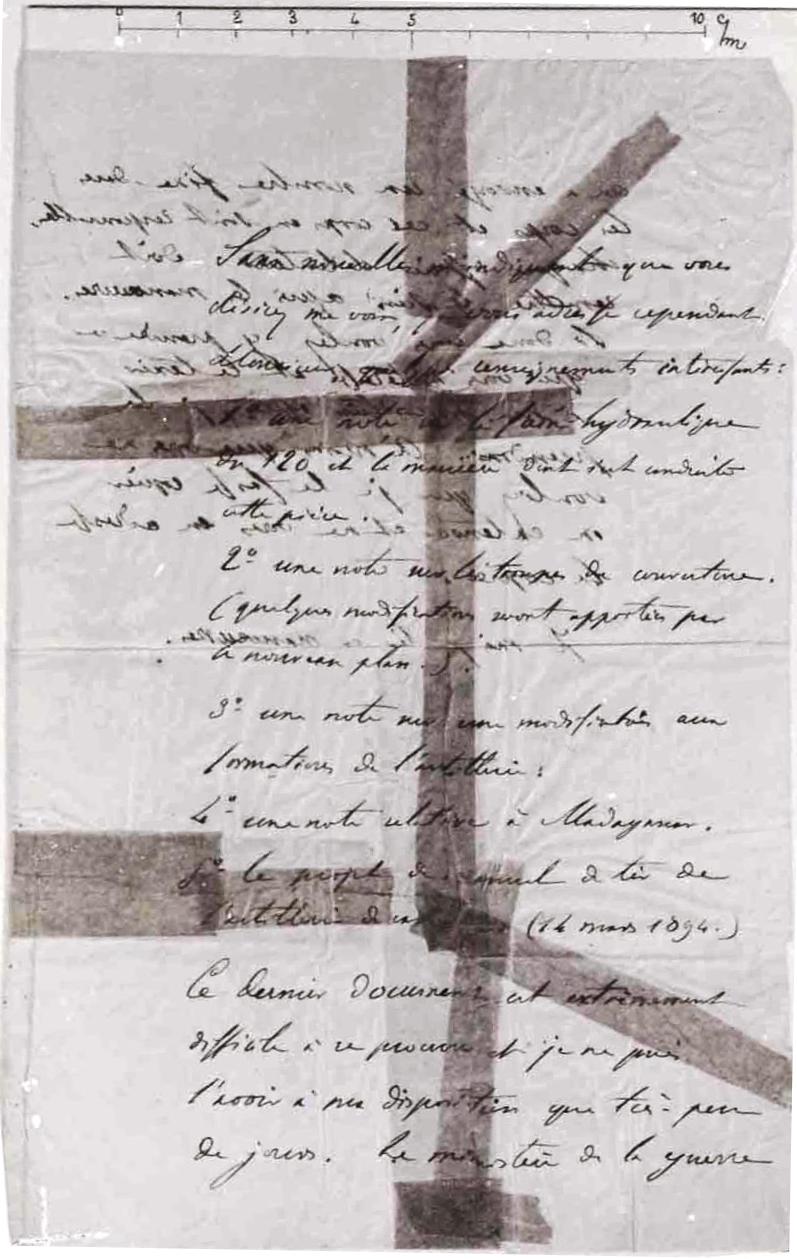 Photograph of the bordereau dated 13 October 1894. The original disappeared in 1940. Discovery of the "bordereau" The staff of the Military Intelligence Service (SR) worked around the clock[20] to spy on the German Embassy in Paris. They had managed to get a French housekeeper named "Madame Bastian" hired to work in the building and spy on the Germans. In September 1894, she found a torn-up note[21] which she handed over to her employers at the Military Intelligence Service. This note later became known as "the bordereau".[Note 2] This piece of paper, torn into six large pieces,[22] unsigned and undated, was addressed to the German military attaché stationed at the German Embassy, Maximilian von Schwartzkoppen. It stated that confidential French military documents regarding the newly developed "hydraulic brake of 120, and the way this gun has worked"[23][24] were about to be sent to a foreign power. The search for the author of the bordereau 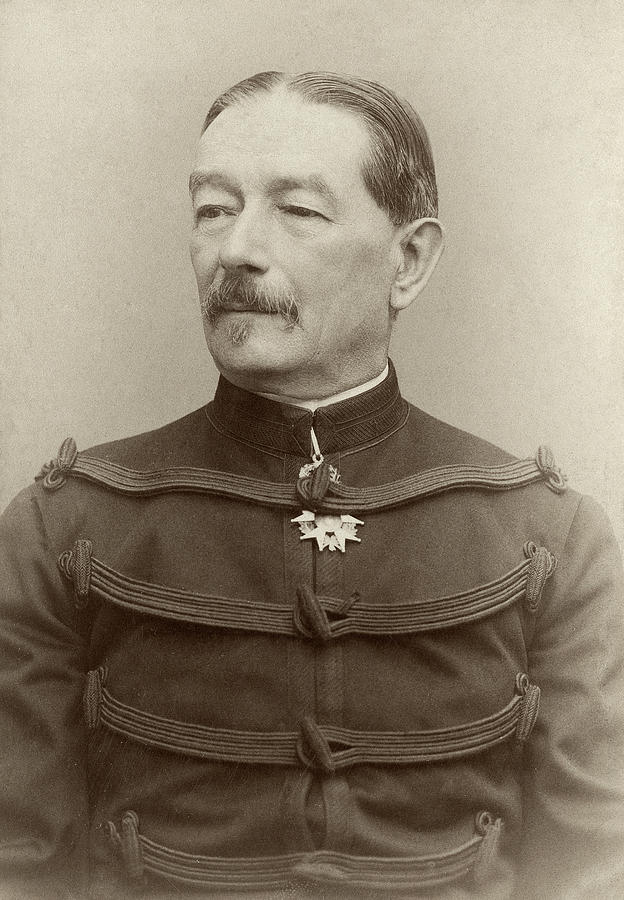 General Auguste Mercier, Minister of War in 1894 This catch seemed of sufficient importance for the head of the "Statistical Section",[25] the Mulhousian[26] Jean Sandherr, to inform the Minister of War, General Auguste Mercier. In fact the SR suspected that there had been leaks since the beginning of 1894 and had been trying to find the perpetrator. The minister had been harshly attacked in the press for his actions, which were deemed incompetent,[27] and appears to have sought an opportunity to enhance his image.[28][29] He immediately initiated two secret investigations, one administrative and one judicial. To find the culprit, using simple though crude reasoning,[30] the circle of the search was arbitrarily restricted to suspects posted to, or former employees of, the General Staff – necessarily a trainee artillery[Note 3] officer.[Note 4] The ideal culprit was identified: Captain Alfred Dreyfus, a graduate of the École polytechnique and an artillery officer, of the Jewish faith and of Alsatian origin, coming from the republican meritocracy.[31] At the beginning of the case, the emphasis was rather on the Alsatian origins of Dreyfus than on his religion. These origins were not, however, exceptional because these officers were favoured by France for their knowledge of the German language and culture.[32][33] There was also antisemitism in the offices of the General Staff,[34] and it fast became central to the affair by filling in the credibility gaps in the preliminary enquiry.[30] In particular, Dreyfus was at that time the only Jewish officer to be recently passed by the General Staff. In fact, the reputation[35] of Dreyfus as a cold and withdrawn or even haughty character, as well as his "curiosity", worked strongly against him. These traits of character, some false, others natural, made the charges plausible by turning the most ordinary acts of everyday life in the ministry into proof of espionage. From the beginning a biased and one-sided multiplication of errors led the State to a false position. This was present throughout the affair, where irrationality prevailed over the positivism in vogue in that period:[36] From this first hour the phenomenon occurred that will dominate the whole affair. It is no longer controlled by facts and circumstances carefully examined which will constitute a belief; it is the irresistible cavalier conviction which distorts the facts and beliefs. — Joseph Reinach Expertise in writing 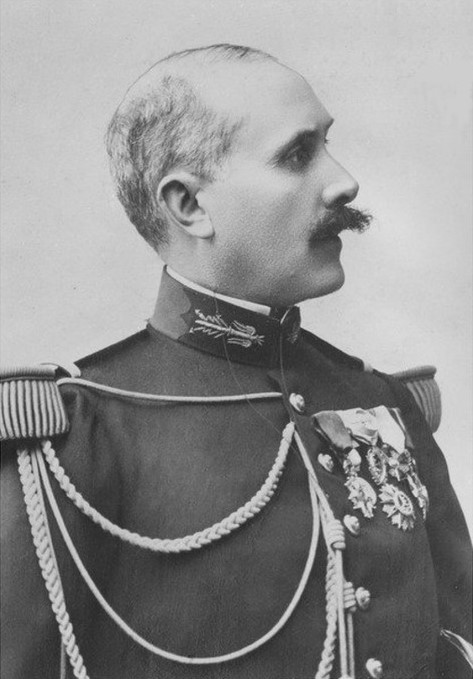 Major du Paty de Clam, head of investigation, arrested Captain Dreyfus. To condemn Dreyfus, the writing on the bordereau had to be compared to that of the Captain. There was nobody competent to analyse the writing on the General Staff.[37] Then Major du Paty de Clam[38][39] entered the scene: an eccentric man who prided himself on being an expert in graphology. On being shown some letters by Dreyfus and the bordereau on 5 October, du Paty concluded immediately who had written the two writings. After a day of additional work he provided a report that, despite some differences, the similarities were sufficient to warrant an investigation. Dreyfus was therefore "the probable author" of the bordereau in the eyes of the General Staff.[40] 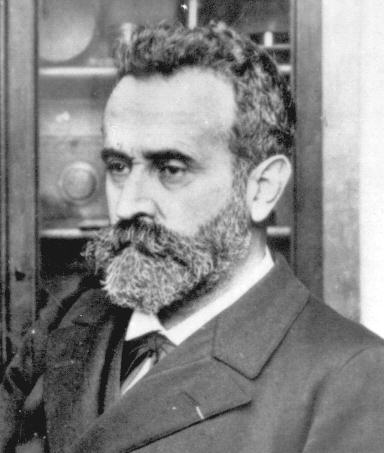 Alphonse Bertillon was not a handwriting expert, but he invented the theory of "autoforgery". General Mercier believed he had the guilty party, but he exaggerated the value of the affair, which took on the status of an affair of state during the week preceding the arrest of Dreyfus. The Minister did consult and inform all the authorities of the State,[41] yet despite prudent counsel and courageous objections expressed by Gabriel Hanotaux in the Council of Ministers[42] he decided to pursue it.[43] Du Paty de Clam was appointed Judicial Police Officer to lead an official investigation. Meanwhile, several parallel sources of information were opening up, some on the personality of Dreyfus, others to ensure the truth of the identity of the author of the bordereau. The expert[Note 5] Gobert was not convinced and found many differences. He even wrote that "the nature of the writing on the bordereau excludes disguised handwriting".[44] Disappointed, Mercier then called in Alphonse Bertillon, the inventor of forensic anthropometry but no handwriting expert. He was initially no more positive than Gobert but he did not exclude the possibility of its being the writing of Dreyfus.[45] Later, under pressure from the military,[46] he argued that Dreyfus had autocopied it and developed his theory of "autoforgery". The arrest On 13 October 1894, without any tangible evidence and with an empty file, General Mercier summoned Captain Dreyfus for a general inspection in "bourgeois clothing", i.e. in civilian clothes. The purpose of the General Staff was to obtain the perfect proof under French law: a confession. That confession was to be obtained by surprise – by dictating a letter based on the bordereau[47][48] to reveal his guilt. On the morning of 15 October 1894, Captain Dreyfus underwent this ordeal but admitted nothing. Du Paty even tried to suggest suicide by placing a revolver in front of Dreyfus, but he refused to take his life, saying he "wanted to live to establish his innocence". The hopes of the military were crushed. Nevertheless Du Paty de Clam still arrested the captain,[49] accused him of conspiring with the enemy, and told him that he would be brought before a court-martial. Dreyfus was imprisoned at the Cherche-Midi prison in Paris.[50] The enquiry and the first military court  Cover of Le Petit Journal, 20 January 1895 (illustration by Fortuné Méaulle after Lionel Royer) Mrs. Dreyfus was informed of the arrest the same day by a police raid to search their apartment. She was terrorized by Du Paty, who ordered her to keep the arrest of her husband secret and even said, "One word, one single word and it will be a European war!"[51] Illegally,[52] Dreyfus was placed in solitary confinement in prison, where Du Paty interrogated him day and night in order to obtain a confession, which failed. The captain was morally supported by the first Dreyfusard, Major Forzinetti, commandant of the military prisons of Paris. On 29 October 1894, the affair was revealed in an article in La Libre Parole, the antisemitic newspaper owned by Édouard Drumont. This marked the beginning of a very brutal press campaign until the trial. This event put the affair in the field of antisemitism where it remained until its conclusion.[53] On 1 November 1894, Alfred's brother, Mathieu Dreyfus, became aware of the arrest after being called urgently to Paris. He became the architect of the arduous fight for the liberation of his brother.[54] Without hesitation, he began looking for a lawyer, and retained the distinguished criminal lawyer Edgar Demange.[55] The enquiry On 3 November 1894, General Saussier, the Military governor of Paris, reluctantly[56] gave the order for an enquiry. He had the power to stop the process but did not, perhaps because of an exaggerated confidence in military justice.[57] Major Besson d'Ormescheville, the recorder for the Military Court, wrote an indictment in which "moral elements" of the charge (which gossiped about the habits of Dreyfus and his alleged attendance at "gambling circles", his knowledge of German, and his "remarkable memory") were developed more extensively than the "material elements",[Note 6] which are rarely seen in the charge: "This is a proof of guilt because Dreyfus made everything disappear". The complete lack of neutrality of the indictment led to Émile Zola calling it a "monument of bias".[58] After the news broke on Dreyfus' arrest, many journalists flocked to the story and flooded the story with speculations and accusations. The renowned journalist and antisemitic agitator Edouard Drumont wrote in his publication on November 3, 1894, "What a terrible lesson, this disgraceful treason of the Jew Dreyfus." On 4 December 1894, Dreyfus was referred to the first Military Court with this dossier. The secrecy was lifted and Demange could access the file for the first time. After reading it the lawyer had absolute confidence, as he saw the emptiness of the prosecution's case.[59] The prosecution rested completely on the writing on a single piece of paper, the bordereau, on which experts disagreed, and on vague indirect testimonies. The trial: "Closed Court or War!" 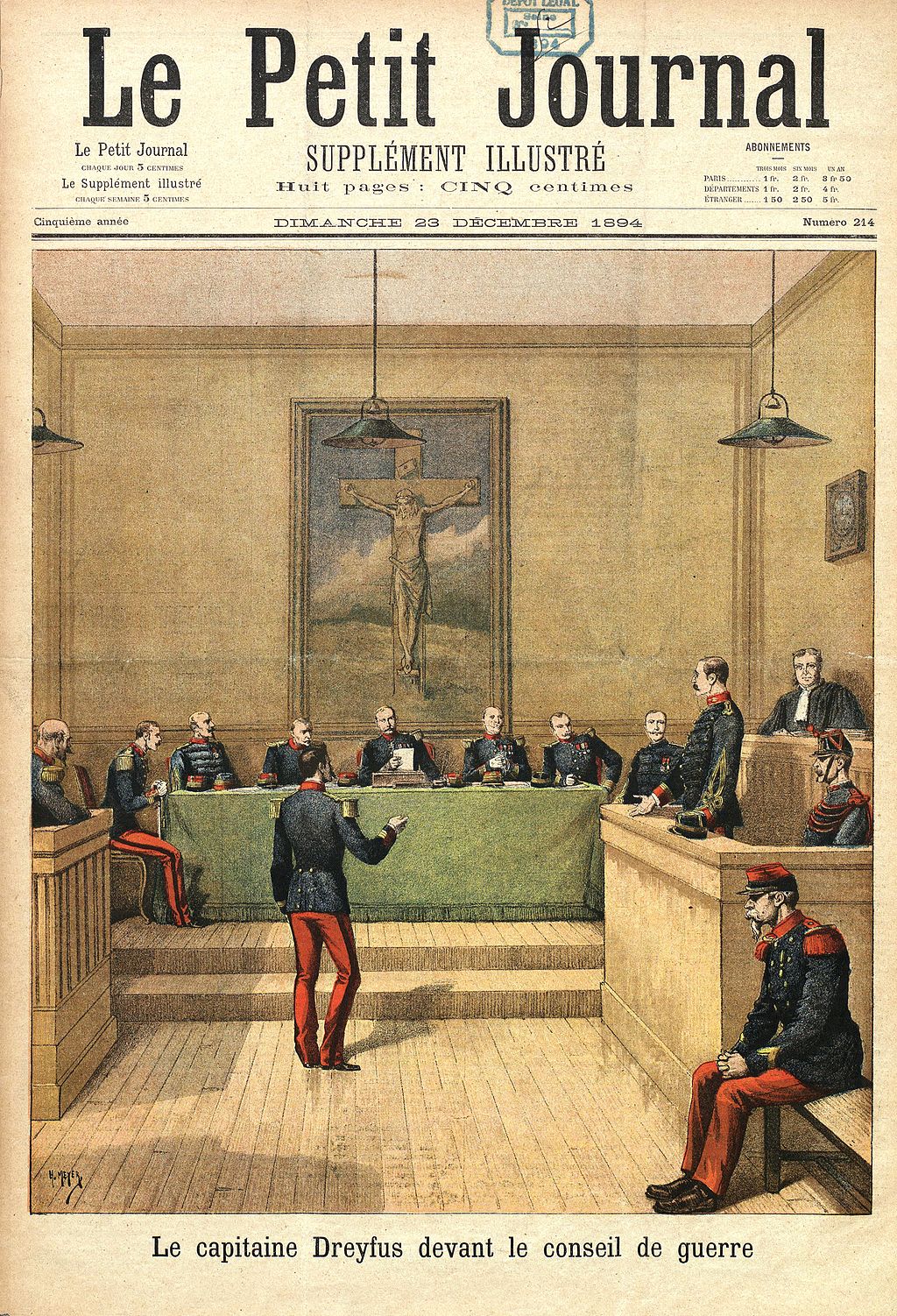 From Le Petit Journal (23 December 1894) During the two months before the trial, the press went wild. La Libre Parole, L'Autorité, Le Journal, and Le Temps described the supposed life of Dreyfus through lies and bad fiction.[60] This was also an opportunity for extreme headlines from La Libre Parole and La Croix to justify their previous campaigns against the presence of Jews in the army on the theme "You have been told!"[61] This long delay above all enabled the General Staff to prepare public opinion and to put indirect pressure on the judges.[62] On 8 November 1894, General Mercier declared Dreyfus guilty in an interview with Le Figaro.[63] He repeated himself on 29 November 1894 in an article by Arthur Meyer in Le Gaulois, which in fact condemned the indictment against Dreyfus and asked, "How much freedom will the military court have to judge the defendant?"[64] The jousting of the columnists took place within a broader debate about the issue of a closed court. For Ranc and Cassagnac, who represented the majority of the press, the closed court was a low manoeuvre to enable the acquittal of Dreyfus, "because the minister is a coward". The proof was "that he grovels before the Prussians" by agreeing to publish the denials of the German ambassador in Paris.[65] In other newspapers, such as L'Éclair on 13 December 1894: "the closed court is necessary to avoid a casus belli"; while for Judet in Le Petit Journal of 18 December: "the closed court is our impregnable refuge against Germany"; or in La Croix the same day: it must be "the most absolute closed court".[66] The trial opened on 19 December 1894 at one o'clock[67] and a closed court was immediately pronounced. This closed court was not legally consistent since Major Picquart and Prefect Louis Lépine were present at certain proceedings in violation of the law. The closed court allowed the military to avoid disclosing the emptiness of their evidence to the public and to stifle debate.[68][69] As expected, the emptiness of their case appeared clearly during the hearings. Detailed discussions on the bordereau showed that Captain Dreyfus could not be the author.[70][71] At the same time the accused himself protested his innocence and defended himself point by point with energy and logic.[72] Moreover, his statements were supported by a dozen defense witnesses. Finally, the absence of motive for the crime was a serious thorn in the prosecution case. Dreyfus was indeed a very patriotic officer highly rated by his superiors, very rich and with no tangible reason to betray France.[73] The fact of Dreyfus's Jewishness, which was used extensively by the right-wing press, was not openly presented in court. Alphonse Bertillon, an eccentric criminologist who was not an expert in handwriting, was presented as a scholar of the first importance. He advanced the theory of "autoforgery" during the trial and accused Dreyfus of imitating his own handwriting, explaining the differences in writing by using extracts of writing from his brother Matthieu and his wife Lucie. This theory, although later regarded as bizarre and astonishing, seems to have had some effect on the judges.[74] In addition, Major Hubert-Joseph Henry, deputy head of the SR and discoverer of the bordereau, made a theatrical statement in open court.[75] He argued that leaks betraying the General Staff had been suspected to exist since February 1894 and that "a respectable person" accused Captain Dreyfus. He swore on oath that the traitor was Dreyfus, pointing to the crucifix hanging on the wall of the court.[76] Dreyfus was apoplectic with rage and demanded to be confronted with his anonymous accuser, which was rejected by the General Staff. The incident had an undeniable effect on the court, which was composed of seven officers who were both judges and jury. However, the outcome of the trial remained uncertain. The conviction of the judges had been shaken by the firm and logical answers of the accused.[77] The judges took leave to deliberate, but the General Staff still had a card in hand to tip the balance decisively against Dreyfus. Transmission of a secret dossier to the judges 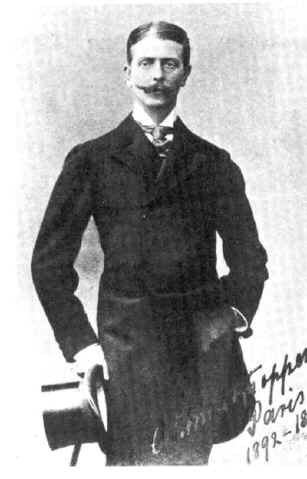 Max von Schwartzkoppen always claimed never to have known Dreyfus. Military witnesses at the trial alerted high command about the risk of acquittal. For this eventuality the Statistics Section had prepared a file containing, in principle, four "absolute" proofs of the guilt of Captain Dreyfus accompanied by an explanatory note. The contents of this secret file remained uncertain until 2013, when they were released by the French Ministry of Defence.[78][79] Recent research indicates the existence of numbering which suggests the presence of a dozen documents. Among these letters were some of an erotic homosexual nature (the Davignon letter among others) raising the question of the tainted methods of the Statistics Section and the objective of their choice of documents.[80] The secret file was illegally submitted at the beginning of the deliberations by the President of the Military Court, Colonel Émilien Maurel, by order of the Minister of War, General Mercier.[81] Later at the Rennes trial of 1899, General Mercier explained (falsely) the nature of the prohibited disclosure of the documents submitted in the courtroom. This file contained, in addition to letters without much interest, some of which were falsified, a piece known as the "Scoundrel D ...".[82] It was a letter from the German military attaché, Maximilian von Schwartzkoppen, to the Italian military attaché, Lieutenant Colonel Alessandro Panizzardi, intercepted by the SR. The letter was supposed to accuse Dreyfus definitively since, according to his accusers, it was signed with the initial of his name.[83] In reality, the Statistics Section knew that the letter could not be attributed to Dreyfus and if it was, it was with criminal intent.[84] Colonel Maurel confirmed in the second Dreyfus trial that the secret documents were not used to win the support of the judges of the Military Court. He contradicted himself, however, by saying that he read only one document, "which was enough".[85] Conviction, degradation, and deportation  Dreyfus's officer stripes, ripped off as a symbol of treason – Museum of Jewish Art and History On 22 December 1894, after several hours of deliberation, the verdict was reached. Seven judges unanimously convicted Alfred Dreyfus of collusion with a foreign power, to the maximum penalty under section 76 of the Criminal Code: permanent exile in a walled fortification (prison), the cancellation of his army rank and military degradation, also known as cashiering. Dreyfus was not sentenced to death, as it had been abolished for political crimes since 1848. For the authorities, the press and the public, doubts had been dispelled by the trial and his guilt was certain. Right and left regretted the abolition of the death penalty for such a crime. Antisemitism peaked in the press and occurred in areas so far spared.[86] Socialist leader Jean Jaurès regretted the lightness of the sentence in an address to the Chamber of Deputies and wrote, "A soldier has been sentenced to death and executed for throwing a button in the face of his corporal. So why leave this miserable traitor alive?" Radical Republican Georges Clemenceau in La Justice made a similar comment.[87] On 5 January 1895, the ceremony of degradation took place in the Morlan Court of the Military School in Paris. While the drums rolled, Dreyfus was accompanied by four artillery officers, who brought him before an officer of the state who read the judgment. A Republican Guard adjutant tore off his badges, thin strips of gold, his stripes, cuffs and sleeves of his jacket. As he was paraded throughout the streets, the crowd chanted "Death to Judas, death to the Jew." Witnesses report the dignity of Dreyfus, who continued to maintain his innocence while raising his arms: "Innocent, Innocent! Vive la France! Long live the Army". The Adjutant broke his sword on his knee and then the condemned Dreyfus marched at a slow pace in front of his former companions.[88] An event known as "the legend of the confession" took place before the degradation. In the van that brought him to the military school, Dreyfus is said to have confided his treachery to Captain Lebrun-Renault.[89][90] It appears that this was merely self-promotion by the captain of the Republican Guard, and that in reality Dreyfus had made no admission. Due to the affair's being related to national security, the prisoner was then held in solitary confinement in a cell awaiting transfer. On 17 January 1895, he was transferred to the prison on Île de Ré where he was held for over a month. He had the right to see his wife twice a week in a long room, each of them at one end, with the director of the prison in the middle.[91]  Dreyfus's Hut on Devil's Island in French Guiana At the last minute, at the initiative of General Mercier, a law was passed on 9 February 1895, restoring the Îles du Salut in French Guiana, as a place of fortified deportation so that Dreyfus was not sent to Ducos, New Caledonia.[citation needed] Indeed, during the deportation of Adjutant Lucien Châtelain, sentenced for conspiring with the enemy in 1888, the facilities did not provide the required conditions of confinement and detention conditions were considered too soft. On 21 February 1895, Dreyfus embarked on the ship Ville de Saint-Nazaire. The next day the ship sailed for French Guiana. 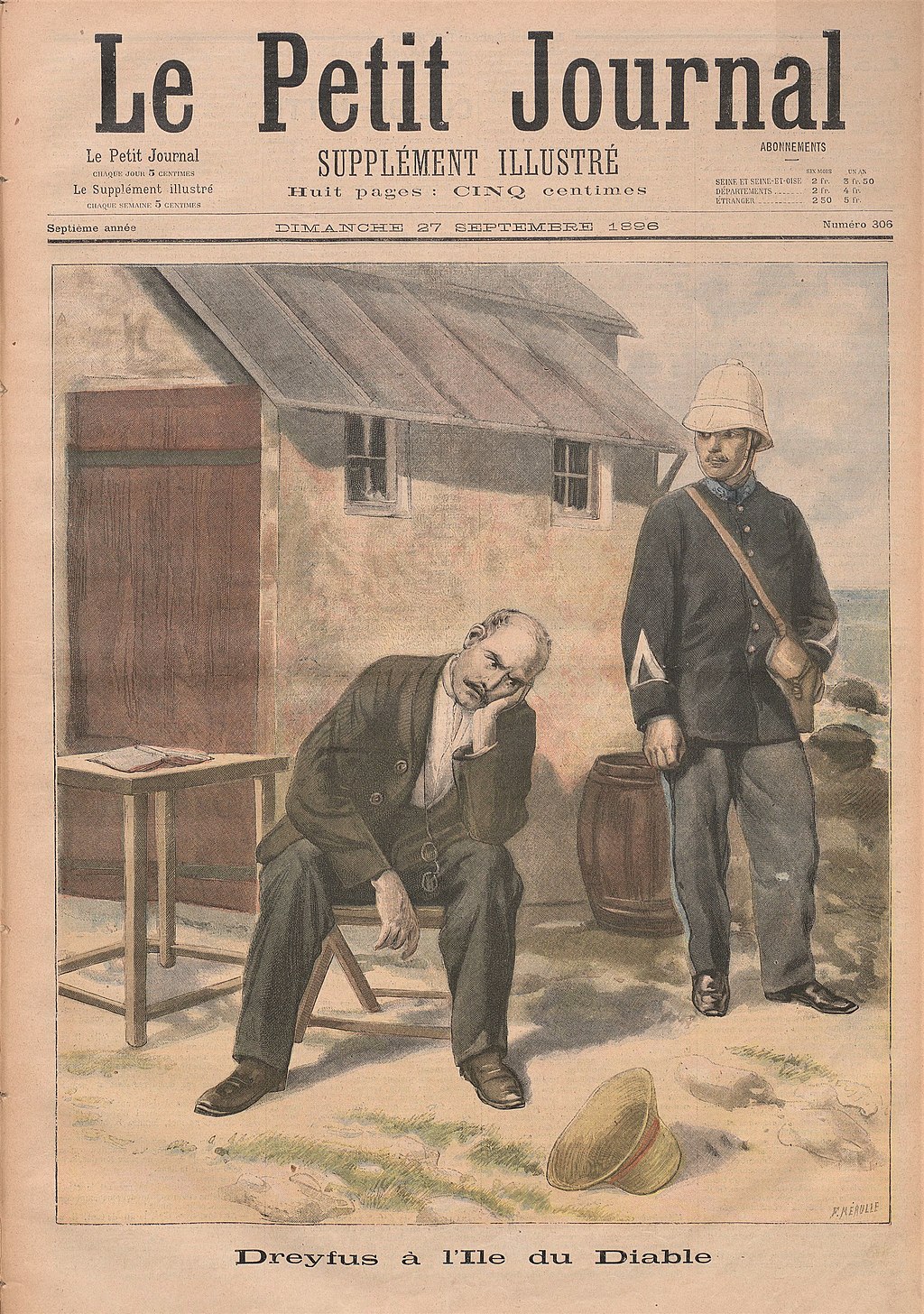 Le Petit Journal (27 September 1896) On 12 March 1895, after a difficult voyage of fifteen days, the ship anchored off the Îles du Salut. Dreyfus stayed one month in prison on Île Royale and was transferred to Devil's Island on 14 April 1895. Apart from his guards, he was the only inhabitant of the island and he stayed in a stone hut 4 by 4 metres (13 ft × 13 ft).[92] Haunted by the risk of escape, the commandant of the prison sentenced him to a hellish life, even though living conditions were already very painful. The temperature reached 45 °C, he was underfed or fed contaminated food and hardly had any treatment for his many tropical diseases. Dreyfus became sick and shaken by fevers that got worse every year.[93] Dreyfus was allowed to write on paper numbered and signed. He underwent censorship by the commandant even when he received mail from his wife Lucie, whereby they encouraged each other. On 6 September 1896, the conditions of life for Dreyfus worsened again; he was chained double looped, forcing him to stay in bed motionless with his ankles shackled. This measure was the result of false information of his escape revealed by a British newspaper. For two long months, Dreyfus was plunged into deep despair, convinced that his life would end on this remote island.[94][tone] |
事件の起源と1894年の裁判 主な記事 アルフレッド・ドレフュスの捜査と逮捕  1894年10月13日付のボルドローの写真。原本は1940年に紛失した。 ボルドロー」の発見 軍事情報部(SR)のスタッフは、24時間体制でパリのドイツ大使館をスパイしていた[20]。彼らは「マダム・バスティアン」というフランス人の家政婦 を雇い、この建物で働いてドイツ人をスパイするように仕向けた。1894年9月、彼女は破られたメモ[21]を見つけ、軍事情報部の雇い主に渡した。この メモは後に「ボルドロー」として知られるようになった[注 2]。この紙切れは大きく6つに破れ[22]、署名も日付もなく、ドイツ大使館駐在のドイツ軍アタッシェ、マクシミリアン・フォン・シュバルツコッペン宛 だった。そこには、新しく開発された「120式油圧ブレーキとこの銃の作動方法」[23][24]に関するフランス軍の機密文書が外国に送られようとして いることが記されていた。 ボルドローの作者探し  1894年、陸軍大臣オーギュスト・メルシエ将軍 統計課」[25]の責任者であるミュルホーズ派[26]のジャン・サンヘルが陸軍大臣オーギュスト・メルシエ将軍に報告するほど、この捕獲は重要であった ようだ。実際、SRは1894年の初めから情報漏洩があったことを疑っており、犯人を突き止めようとしていた。メルシエ陸軍大臣は、その行動が無能であっ たとしてマスコミから厳しく非難されており[27]、自分のイメージを高める機会を狙っていたようである[28][29]。犯人を見つけるために、単純だ が粗雑な推論[30]を用いて、捜査の対象は参謀本部に配属された、あるいは配属されたことのある容疑者に恣意的に限定され、必然的に砲兵[注釈 3]将校の訓練生となった[注釈 4]。 理想的な犯人が特定された: アルフレッド・ドレフュス大尉である。ドレフュスはエコール・ポリテクニックを卒業した砲兵将校で、ユダヤ教を信仰し、アルザス出身で、共和制功労者階級 の出身であった[31]。事件の当初は、ドレフュスの宗教よりもむしろアルザス出身であることが強調されていた。しかし、これらの将校はドイツ語やドイツ 文化に精通しているという理由でフランスから好意を持たれていたため、これらの出自は例外的なものではなかった[32][33]。参謀本部のオフィスにも 反ユダヤ主義が存在し[34]、予備調査における信憑性のギャップを埋めることで、それは急速に事件の中心的存在となった。 実際、ドレフュスは冷淡で引っ込み思案、あるいは高慢な性格であるという評判[35]や、彼の「好奇心」が強く不利に働いた。こうした性格の特徴は、ある ものは偽りであり、あるものは生まれつきのものであったが、省内の日常生活のごく普通の行為をスパイの証拠に変えることによって、告発をもっともらしくし た。当初から、偏った一方的な誤りの積み重ねが、国家を誤った立場に導いた。これはこの事件全体を通じて見られ、当時流行していた実証主義よりも非合理性 が勝っていた[36]。 この最初の時間から、事件全体を支配することになる現象が起こった。信念を構成するのは、注意深く吟味された事実や状況によって支配されるのではなく、事実や信念を歪める抗いがたい軽率な確信なのである。 - ジョセフ・ライナッハ 執筆の専門家  捜査責任者のデュ・パティ・ド・クラム少佐はドレフュス大尉を逮捕した。 ドレフュスを断罪するためには、ボルドローに書かれた文字を大尉のものと比較しなければならなかった。参謀本部には筆跡を分析できる者は誰もいなかった [37]。 そこでデュ・パティ・ド・クラム少佐[38][39]が登場する。彼は筆跡学の専門家であると自負する風変わりな人物であった。10月5日、ドレフュスと ボルドローの手紙を見せられたデュ・パティは、誰がこの2通の手紙を書いたのかを即座に結論づけた。一日がかりの追加作業の後、彼は、いくつかの相違点は あるものの、類似点は調査を正当化するに十分であるとの報告書を提出した。従って、参謀本部の目には、ドレフュスはボルドローの「作者と思われる人物」で あった[40]。  アルフォンス・ベルティヨンは筆跡の専門家ではなかったが、「自書偽造」の理論を考案した。 メルシエ将軍は犯人を捕まえたと信じていたが、彼はこの事件の価値を誇張し、ドレフュス逮捕の前週には国家的な事件となった。同大臣は国家のあらゆる当局 に相談し、知らせたが[41]、閣僚会議でガブリエル・ハノトーが慎重な助言と勇気ある反対を表明したにもかかわらず[42]、追及することを決定した。 その一方で、ドレフュスの人物像に関するものや、ボルドローの作者の正体を確かめるためのものなど、並行していくつかの情報源が開かれていた。専門家[注 釈 5]のゴベールは納得せず、多くの相違点を発見した。さらにゴベールは「ボルドローに書かれた文字の性質から、筆跡が偽装されている可能性はない」とまで 書いている[44]。失望したメルシエは、その後、法医人体計測の発明者でありながら筆跡の専門家ではなかったアルフォンス・ベルティヨンを呼び寄せた。 ベルティヨンは当初、ゴベールほど肯定的ではなかったが、ドレフュスの筆跡である可能性を否定しなかった[45]。後に軍部からの圧力を受け[46]、ベ ルティヨンはドレフュスが自作自演したものだと主張し、「自作自演」説を展開した。 逮捕 1894年10月13日、具体的な証拠もなく、ファイルも空っぽのまま、メルシエ将軍はドレフュス大尉を「ブルジョワの服装」、つまり私服で一般検査のた めに呼び出した。参謀本部の目的は、フランス法の下で完璧な証拠、すなわち自白を得ることであった。その自白は不意打ちによって、つまりボルドロー [47][48]に基づいた手紙を口述筆記することによって、彼の罪を明らかにすることで得られるはずだった。 1894年10月15日の朝、ドレフュス大尉はこの試練を受けたが、何も認めなかった。デュ・パティはドレフュスの前にリボルバーを突きつけて自殺を仄め かそうとさえしたが、ドレフュスは「自分の無実を立証するために生きたい」と言って命を絶つことを拒否した。軍の望みは潰えた。それでもデュ・パティ・ ド・クラムはドレフュス大尉を逮捕し[49]、敵との共謀の罪で告発し、軍法会議にかけると告げた。ドレフュスはパリのシェルシュ=ミディ刑務所に収監さ れた[50]。 尋問と最初の軍事法廷  1895年1月20日付『プチ・ジャーナル』紙の表紙(リオネル・ロワイエにちなんでフォルテュヌ・メーユが描いたイラスト)。 ドレフュス夫人は同日、警察の家宅捜索によって逮捕を知らされた。夫人はデュ・パティに脅迫され、夫の逮捕を秘密にするよう命じられ、「一言、一言言え ば、ヨーロッパ戦争になる!」とまで言われた[51]。違法に[52]ドレフュスは刑務所に独房に入れられ、デュ・パティは自白を得るために昼夜を問わず 尋問したが、失敗に終わった。ドレフュスは、最初のドレフュサールであり、パリの軍刑務所の司令官であったフォルジネッティ少佐に道徳的に支持されてい た。 1894年10月29日、エドゥアール・ドリュモンが所有する反ユダヤ主義新聞『La Libre Parole』の記事で、この事件が明らかになった。これを皮切りに、裁判に至るまで非常に残酷な報道キャンペーンが展開された。この出来事によって、こ の事件は反ユダヤ主義の分野に入り込み、その終結までそのまま残った[53]。 1894年11月1日、アルフレッドの弟であるマチュー・ドレフュスは、パリに緊急に呼び出され、逮捕を知った。彼は迷うことなく弁護士を探し始め、著名な刑事弁護士エドガー・ドゥマンジュに依頼した[55]。 尋問 1894年11月3日、パリ軍総督ソシエ将軍は不本意ながら[56]、査問の命令を下した。軍事法廷の記録官であったベッソン・ドルメシュヴィル少佐は起 訴状を書き、その中で、罪状の「道徳的要素」(ドレフュスの習慣や「賭博場」への出席疑惑、ドイツ語の知識、「驚くべき記憶力」についての噂話)が、罪状 にはほとんど見られない「物質的要素」[注 6]よりも広範囲に展開されていた: 「ドレフュスはすべてを消し去ったのだから、これは有罪の証拠である」。 起訴状が完全に中立性を欠いていたことから、エミール・ゾラはこれを「偏見の記念碑」と呼んだ[58]。 ドレフュス逮捕のニュースが流れると、多くのジャーナリストがこの記事に群がり、憶測と非難で溢れかえった。著名なジャーナリストで反ユダヤ主義運動家の エドゥアール・ドリュモンは、1894年11月3日付の自身の出版物に、「ユダヤ人ドレフュスの不名誉な反逆、なんと恐ろしい教訓であろうか 」と記している。 1894年12月4日、ドレフュスはこの書類とともに第一軍事法廷に召喚された。秘密は解かれ、ドゥマンジュは初めてこの書類にアクセスすることができ た。ドレフュスは、検察側の立証の空虚さを目の当たりにし、絶対的な自信を得た[59]。検察側は、専門家の意見が分かれた一枚の紙、ボルドローに書かれ た文章と、曖昧な間接的証言に完全に依拠していた。 裁判は 「閉廷か戦争か!」  ル・プティ・ジャーナル紙(1894年12月23日)より 裁判前の2ヶ月間、マスコミは大騒ぎした。ラ・リーブル・パロル』、『ル・オートリテ』、『ル・ジュルナル』、『ル・タン』は、ドレフュスの生涯を嘘と下 手な作り話で描写した[60]。 また、『ラ・リーブル・パロル』や『ラ・クロワ』の過激な見出しは、「あなた方は聞かされている!」[61]というテーマで、軍隊におけるユダヤ人の存在 に反対する以前のキャンペーンを正当化する機会でもあった。 [1894 年 11 月 8 日、メルシエ将軍は『フィガロ』紙のインタビューでドレフュスが有罪であると宣言した[63]。 1894 年 11 月 29 日、メルシエ将軍は『ゴロワ』紙に掲載されたアルチュール・マイヤーの記事で、ドレフュスに対する起訴を非難し、「軍事裁判所は被告人を裁く自由をどれほ ど持つだろうか」と問いかけた[64]。 コラムニストたちの争いは、非公開法廷の問題についてのより広範な議論の中で行われた。大多数のマスコミを代表するランとカサニャックにとって、非公開法 廷はドレフュスを無罪にするための卑怯な作戦であった。その証拠に、パリのドイツ大使の否認を公表することに同意したことで、「プロイセンの前にひれ伏し た」のである[65]。1894年12月13日付のレクレールのような他の新聞では、次のように述べている: 「一方、ジュデは12月18日付のル・プティ・ジャーナル紙で「閉廷はドイツに対する我々の難攻不落の避難所である」と述べ、同日付のラ・クロワ紙では 「最も絶対的な閉廷」でなければならないと述べている[66]。 裁判は1894年12月19日1時に開始され[67]、直ちに非公開法廷が宣言された。この非公開法廷は、ピッカート少佐とルイ・レピーヌ県知事が法律に 違反して特定の手続きに出席していたため、法的には整合性がなかった。非公開法廷によって、軍部は自分たちの証拠の空虚さを国民に公表することを避け、議 論を抑圧することができた[68][69]。予想通り、公聴会の間、彼らの主張の空虚さは明らかになった。ボルドローに関する詳細な議論は、ドレフュス大 尉が作者であるはずがないことを示した[70][71]。同時に、被告人自身は無実を訴え、エネルギーと論理性をもって一点一点弁明した[72]。最後 に、犯罪の動機がなかったことは、検察側にとって重大なとげとなった。ドレフュスは確かに上官から高く評価された非常に愛国的な将校であり、非常に裕福 で、フランスを裏切る具体的な理由もなかった[73]。右翼マスコミが盛んに利用したドレフュスのユダヤ人であるという事実は、法廷では公然と提示されな かった。 アルフォンス・ベルティヨンは、筆跡の専門家ではない風変わりな犯罪学者であったが、第一級の学者として紹介された。彼は裁判中に「自筆偽造」説を唱え、 ドレフュスが自分の筆跡を真似ていると非難し、弟マチューとその妻リュシーの筆跡の抜粋を使って筆跡の違いを説明した。この説は、後に奇妙で驚くべきもの とみなされたものの、裁判官には一定の効果があったようである[74]。 さらに、SRの副責任者でボルドローの発見者であるユベール=ジョゼフ・アンリ少佐は、公開の法廷で芝居じみた陳述を行った[75]。 彼は、参謀本部を裏切るリークの存在が1894年2月から疑われており、「立派な人物」がドレフュス大尉を告発したと主張した。ドレフュスは激怒し、匿名 の告発者と面会することを要求したが、参謀本部はこれを拒否した[76]。この事件は、裁判官であり陪審員でもある7人の将校で構成された法廷に紛れもな い影響を与えた。しかし、裁判の結果は不透明なままだった。裁判官たちは審議のために休暇を取ったが、参謀本部はまだドレフュスに不利になるようなカード を手にしていた。 裁判官への秘密文書の送信  マックス・フォン・シュバルツコッペンは、ドレフュスとは面識がないと常に主張していた。 裁判での軍証人は、無罪になる危険性を上層部に警告した。このような事態に備えて、統計課は、原則として、ドレフュス大尉の有罪を証明する4つの「絶対 的」証拠と説明書きを含むファイルを用意していた。この秘密ファイルの内容は、2013年にフランス国防省によって公開されるまで不明のままであった [78][79]。最近の調査で、12通の文書の存在を示唆するナンバリングの存在が判明した。これらの書簡の中には、エロティックな同性愛の性質を持つ ものもあり(ダヴィニョンの書簡など)、統計課の汚染された手法と、彼らの文書選択の目的に疑問を投げかけている[80]。 この秘密ファイルは、陸軍大臣メルシエ将軍の命令により、軍事裁判所長官エミリアン・モーレル大佐によって審議の冒頭に違法に提出された[81]。後に 1899年のレンヌ裁判において、メルシエ将軍は法廷に提出された文書の開示禁止の性質について(偽って)説明した。このファイルには、あまり興味のない 書簡のほかに、「悪党D...」として知られるものが含まれていた[82]。 それは、ドイツ軍アタッシェのマクシミリアン・フォン・シュバルツコッペンがイタリア軍アタッシェのアレッサンドロ・パニッツァルディ中佐にあてた書簡 で、SRが傍受したものであった。この書簡は、ドレフュスを告発する者たちによれば、ドレフュスの名前の頭文字で 署名されていたことから、ドレフュスを決定的に告発するものと思われていた[83]。実際には、統計課は、この書簡がドレフュスのものであるはずがないこ と、もしそうであったとしても、それは犯罪的意図に基づくものであることを知っていた[84]。しかし彼は、自分が読んだのはたった一つの文書だけであ り、「それで十分であった」と述べ、自分自身と矛盾していた[85]。 有罪判決、劣化、国外追放  反逆のシンボルとして剥がされたドレフュスの将校ストライプ - ユダヤ美術歴史博物館 1894年12月22日、数時間の審議の後、判決は下された。7人の裁判官は全員一致で、アルフレッド・ドレフュスを外国勢力との共謀の罪で有罪判決を下 し、刑法第76条に基づく最高刑である、城壁に囲まれた要塞(刑務所)への永久追放、陸軍の階級取り消し、出頭とも呼ばれる軍紀粛正を言い渡した。 1848年以降、政治犯に対する死刑は廃止されていたため、ドレフュスは死刑を宣告されなかった。 当局、マスコミ、国民にとって、裁判によって疑惑は払拭され、彼の有罪は確実となった。右派も左派も、このような犯罪に対する死刑廃止を惜しんだ。社会党 の指導者ジャン・ジョレスは、下院での演説で刑の軽さを悔やみ、「一人の兵士が伍長の顔にボタンを投げつけた罪で死刑を宣告され、処刑された。それなの に、なぜこの惨めな裏切り者を生かしておくのか?" と書いた。急進派の共和主義者ジョルジュ・クレマンソーも『ラ・ジャスティス』で同様のコメントを寄せている[87]。 1895年1月5日、パリの陸軍士官学校のモルラン宮廷で除隊式が行われた。太鼓が鳴り響く中、ドレフュスは4人の砲兵将校に付き添われ、判決を読み上げ る国家将校の前に連れて行かれた。共和国軍の副官が、彼のバッジ、金の細い帯、ストライプ、袖口、上着の袖を引き裂いた。彼が通りをパレードすると、群衆 は 「ユダに死を、ユダヤ人に死を 」と唱えた。目撃者によれば、腕を上げながら無実を主張し続けたドレフュスの威厳が伝えられている: 「無実だ、無実だ!フランス万歳!軍隊万歳」。准尉は膝の上で剣を折ると、死刑囚ドレフュスはかつての仲間の前をゆっくりとした足取りで行進した [88]。「自白の伝説」として知られる出来事が、堕落の前に起こった。ドレフュスは軍学校に運ばれる車の中で、ルブラン=ルノー大尉に自分の裏切りを打 ち明けたと言われている[89][90]。これは共和国軍の大尉による自己宣伝に過ぎず、実際にはドレフュスは告白していなかったようである。この事件は 国民安全保障に関わるものであったため、ドレフュスは独房に収容され、移送を待つことになった。1895年1月17日、ドレフュスはイル・ド・レの刑務所 に移送され、1ヵ月以上収容された。ドレフュスは週に2回、長い部屋で妻と面会する権利を与えられた。  フランス領ギアナの悪魔の島にあるドレフュスの小屋 ドレフュスがニューカレドニアのデュコスに送られないように、メルシエ将軍の発案で、1895年2月9日、フランス領ギアナのイル・デュ・サルーを要塞化 された強制送還地として復活させる法律が成立した[要出典]。実際、1888年に敵国との共謀の罪で判決を受けたルシアン・シャトラン准尉の強制送還の 際、施設は必要な監禁条件を提供しておらず、拘禁条件は甘すぎると考えられていた。1895年2月21日、ドレフュスはヴィル・ド・サン・ナゼール号に乗 船した。翌日、船はフランス領ギアナに向けて出航した。  ル・プティ・ジャーナル紙(1896年9月27日) 1895年3月12日、15日間の困難な航海の後、船はサリュ島沖に停泊した。ドレフュスはイル・ロワイヤルの牢獄に1ヶ月滞在し、1895年4月14日 に悪魔の島に移送された。看守を除けば、この島の住人はドレフュスただ一人であり、彼は4メートル×4メートルの石造りの小屋に寝泊まりした[92]。脱 獄の危険性に取り憑かれた牢獄の指揮官は、生活環境がすでに非常に苦しいものであったにもかかわらず、彼に地獄のような生活を宣告した。気温は45℃に達 し、栄養不足か汚染された食べ物を与えられ、多くの熱帯病の治療もほとんど受けられなかった。ドレフュスは毎年悪化する熱にうなされ、病気になった [93]。 ドレフュスは番号と署名の入った紙に書くことを許された。ドレフュスは、妻のリュシーからの手紙を受け取ったときでさえ、司令官による検閲を受けた。 1896年9月6日、ドレフュスの生活環境は再び悪化した。彼は二重の輪で鎖につながれ、足首に足かせをはめられたままベッドで動かないことを強いられ た。この措置は、イギリスの新聞が暴露したドレフュス逃亡の虚偽情報の結果であった。ドレフュスは2ヶ月という長い間、深い絶望の淵に立たされ、自分の人 生はこの離島で終わるのだと確信した[94][論調]。 |
| The truth emerges (1895–1897) The Dreyfus family exposes the affair and takes action Mathieu Dreyfus, the elder brother of Alfred, was convinced of his innocence. He was the chief architect of the rehabilitation of his brother and spent his time, energy and fortune to gather an increasingly powerful movement for a retrial in December 1894, despite the difficulties of the task:[95] After the degradation emptiness was around us. It seemed to us that we were no longer human beings like others, we were cut off from the world of the living.[96] Mathieu tried all paths, even the most fantastic. Thanks to Dr. Gibert, a friend of President Félix Faure, he met at Le Havre a woman who spoke for the first time under hypnosis of a "secret file".[97][98] This fact was confirmed by the President of the Republic to Dr. Gibert in a private conversation. Little by little, despite threats of arrest for complicity, machinations and entrapment by the military, he managed to convince various moderates.[99] Thus the anarchist journalist Bernard Lazare looked into the proceedings. In 1896, Lazare published the first Dreyfusard booklet in Brussels.[100] This publication had little influence on the political and intellectual world, but it contained so much detail that the General Staff suspected that Picquart, the new head of SR, was responsible. The campaign for the review, relayed little by little into the leftist anti-military press, triggered a return of a violent yet vague antisemitism.[101] France was overwhelmingly anti-Dreyfusard; Major Henry from the Statistics Section in turn was aware of the thinness of the prosecution case. At the request of his superiors, General Boisdeffre, Chief of the General Staff and Major-General Gonse, he was charged with the task of enlarging the file to prevent any attempt at a review. Unable to find any evidence, he decided to build some after the fact. [citation needed] The discovery of the real culprit: Picquart "going to the enemy" Main article: Georges Picquart's investigations of the Dreyfus affair  Lieutenant Colonel Georges Picquart dressed in the uniform of the 4th Algerian Tirailleurs Major Georges Picquart was assigned to be head of the staff of the Military Intelligence Service (SR) in July 1895, following the illness of Colonel Sandherr. In March 1896, Picquart, who had followed the Dreyfus affair from the outset, now required to receive the documents stolen from the German Embassy directly without any intermediary.[97] He discovered a document called the "petit bleu": a telegram that was never sent, written by von Schwarzkoppen and intercepted at the German Embassy at the beginning of March 1896.[102] It was addressed to a French officer, Major Walsin-Esterhazy, 27 rue de la Bienfaisance – Paris.[103] In another letter in black pencil, von Schwarzkoppen revealed the same clandestine relationship with Esterhazy.[104] On seeing letters from Esterhazy, Picquart realized with amazement that his writing was exactly the same as that on the "bordereau", which had been used to incriminate Dreyfus. He procured the "secret file" given to the judges in 1894 and was astonished by the lack of evidence against Dreyfus, and became convinced of his innocence. Moved by his discovery, Picquart diligently conducted an enquiry in secret without the consent of his superiors.[105] The enquiry demonstrated that Esterhazy had knowledge of the elements described by the "bordereau" and that he was in contact with the German Embassy.[106] It was established that the officer sold the Germans many secret documents, whose value was quite low.[107] Ferdinand Walsin Esterhazy was a former member of French counterespionage where he had served after the war of 1870.[108] He had worked in the same office as Major Henry from 1877 to 1880.[109] A man with a personality disorder, a sulphurous reputation and crippled by debt, he was considered by Picquart to be a traitor driven by monetary reasons to betray his country.[110] Picquart communicated the results of his investigation to the General Staff, which opposed him under "the authority of the principle of res judicata". After this, everything was done to oust him from his position, with the help of his own deputy, Major Henry. It was primarily the upper echelons of the Army that did not want to admit that Dreyfus's conviction could be a grave miscarriage of justice. For Mercier, then Zurlinden and the General Staff, what was done was done and should never be returned to.[111] They found it convenient to separate the Dreyfus and Esterhazy affairs. The denunciation of Esterhazy and the progress of Dreyfusism The nationalist press launched a violent campaign against the burgeoning Dreyfusards. In counter-attack, the General Staff discovered and revealed the information hitherto ignored in the "secret file".[112] Doubt began to surface, and figures in the artistic and political spheres asked questions.[Note 7] Picquart tried to convince his seniors to react in favour of Dreyfus, but the General Staff seemed deaf. An investigation was started against him, he was monitored when he was in the east, then transferred to Tunisia "in the interest of the service".[113] At this moment Major Henry chose to take action. On 1 November 1896, he created a false document, subsequently called the "faux Henry" [Henry forgery],[Note 8] keeping the header and signature of an ordinary letter from Panizzardi, and wrote the central text himself: I read that a deputy will call on Dreyfus. If you ask further explanations from Rome, I would say that I never had relations with the Jew. That is understood. If asked, speak like that, because that person should never know what happened with him. This was a rather crude forgery. Generals Gonse and Boisdeffre, however, without asking questions, brought the letter to their minister, General Jean-Baptiste Billot. The doubts of the General Staff regarding the innocence of Dreyfus flew out the window.[114] With this discovery the General Staff decided to protect Esterhazy and persecute Colonel Picquart, "who did not understand anything".[114] Picquart, who knew nothing of the "faux Henry", quickly felt isolated from his fellow soldiers. Major Henry accused Picquart of embezzlement and sent him a letter full of innuendo.[115] He protested in writing and returned to Paris. Picquart confided in his friend, lawyer Louis Leblois, who promised secrecy. Leblois, however, spoke to the vice president of the Senate, the Alsatian Auguste Scheurer-Kestner (born in Mulhouse, like Dreyfus), who was in turn infected by doubts. Without citing Picquart, the senator revealed the affair to the highest people in the country. The General Staff, however, still suspected Picquart of causing leaks. This was the beginning of the Picquart affair, a new conspiracy by the General Staff against an officer.[116] Major Henry, although deputy to Picquart, was jealous and fostered his own malicious operation to compromise his superior.[117] He engaged in various malpractices (making a letter and designating it as an instrument of a "Jewish syndicate", wanting to help Dreyfus to escape, rigging the "petit bleu" to create a belief that Picquart erased the name of the real recipient, drafting a letter naming Dreyfus in full). Parallel to the investigations of Picquart, the defenders of Dreyfus were informed in November 1897 that the identity of the writer of the "bordereau" was Esterhazy. Mathieu Dreyfus had a reproduction of the bordereau published by Le Figaro. A banker, Castro, formally identified the writing as that of Esterhazy, who was his debtor, and told Mathieu. On 11 November 1897, the two paths of investigation met during a meeting between Scheurer-Kestner and Mathieu Dreyfus. The latter finally received confirmation that Esterhazy was the author of the note. Based on this, on 15 November 1897 Mathieu Dreyfus made a complaint to the minister of war against Esterhazy.[118] The controversy was now public and the army had no choice but to open an investigation. At the end of 1897, Picquart returned to Paris and made public his doubts about the guilt of Dreyfus because of his discoveries. Collusion to eliminate Picquart seemed to have failed.[119] The challenge was very strong and turned to confrontation. To discredit Picquart, Esterhazy sent, without effect, letters of complaint to the president of the republic.[120] 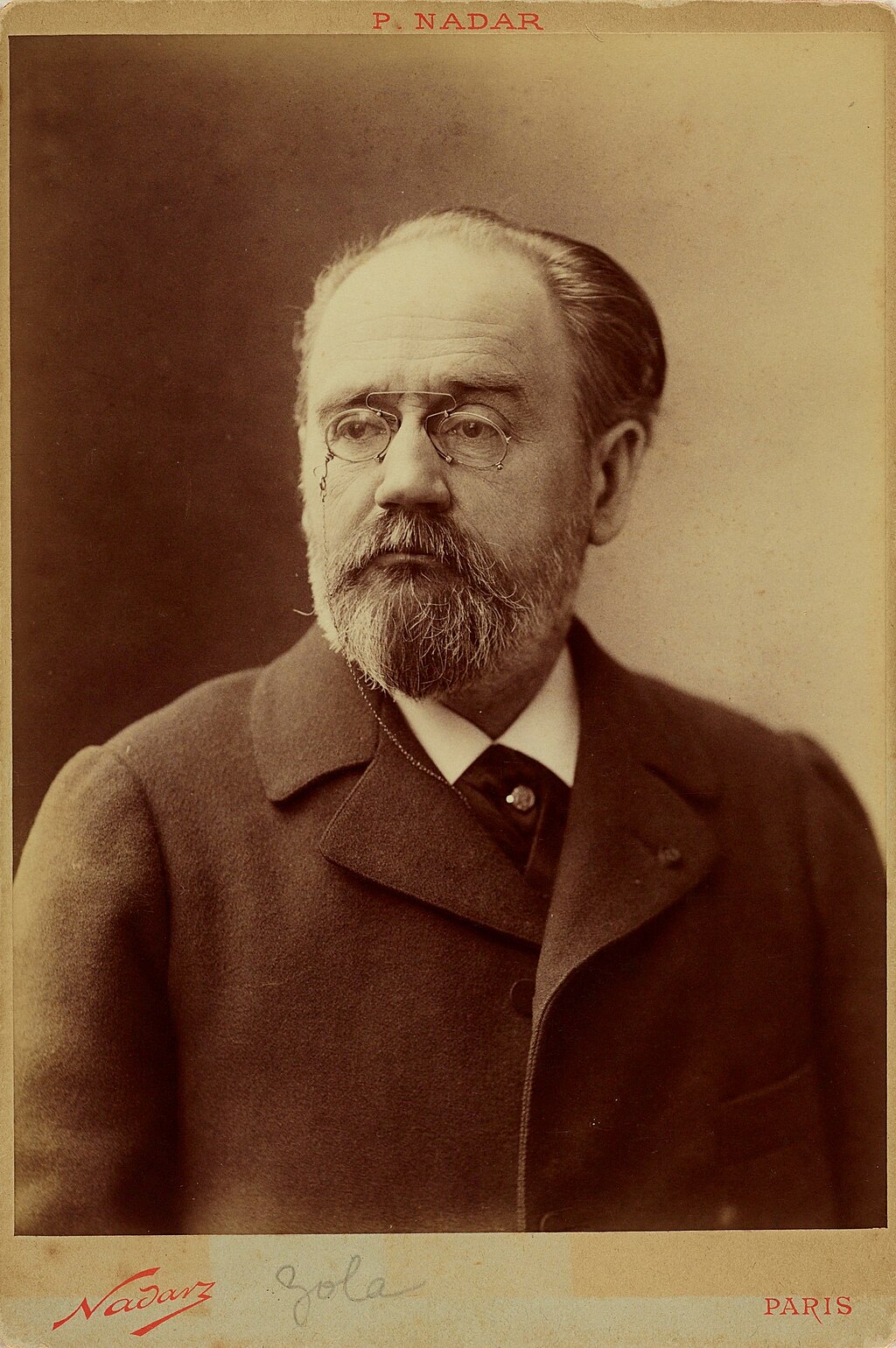 Émile Zola in 1898 The Dreyfusard movement, led by Bernard Lazare, Mathieu Dreyfus, Joseph Reinach and Auguste Scheurer-Kestner gained momentum.[121] Émile Zola, informed in mid-November 1897 by Scheurer-Kestner with documents, was convinced of the innocence of Dreyfus and undertook to engage himself officially.[Note 9] On 25 November 1897 the novelist published Mr. Scheurer-Kestner in Le Figaro, which was the first article in a series of three.[Note 10] Faced with threats of massive cancellations from its readers, the paper's editor stopped supporting Zola.[122] Gradually, from late-November through early-December 1897, a number of prominent people got involved in the fight for retrial. These included the authors Octave Mirbeau (his first article was published three days after Zola)[123] and Anatole France, academic Lucien Lévy-Bruhl, the librarian of the École normale supérieure Lucien Herr (who convinced Léon Blum and Jean Jaurès), the authors of La Revue Blanche,[Note 11] (where Lazare knew the director Thadee Natanson), and the Clemenceau brothers Albert and Georges. Blum tried in late November 1897 to sign, with his friend Maurice Barrès, a petition calling for a retrial, but Barrès refused, broke with Zola and Blum in early-December, and began to popularize the term "intellectuals".[124] This first break was the prelude to a division among the educated elite after 13 January 1898. The Dreyfus affair occupied more and more discussions, something the political world did not always recognize. Jules Méline declared in the opening session of the National Assembly on 7 December 1897, "There is no Dreyfus affair. There is not now and there can be no Dreyfus affair."[125] Trial and acquittal of Esterhazy 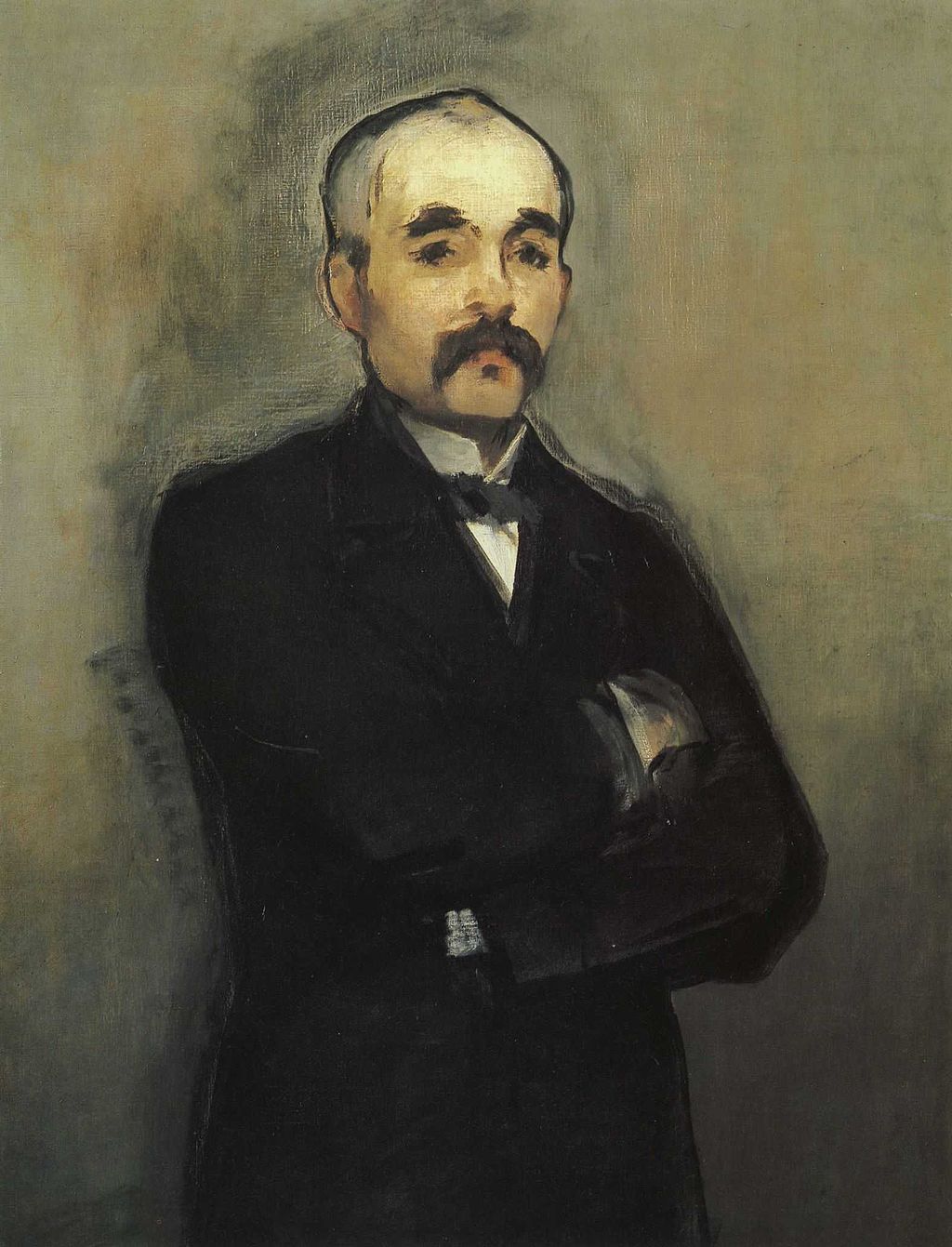 Portrait of Georges Clemenceau by the painter Édouard Manet General Georges-Gabriel de Pellieux was responsible for conducting an investigation. It was brief, thanks to the General Staff's skillful manipulation of the investigator. The real culprit, they said, was Lieutenant-Colonel Picquart.[126] The investigation was moving towards a predictable conclusion until Esterhazy's former mistress, Madame de Boulancy, published letters in Le Figaro in which ten years earlier Esterhazy had expressed violently his hatred for France and his contempt for the French army. The militarist press rushed to the rescue of Esterhazy with an unprecedented antisemitic campaign. The Dreyfusard press replied with strong new evidence in its possession. Georges Clemenceau, in the newspaper L'Aurore, asked, "Who protects Major Esterhazy? The law must stop sucking up to this ineffectual Prussian disguised as a French officer. Why? Who trembles before Esterhazy? What occult power, why shamefully oppose the action of justice? What stands in the way? Why is Esterhazy, a character of depravity and more than doubtful morals, protected while the accused is not? Why is an honest soldier such as Lieutenant-Colonel Picquart discredited, overwhelmed, dishonoured? If this is the case we must speak out!" 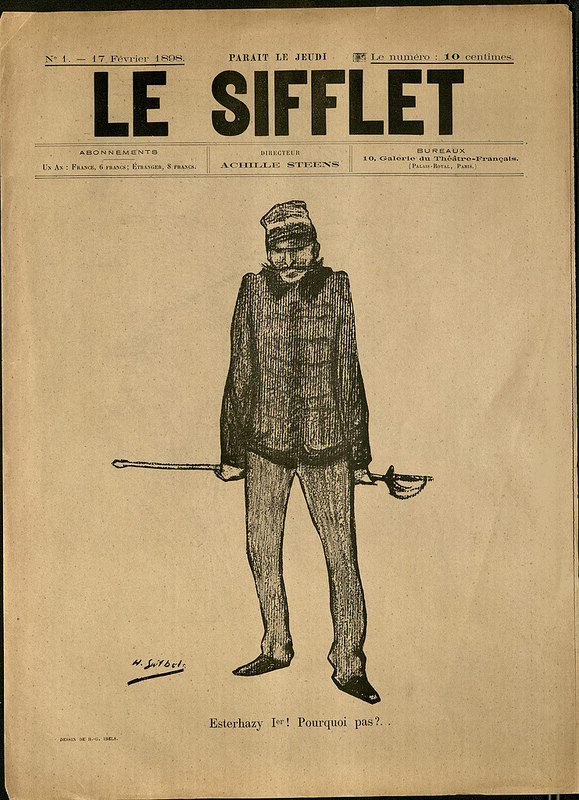 Newspaper showing Esterhazy Although protected by the General Staff and therefore by the government, Esterhazy was obliged to admit authorship of the Francophobe letters published by Le Figaro. This convinced the Office of the General Staff to find a way to stop the questions, doubts, and the beginnings of demands for justice. The idea was to require Esterhazy to demand a trial and be acquitted, to stop the noise and allow a return to order. Thus, to finally exonerate him, according to the old rule Res judicata pro veritate habetur,[Note 12] Esterhazy was set to appear before a military court on 10 January 1898. A "delayed" closed court[Note 13] trial was pronounced. Esterhazy was notified of the matter on the following day, along with guidance on the defensive line to take. The trial was not normal: the civil trial Mathieu and Lucy Dreyfus[Note 14] requested was denied, and the three handwriting experts decided the writing in the bordereau was not Esterhazy's.[127] The accused was applauded and the witnesses booed and jeered. Pellieux intervened to defend the General Staff without legal substance.[128] The real accused was Picquart, who was dishonoured by all the military protagonists of the affair.[129] Esterhazy was acquitted unanimously the next day after just three minutes of deliberation.[130] With all the cheering, it was difficult for Esterhazy to make his way toward the exit, where some 1,500 people were waiting. By error an innocent person was convicted, but on order the guilty party was acquitted. For many moderate Republicans it was an intolerable infringement of the fundamental values they defended. The acquittal of Esterhazy therefore brought about a change of strategy for the Dreyfusards. Liberalism-friendly Scheurer-Kestner and Reinach, took more combative and rebellious action.[131] In response to the acquittal, large and violent riots by anti-Dreyfusards and antisemites broke out across France. Flush with victory, the General Staff arrested Picquart on charges of violation of professional secrecy following the disclosure of his investigation through his lawyer, who revealed it to Senator Scheurer-Kestner. The colonel, although placed under arrest at Fort Mont-Valérien, did not give up and involved himself further in the affair. When Mathieu thanked him, he replied curtly that he was "doing his duty".[130] Esterhazy benefited from special treatment by the upper echelons of the army, which was inexplicable except for the General Staff's desire to stifle any inclination to challenge the verdict of the court martial that had convicted Dreyfus in 1894. The army declared Esterhazy unfit for service. Esterhazy's flight to England and confession To avoid personal risk Esterhazy shaved off his prominent moustache and went into exile in England.[132] Rachel Beer, editor of The Observer and the Sunday Times, interviewed him twice. He confessed to writing the bordereau under orders from Sandherr in an attempt to frame Dreyfus. She wrote about her interviews in September 1898,[133] reporting his confession and writing a leader column accusing the French military of antisemitism and calling for a retrial for Dreyfus.[134] Esterhazy lived comfortably in England until his death in 1923.[132] |
真実が明らかになる(1895年-1897年) ドレフュス一家が事件を暴露し、行動を起こす アルフレッドの兄であるマチュー・ドレフュスは、アルフレッドの無実を確信していた。彼は兄の更生の立役者であり、1894年12月、困難な任務にもかかわらず、時間とエネルギーと財産を費やして、ますます強力な再審請求運動を起こした[95]。 堕落の後、私たちの周りは虚無に包まれた。私たちはもはや他の人たちのような人間ではなく、生者の世界から切り離されているように思えた[96]。 マチューはあらゆる道を試した。フェリックス・フォール大統領の友人であったジベール博士のおかげで、彼はル・アーブルで、催眠術のもとで初めて「秘密の ファイル」について話した女性に出会った[97][98]。この事実は、共和国大統領がジベール博士に私的な会話の中で確認した。 軍部による共謀、策略、囮捜査による逮捕の脅迫にもかかわらず、彼は少しずつ、さまざまな穏健派を説得することに成功した。1896年、ラザールはブ リュッセルで最初のドレフュサールの小冊子を出版した[100]。この出版物は政界や知識人にはほとんど影響を与えなかったが、参謀本部がSRの新しい責 任者であったピッカールの仕業ではないかと疑うほど詳細な内容を含んでいた。 左派の反軍報道機関に少しずつ伝えられる閲兵運動は、暴力的でありながら漠然とした反ユダヤ主義の再来を引き起こした[101]。フランスは圧倒的に反ド レフサードであり、統計課のアンリ少佐は検察側の立件の薄弱さを認識していた。上司である参謀総長のボワデフル将軍とゴンス少将の要請で、彼は再審査の試 みを防ぐためにファイルを拡大する任務を負った。証拠を見つけることができなかったため、彼は事後的に証拠を作ることにした。[要出典]。 真犯人の発見 ピッカートの "敵前逃亡」 主な記事 ジョルジュ・ピカールによるドレフュス事件の調査  アルジェリア第4ティライユールの軍服を着たジョルジュ・ピカール中佐 ジョルジュ・ピカール少佐は1895年7月、サンヘル大佐の病気療養に伴い、軍事情報部(SR)の幕僚長に任命された。1896年3月、ドレフュス事件を 当初から追っていたピッカールは、ドイツ大使館から盗まれた文書を仲介者なしに直接受け取ることを要求した[97]。 [フォン・シュヴァルツコッペンは、黒い鉛筆で書かれた別の手紙の中で、エステルハージとの同じ秘密の関係を明らかにしている[104]。 エステルハージからの手紙を見て、ピッカールは、彼の筆跡がドレフュスを有罪にするために使われた「ボルドロー」の筆跡とまったく同じであることに驚きな がら気づいた。彼は1894年に裁判官たちに渡された「秘密のファイル」を入手し、ドレフュスに不利な証拠がないことに驚き、彼の無実を確信した。その発 見に心を動かされたピッカールは、上官の同意を得ることなく、秘密裏に熱心に調査を行った[105]。 調査の結果、エステルハージが「ボルドロー」に記載された要素を知っていたこと、ドイツ大使館と接触していたことが判明した[106]。 同将校がドイツ人に多くの秘密文書を売っていたことが立証されたが、その価値はかなり低かった[107]。 フェルディナンド・ヴァルサン・エステルハージは、1870年の戦争後に勤務していた元フランス情報局員であった[108]。彼は1877年から1880 年までアンリ少佐と同じ職場で働いていた[109]。人格障害で、硫黄のような評判を持ち、借金で不自由な生活を送っていた彼は、ピッカールに金銭的な理 由で祖国を裏切るように仕向けられた裏切り者であると見なされていた[110]。ピッカールは調査結果を参謀本部に伝えたが、参謀本部は「裁判外の原則の 権威」のもとで彼に反対した。この後、彼自身の副官であったヘンリー少佐の協力を得て、彼をその地位から追い落とすためにあらゆることが行われた。ドレ フュスの有罪判決が重大な誤審である可能性を認めたくなかったのは、主に陸軍上層部であった。メルシエ、ズルリンデン、参謀本部にとって、ドレフュスとエ ステルハージの問題を切り離して考えることは好都合であった[111]。 エステルハージの糾弾とドレフュス主義の進展 ナショナリストのマスコミは、急成長するドレフュス派に対して激しいキャンペーンを展開した。ピッカールはドレフュスを支持するよう先輩たちを説得しよう としたが、参謀本部は聞く耳を持たなかった[注釈 7]。ドレフュスに対する調査が開始され、彼は東部にいるときに監視され、その後「兵役のために」チュニジアに移送された[113]。 このとき、ヘンリー少佐は行動を起こすことを選択した。1896年11月1日、彼は後に「偽ヘンリー」[ヘンリー偽書]と呼ばれる偽の文書を作成し[注 8]、パニツァルディからの普通の手紙のヘッダーと署名を残し、中心的な文章を自分で書いた: 副官がドレフュスを呼び出すと読んだ。ローマからさらに説明を求めるなら、私はユダヤ人と関係を持ったことはないと言うだろう。その通りだ。もし尋ねられたら、そのように答えればよい。 これはかなり粗雑な偽造であった。しかし、ゴンス将軍とボワデフル将軍は、質問することなく、この書簡を大臣のジャン=バティスト・ビヨー将軍に渡した。 ドレフュスの潔白に関する参謀本部の疑念は窓から飛び出した[114]。この発見により、参謀本部はエステルハージを保護し、「何も理解していなかった」 ピッカル大佐を迫害することを決定した[114]。偽アンリ」のことを何も知らなかったピッカルは、すぐに仲間の兵士たちから孤立することになった。アン リ少佐はピッカールの横領を非難し、陰口に満ちた手紙を送った[115]。 ピッカールは書面で抗議し、パリに戻った。 ピッカールは友人の弁護士ルイ・ルブロワに打ち明け、秘密を守ると約束した。しかし、ルブロワは元老院の副議長であるアルザス人のオーギュスト・シェウ ラー=ケストナー(ドレフュスと同じミュルーズ生まれ)に話した。元老院議長はピッカールを引き合いに出すことなく、この件を国の最高権力者に暴露した。 しかし、参謀本部は依然としてピッカールがリークを引き起こしたのではないかと疑っていた。これがピッカート事件の始まりであり、将校に対する参謀本部の 新たな陰謀であった[116]。 アンリ少佐はピッカールの副官であったが、嫉妬にかられ、上司を陥れるために独自の悪意ある作戦を展開した[117]。 彼はさまざまな不正行為(書簡を作成し、それを「ユダヤ人シンジケート」の道具と指定する、ドレフュスの逃亡を手助けしようとする、ピッカールが本当の受 取人の名前を消したと思わせるために「プチ・ブルー」を不正に操作する、ドレフュスを全面的に名指しする書簡を作成する)を行った。 ピッカールの調査と並行して、ドレフュス擁護派は1897年11月、「ボルドロー」の筆者がエステルハージであることを知らされた。マチュー・ドレフュス は、ル・フィガロにボルドローの複製を出版させた。銀行家のカストロは、その文章が自分の債務者であるエステルハージのものであることを正式に確認し、マ チューに伝えた。1897年11月11日、ショイエール=ケストナーとマチュー・ドレフュスが会談した際、二つの捜査方針が一致した。ドレフュスは最終的 にエステルハージが手形の作者であることを確認した。これに基づき、1897年11月15日、マチュー・ドレフュスは陸軍大臣にエステルハージに対する苦 情を申し立てた。1897年末、ピッカールはパリに戻り、ドレフュスの有罪に対する疑念を公表した。ピッカールを排除するための共謀は失敗に終わったよう に思われた[119]。ピッカールの信用を失墜させるために、エステルハージは共和国大統領に苦情の手紙を送ったが、効果はなかった[120]。  1898年、エミール・ゾラ ベルナール・ラザール、マチュー・ドレフュス、ジョゼフ・ライナッハ、オーギュスト・ショイエール=ケストナーらによって率いられたドレフュサール運動は 勢いを増した[121]。 1897年11月中旬にショイエール=ケストナーから資料を知らされたエミール・ゾラは、ドレフュスの無実を確信し、公式に関与することを約束した[注 9] 。この記事は3回シリーズの最初の記事であった[注釈 10]。読者からの大量解約の脅迫に直面した同紙の編集者は、ゾラへの支援を中止した[122]。1897年11月下旬から12月上旬にかけて、徐々に多 くの著名人が再審闘争に参加するようになった。その中には、作家のオクターヴ・ミルボー(彼の最初の記事はゾラの3日後に掲載された)[123]とアナ トール・フランス、学者のルシアン・レヴィ=ブリュール、高等師範学校の司書ルシアン・ヘル(レオン・ブルムとジャン・ジョレスを説得した)、『ラ・ル ヴュ・ブランシュ』[注釈 11]の著者たち(ラザールはタデ・ナタンソン監督を知っていた)、クレマンソー兄弟のアルベールとジョルジュが含まれていた。ブルムは1897年11月 下旬、友人のモーリス・バレスとともに再審を求める嘆願書に署名しようとしたが、バレスはこれを拒否し、12月初旬にはゾラやブルムと決裂し、「知識人」 という言葉を普及させ始めた[124]。この最初の決裂は、1898年1月13日以降の教養あるエリートたちの分裂への序曲であった。 ドレフュス事件はますます多くの議論を占めるようになったが、政界はこのことを必ずしも認識していなかった。ジュール・メリーヌは1897年12月7日の国民議会開会式で、「ドレフュス事件は存在しない。ドレフュス事件は存在しないし、存在しえない」[125]。 エステルハージの裁判と無罪判決  画家エドゥアール・マネによるジョルジュ・クレマンソーの肖像画 ジョルジュ=ガブリエル・ド・ペリュー将軍が捜査を担当した。参謀本部が調査官を巧みに操ったおかげで、調査は短時間で終わった。エステルハージのかつて の愛人であったブーランシー夫人が、10年前にエステルハージがフランスへの憎悪とフランス軍への軽蔑を激しく表明した手紙を『フィガロ』紙に発表するま で、調査は予想通りの結末に向かっていた[126]。軍国主義マスコミは、前例のない反ユダヤ主義キャンペーンを展開し、エステルハージの救援に駆けつけ た。ドレフュサールのマスコミは、強力な新証拠を手にしてこれに反論した。ジョルジュ・クレマンソーは『オロール』紙で、「誰がエステルハージ少佐を守る のか?このフランス軍将校を装った無能なプロイセンを法律で保護するのはやめるべきだ。なぜだ?誰がエステルハージの前で震え上がるのか?どんなオカルト 的な権力が、なぜ恥ずかしげもなく正義の行動に反対するのか?何が邪魔をするのか?なぜエステルハージは、堕落し、モラルも疑わしいにもほどがある人物な のに、被告人は保護され、被告人は保護されないのか?ピッカート中佐のような誠実な兵士が、なぜ信用を失い、圧倒され、不名誉な扱いを受けるのか。もしそ うなら、我々は声を上げなければならない。  エステルハージーを映した新聞 エステルハージは、参謀本部、つまり政府の保護を受けながらも、ル・フィガロ紙に掲載されたフランコフォビア書簡の著者であることを認めざるを得なかっ た。このため参謀本部は、疑問や疑念、正義を求める声の高まりを食い止める方法を考えなければならなくなった。それは、エステルハージに裁判を要求し、無 罪にすることで、騒ぎを収め、秩序を取り戻すことだった。こうして、Res judicata pro veritate habetur[注釈 12]という古いルールに従って、最終的に彼の容疑を晴らすために、エステルハージは1898年1月10日に軍事法廷に出廷することになった。遅延され た」非公開裁判[注釈 13]が宣告された。エステルハージは翌日、取るべき防衛線についての指導とともに、この件について通告を受けた。マチューとルーシー・ドレフュス[注釈 14]が要求した民事裁判は却下され、3人の筆跡鑑定人はボルドローに書かれた文字はエステルハージのものではないと判断した[127]。ペリューは法的 根拠なく参謀本部を擁護するために介入した[128]。 本当の被告人はピッカートであり、彼はこの事件のすべての軍部の主人公たちから不名誉な扱いを受けた[129]。 エステルハージは翌日、わずか3分間の審議の後、満場一致で無罪となった[130]。 歓声の中、エステルハージが1,500人ほどの人々が待つ出口に向かうのは困難だった。 誤って無実の者が有罪になったが、命令により有罪の者は無罪になった。多くの穏健派共和党員にとって、それは彼らが擁護してきた基本的価値観に対する耐え 難い侵害であった。エステルハージの無罪判決は、ドレフュサール派に戦略の変更をもたらした。リベラリズムに親和的なシェウラー=ケストナーとライナッハ は、より闘争的で反抗的な行動をとった[131]。無罪判決に呼応して、反ドレフュサール派と反ユダヤ主義者による大規模で暴力的な暴動がフランス全土で 発生した。 勝利に浮かれていた参謀本部は、弁護士を通じてピッカールの調査を暴露し、ピッカールがそれをショイラー=ケストナー上院議員に暴露したため、職務上の秘 密侵害の容疑でピッカールを逮捕した。大佐はモン・ヴァレリアン要塞で逮捕されたものの、あきらめずにさらに事件に関与した。1894年にドレフュスに有 罪判決を下した軍法会議の評決に異議を唱えようとする気持ちを封じ込めようとする参謀本部の思惑を除けば、エステルハージは陸軍上層部による特別待遇の恩 恵を受けていた。陸軍はエステルハージの軍務不適格を宣言した。 エステルハージのイギリスへの逃亡と自白 身の危険を避けるため、エステルハージは目立つ口髭を剃り落とし、イギリスに亡命した[132]。 オブザーバー』紙と『サンデー・タイムズ』紙の編集者レイチェル・ビアは彼に2度インタビューした。彼はドレフュスに濡れ衣を着せようとして、サンヘルの 命令でボルドローを書いたことを告白した。彼女は1898年9月にインタビューについて書き、彼の告白を報じ、フランス軍の反ユダヤ主義を非難し、ドレ フュスの再審を求めるリーダーコラムを書いた[134]。 |
| J'Accuse ...! 1898 The Dreyfus affair becomes "The Affair" Main article: J'accuse...! 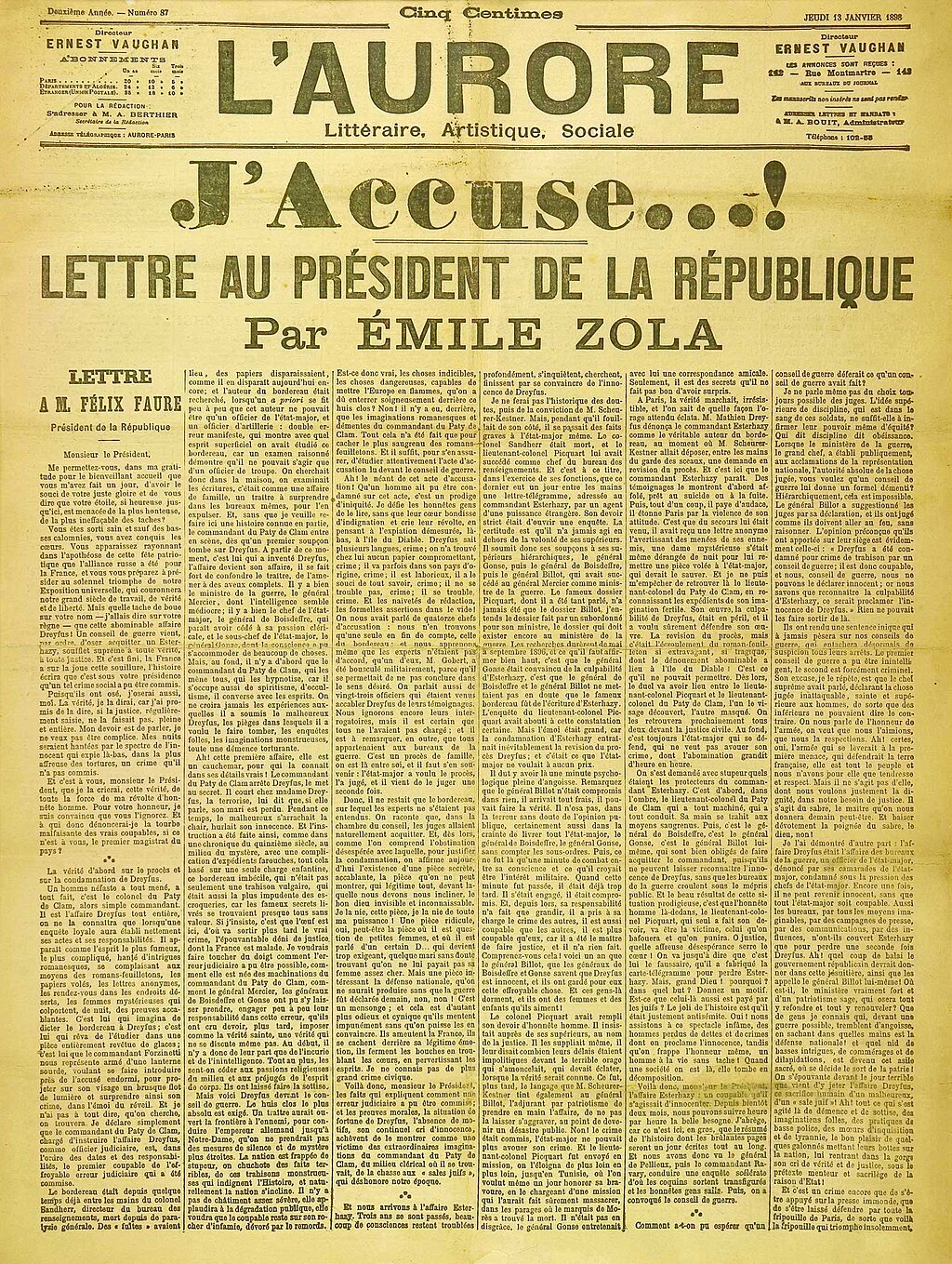 Page one of L'Aurore, J'Accuse...! by Émile Zola, 13 January 1898 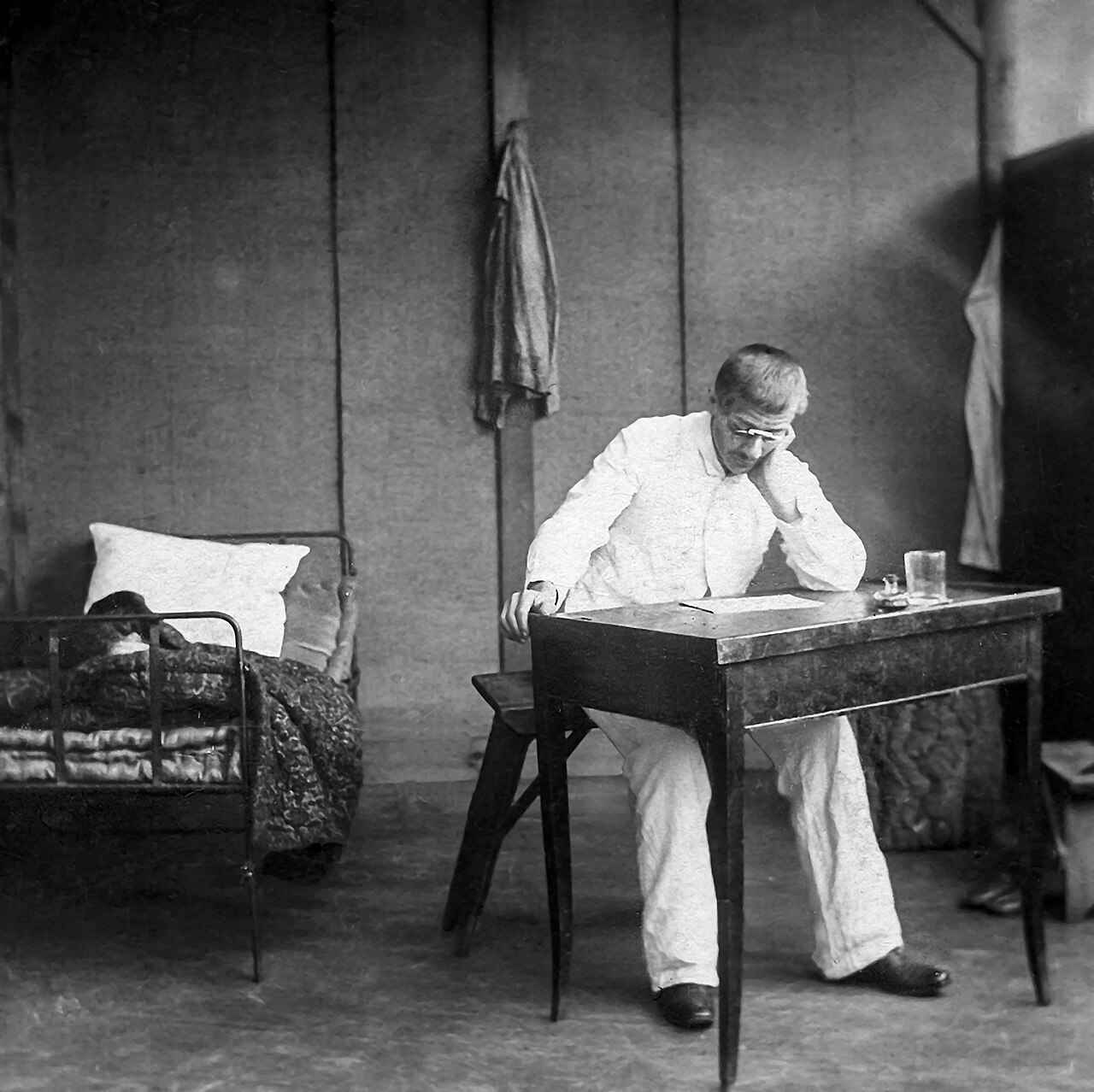 Alfred Dreyfus in his room on Devil's Island in 1898, cropped from a stereograph sold by F. Hamel, Altona-Hamburg...; collection Fritz Lachmund On 13 January 1898, Émile Zola touched off a new dimension in the Dreyfus affair, which became known simply as The Affair. The first great Dreyfusard intellectual, Zola was at the height of his glory: the twenty volumes of the Les Rougon-Macquart epic were being distributed in dozens of countries. He was a leader in the literary world and was fully conscious of it. To General Pellieux, he said at his trial, "I ask General Pellieux if there are not many ways to serve France? It can be served by the sword or by the pen. General Pellieux has probably won great victories! I have won mine, too. By my work the French language has been brought into the world. I have my victories! I bequeath to posterity the name of General Pellieux and that of Émile Zola: history will choose![135] Outraged by the acquittal of Esterhazy, Zola published a 4,500-word article on the front page of L'Aurore in the form of an open letter to President Félix Faure (Clemenceau thought up the headline J'Accuse...!). With a typical circulation of 30,000, the newspaper distributed nearly 300,000 copies that day. This article had the effect of an explosion. The article was a direct attack, explicit and clear, and named names. It denounced all those who had conspired against Dreyfus, including the minister of war and the General Staff. The article contained numerous errors, exaggerating or minimizing the roles of one or another of the figures involved (the role of General Mercier was greatly underestimated, for instance).[136] J'Accuse...! provided for the first time a compilation of all existing data on the affair in one place.[137] Zola's goal was to make himself a target, to force the authorities to prosecute him. His trial forced a new public review of both the Dreyfus and Esterhazy affairs. Here he went against the strategy of Scheurer-Kestner and Lazare, who advocated patience and reflection.[138] Thanks to the national and international success of Zola's article, a trial became inevitable. From that critical moment the case followed two parallel paths. On one hand, the state used its apparatus to impose a limitation on the trial, restricting it to one of simple libel so as to separate the Dreyfus and Esterhazy cases, which had already been adjudicated. On the other hand, conflicting camps of opinion tried to influence judges and the government—one side pushed to obtain a review and the other to convict Zola. But Zola achieved his aim: the opening of a public debate at the Assize Court. On 15 January 1898, Le Temps published a petition calling for a retrial.[139] It included the names of Émile Zola, Anatole France, director of the Pasteur Institute Émile Duclaux, Daniel Halévy, Fernand Gregh, Félix Fénéon, Marcel Proust, Lucien Herr, Charles Andler, Victor Bérard, François Simiand, Georges Sorel, the painter Claude Monet, the writer Jules Renard, the sociologist Émile Durkheim, and the historian Gabriel Monod. On 20 January 1898, after an anti-Zola speech by rightist politician Albert de Mun at the Chamber of Deputies, the chamber voted 312–22 to prosecute Zola.[140] On 23 January 1898 Clemenceau, in the name of a "peaceful revolt of the French spirit", picked up the term "intellectuals" and used it in L'Aurore, but in a positive sense. On 1 February 1898, Barres lambasted the intellectuals in Le Journal. Anti-intellectualism became a major theme of right-wing intellectuals, who accused the Dreyfusards of failing to put the nation's interests first, an argument that continued throughout the years that followed and which became the basis of the public debate: a choice between justice and truth on the one hand, and the defense of the nation, preservation of society, and superiority of the state on the other.[141] At first, the political left did not echo this mobilization of intellectuals—on 19 January 1898 Socialist Deputies distanced themselves from the "two rival bourgeois factions". The trial of Zola 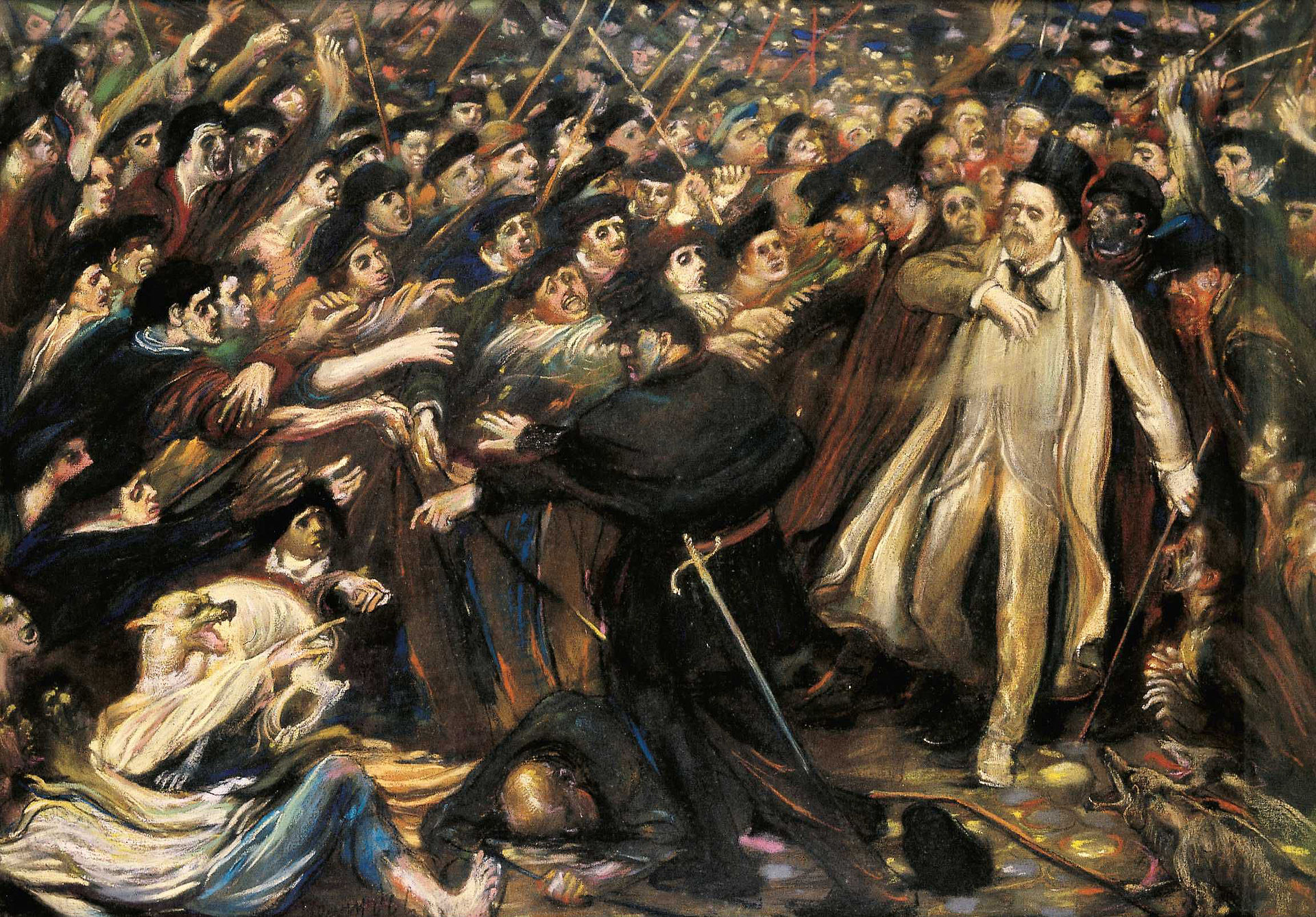 Henry de Groux, Zola faces the mob, oil on canvas, 1898 General Billot, Minister of War, filed a complaint against Zola and Alexandre Perrenx, the manager of L'Aurore, to be heard at the Assises of the Seine from 7 to 23 February 1898. Defamation of a public authority was liable to trial in the Cour d'Assises, while insults to private figures—such as journalists and intellectuals—uttered by the nationalist and antisemitic press were limited to the civil adversarial system. (The taxpayer is at risk in the first case, while only the plaintiff is at risk in the second.) The minister referred to only three passages of Zola's article,[142] eighteen lines out of hundreds. He accused Zola of having written that the court martial had committed "unlawful acts ... by order".[143] The trial opened in an atmosphere of extreme violence—Zola had been the object of "the most shameful attacks" as well as important support and congratulations. (On 2 February, Octave Mirbeau, Laurent Tailhade, Pierre Quillard and Georges Courteline, among others, in L'Aurore signed an "Address to Émile Zola" assuring him of their support "in the name of justice and truth".) Fernand Labori, Zola's lawyer, intended to call about 200 witnesses. The details of the Dreyfus affair, unknown to most of the public, were published in the press. Several papers, Le Siecle and L'Áurore among others, published shorthand notes verbatim of the debates every day to build support in the population. These notes were, for the Dreyfusards, an essential tool for later debates. The nationalists, behind Henri Rochefort, however, were more visible and organized riots, which forced the prefect of police to intervene to protect Zola whenever he left the facility[144] after every hearing.[145] This trial was also the scene of a real legal battle in which the rights of the defence were constantly violated.[146] Many observers were aware of the collusion between France's political and military worlds. Evidently the court received instructions not to raise the subject of former judicial errors. President Delegorgue, on the pretext of the long duration of the hearings, juggled the law incessantly to ensure that the trial dealt only with the alleged defamation by Zola. Delegorgue's phrase "the question will not be put" was repeated dozens of times.[147] Zola was sentenced to one year in prison and a fine of 3,000 francs,[Note 15] which was the maximum penalty. This harshness was due to the atmosphere of violence surrounding the trial. "The excitement of the audience and the exasperation of the crowd in front of the courthouse were so violent that one could fear the worst excesses if the jury acquitted Mr. Zola".[148] However, the Zola trial was rather a victory for the Dreyfusards.[149] Indeed, the affair and its contradictions had been widely discussed throughout the trial, especially by the military. In addition, the violent attacks against Zola and the injustice of the conviction of Dreyfus reinforced the commitment of the Dreyfusards. Stéphane Mallarmé declared, "[I am] imbued by the admirable actions [of Zola]"[150] and Jules Renard wrote in his diary: "From tonight I hold on to the Republic that inspires respect in me, a tenderness in me that I do not know. I declare that Justice is the most beautiful word in the language of men and I must cry if men no longer understand it".[151] Senator Ludovic Trarieux and Catholic jurist Paul Viollet founded the League for the Defence of Human Rights. Even more than the Dreyfus affair the Zola affair resulted in a regrouping of intellectual forces into two opposing camps. On 2 April 1898, an application to the Supreme Court received a favourable response. This was the court's first intervention in the affair. The court upheld the appeal, on the formal grounds that as the alleged libel was against the military court, rather than the minister, it was the military court that should have made the complaint. Prosecutor-General Manau supported a review of the Dreyfus trial and strongly opposed the antisemites. The judges of the military court, whom Zola had challenged, therefore opened a new suit against him for libel. The case was brought before the Assizes of Seine-et-Oise in Versailles where the public was considered more favourable to the army and more nationalistic. On 23 May 1898, at the first hearing, Mr. Labori appealed to the Supreme Court regarding the change of jurisdiction, which adjourned the trial and postponed the hearing to 18 July 1898. Labori advised Zola to leave France for England before the end of the trial, which the writer did, departing for a one-year exile in England. The defendants were convicted again. As for Colonel Picquart, he found himself again in prison. Antisemitic riots  Antisemitic riots in a print from Le Petit Parisien 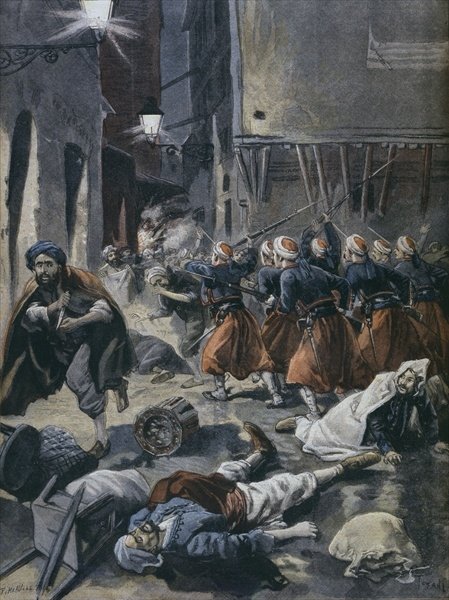 1898 antisemitic riots in Algiers Antisemitic disturbances and riots broke out in 1898 in cities across Metropolitan France, mostly in January and February. Antisemitic riots predated the Dreyfus affair, and were almost a tradition in the East, which "the Alsatian people observed upon the outbreak of any revolution in France".[152] But the 1898 disturbances were much more widespread. There were three waves of unrest in 55 localities: the first ending the week of 23 January; the second wave in the week following; and the third wave from 23–28 February; these waves and other incidents totaled 69 riots or disturbances across the country. Additionally, riots took place in Algeria from 18–25 January. Demonstrators at these disturbances threw stones, chanted slogans, attacked Jewish property and sometimes Jewish people, and resisted police efforts to stop them. Mayors called for calm, and troops including cavalry were called in an attempt to quell the disturbances.[153] Zola's J'Accuse appeared on 13 January, and most historians suggest that the riots were spontaneous reactions to its publication, and to the subsequent Zola trial. The press reported that "tumultuous demonstrations broke out nearly every day". Prefects or police in various towns noted demonstrations in their localities, and associated them with "the campaign undertaken in favor of ex-Captain Dreyfus", or with the "intervention by M. Zola", or the Zola trial itself, which "seems to have aroused the antisemitic demonstrations". In Paris, demonstrations around the Zola trial were frequent and sometimes violent. Roger Martin du Gard reported that "Individuals with Jewish features were grabbed, surrounded, and roughed up by delirious youths who danced round them, brandishing flaming torches, made from rolled-up copies of L'Aurore.[153] However, the fervid reaction to the Dreyfus affair and especially the Zola trial was only partly spontaneous. In a dozen cities including Nantes, Lille, and Le Havre, antisemitic posters appeared in the streets, and riots followed soon after. At Saint-Etienne, posters read, "Imitate your brothers of Paris, Lyon, Marseille, Nantes, Toulouse ... join with them in demonstrating against the underhand attacks being made on the Nation." In Caen, Marseille, and other cities, riots followed antisemitic speeches or meetings, such as the meeting organized by the Comité de Défense Religieuse et Sociale in Caen.[153] Henry unmasked, the case is rekindled 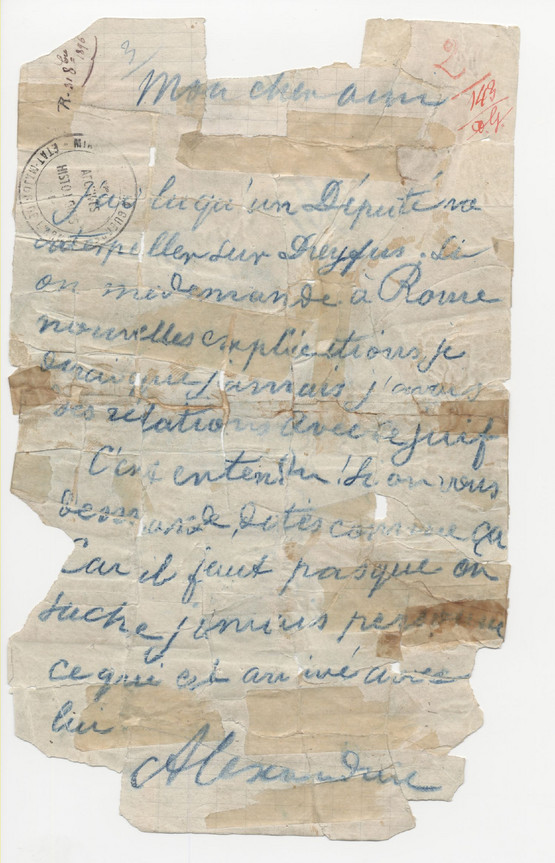 Photograph of the "faux Henry". The header ("my dear friend") and signature ("Alexandrine") are from Panizzardi. The rest is from the hand of Henry. The acquittal of Esterhazy, the convictions of Émile Zola and of Georges Picquart, and the continued presence of an innocent man in prison had a considerable national and international effect.[154] France was exposed as an arbitrary state, which contradicted its founding republican principles. Antisemitism made considerable progress and riots were common throughout the year 1898. However politicians were still in denial about the affair. In April and May 1898, they were mostly concerned with elections, in which Jaurès lost his seat of Carmaux.[155] The majority was moderate, though a parliamentary group in the House was antisemitic. Nevertheless the cause of the Dreyfusards was restarted. Godefroy Cavaignac, the new minister of war and a fierce supporter of anti-revisionism, definitely wanted to prove the guilt of Dreyfus and from there "wring the neck" of Esterhazy, whom he considered "a pathological liar and blackmailer".[156] He was absolutely convinced of Dreyfus's guilt, a conviction reinforced by the legend of the confession (after meeting the main witness, Captain Lebrun-Renault).[157] Cavaignac had the honesty of a doctrinaire intransigent,[158] but absolutely did not know the depths of the affair—the General Staff had kept him in the dark. He was surprised to learn that all the documents on which the prosecution was based had not been expertly appraised and that Boisdeffre had "absolute confidence" in Henry. Cavaignac decided to investigate—in his office, with his assistants—and retrieved the secret file, which now contained 365 items.[159] On 4 April, the newspaper Le Siècle published Lettre d'un Diplomate, the first of four documents, that were of critical importance in exposing Esterhazy's guilt, and enabled the Dreyfusard cause to regain the initiative it had lost with Zola's conviction. The secret information had been provided by Zola, who had received it from Oscar Wilde; Wilde had gained it from best friend Carlos Blacker, who was an intimate friend of Alessandro Panizzardi.[160][161] 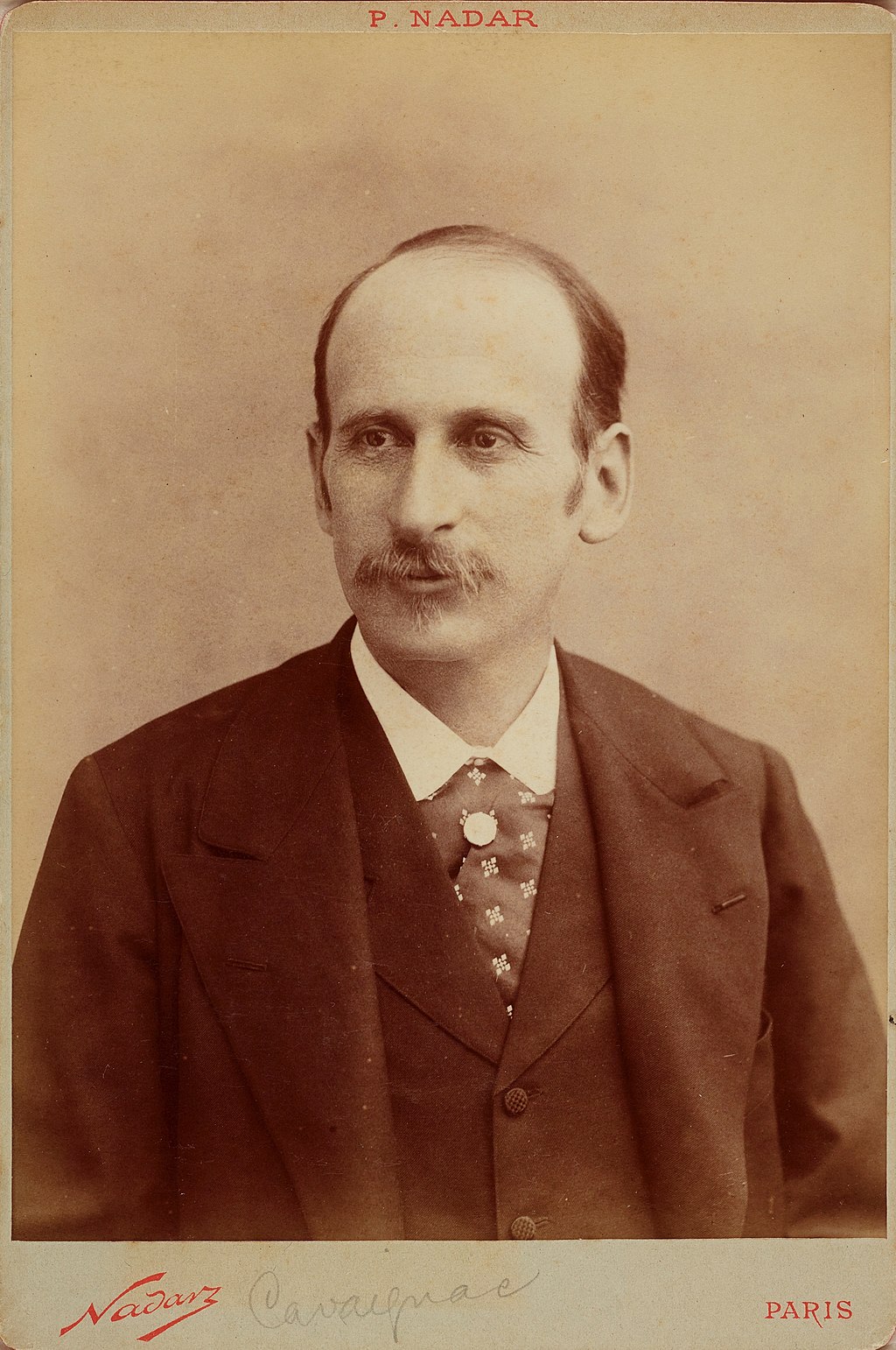 Portrait of Godefroy Cavaignac, Minister of War On 7 July 1898, during a questioning in the National Assembly Cavaignac reported three items "overwhelming among a thousand", two of which had no connection with the case. The other was the "faux Henry".[162] Cavaignac's speech was effective: the députés (deputies) gave him an ovation and voted to display copies of the three documents in the 36,000 communes of France.[163] The anti-Dreyfusards had triumphed, but Cavaignac implicitly recognized that the Dreyfus's defence had not had access to all the evidence. The application for annulment made by Lucie Dreyfus became admissible. The next day, Picquart declared in Le Temps to the council president, "I am in a position to establish before a court of competent jurisdiction that the two documents bearing the date of 1894 could not be attributed to Dreyfus and that the one that bears the date of 1896 had all the characteristics of a fake", which earned him eleven months in prison. On the evening of 13 August 1898, Louis Cuignet, who was attached to the cabinet of Cavaignac, was working by the light of a lamp and observed that the colour of the lines on the "faux Henry" paper header and footer did not correspond with the central part of the document. Cavaignac was still trying to find logical reasons for the guilt and conviction of Dreyfus[164] but was not silent on this discovery.[165] A board of inquiry was formed to investigate Esterhazy, before which he panicked and confessed his secret reports to Major du Paty de Clam. Collusion between the General Staff and the traitor was revealed. On 30 August 1898 Cavaignac resigned himself to demanding explanations from Colonel Henry in the presence of Boisdeffre and Gonse. After an hour of questioning by the minister himself, Henry broke down and made a full confession.[166] He was placed under arrest at the Mont-Valérien fortress, where he killed himself[167][168] the next day by cutting his own throat with a razor. The request for review filed by Lucie Dreyfus could not be rejected. Yet Cavaignac said "less than ever!",[169] but the president of the council, Henri Brisson, forced him to resign. Despite his apparently entirely involuntary role in the revision of the 1894 trial Cavaignac remained convinced that Dreyfus was guilty and made a statement disparaging and offensive to Dreyfus at the Rennes trial.[170] 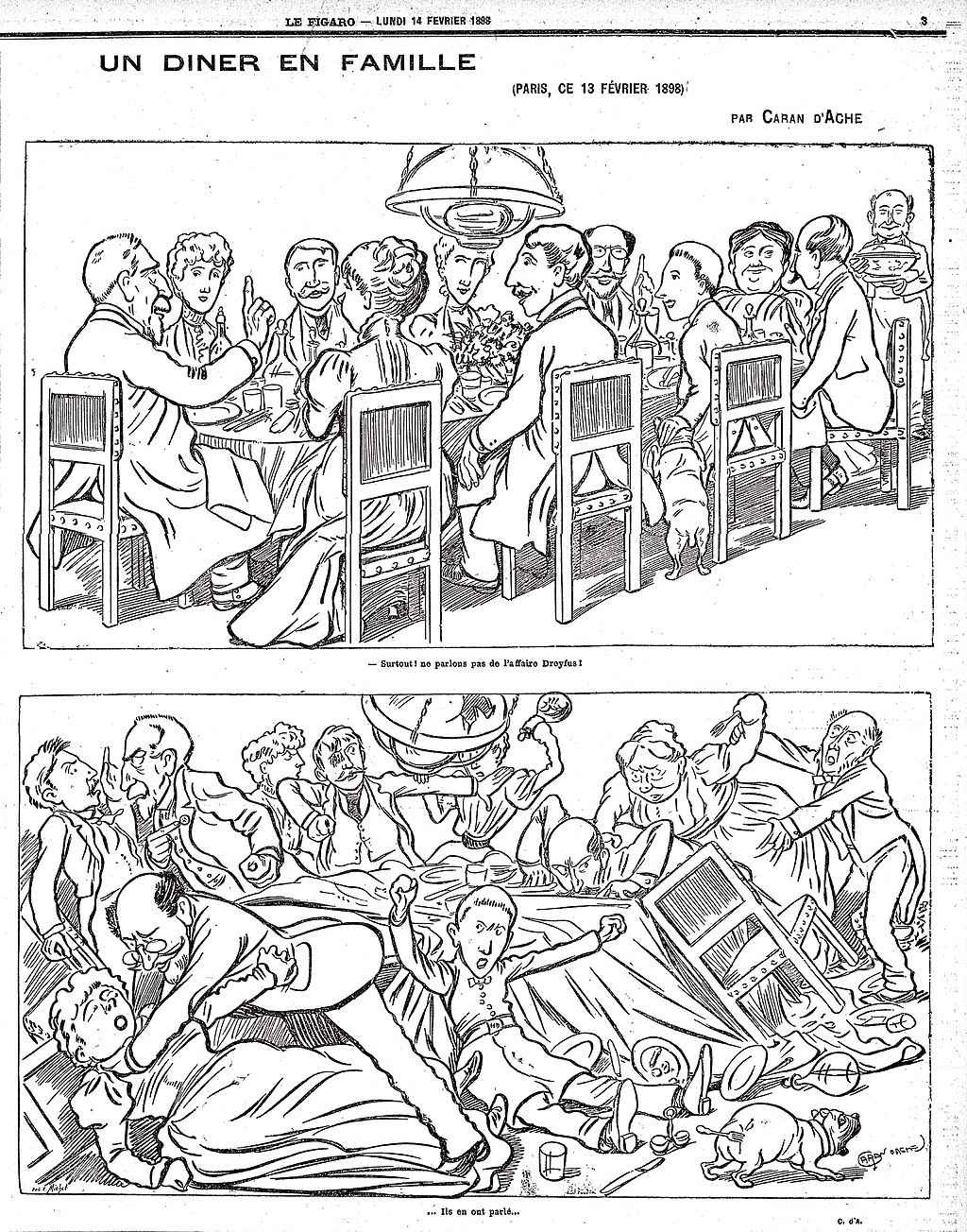 Drawing by Caran d'Ache in Le Figaro on 14 February 1898 The anti-revisionists did not consider themselves beaten. On 6 September 1898 Charles Maurras published a eulogy of Henry in La Gazette de France in which he called him a "heroic servant of the great interests of the State".[171] La Libre Parole, Drumont's antisemitic newspaper, spread the notion of "patriotic fake" ("faux patriotique"). In December the same newspaper launched a subscription, in favour of his widow, to erect a monument to Henry. Each gift was accompanied by pithy, often abusive, remarks on Dreyfus, the Dreyfusards, and the Jews. Some 14,000 subscribers,[172] including 53 deputies, sent 131,000 francs.[173] On 3 September 1898, Brisson, the president of the council, urged Mathieu Dreyfus to file an application for review of the military court of 1894. The government transferred the case to the Supreme Court for its opinion on the past four years of proceedings. France was thoroughly divided into two, but several things remain clear: the Jewish community had little involvement, intellectuals were not all Dreyfusards,[Note 16] the Protestants were divided, and Marxists refused to support Dreyfus.[174] The split transcended religion and social background, as shown in a cartoon by Caran d'Ache, “A Family Dinner”: before, "Above all, never talk about it!"; after, "They talked about it". |
私は告発する 1898 ドレフュス事件が 「事件 」となる 主な記事 告発...!  1898年1月13日、エミール・ゾラ著『L'Aurore, J'Accuse...!  1898年、悪魔の島の自室にいるアルフレッド・ドレフュス、 アルトナ・ハンブルクのF.ハメル社が販売したステレオ写真から切り取られた。 1898年1月13日、エミール・ゾラはドレフュス事件に新たな局面をもたらした。最初の偉大なドレフュサール派の知識人であるゾラは、栄光の絶頂にあっ た。彼は文学界のリーダーであり、それを十分に自覚していた。ペリュー将軍に対して、彼は裁判でこう言った。「フランスに奉仕する方法はたくさんあるので はないか?剣で仕えることも、ペンで仕えることもできる。ペリュー将軍はおそらく偉大な勝利を収めたのだろう!私にも勝利がある。私の仕事によって、フラ ンス語は世界に広まった。私には私の勝利がある!私は後世にペリュー将軍とエミール・ゾラの名を遺す。 エステルハージの無罪判決に憤慨したゾラは、フェリックス・フォール大統領に宛てた公開書簡の形で、『L'Aurore』の一面に4,500字の記事を掲 載した(クレマンソーは「J'Accuse...!」という見出しを考えた)。一般的な発行部数3万部のこの新聞は、その日30万部近くを配布した。この 記事は爆発的な効果をもたらした。この記事は直接的な攻撃であり、明確かつ明瞭で、名前を挙げていた。陸軍大臣や参謀本部を含め、ドレフュスを謀殺したす べての人物を糾弾した。この記事には多くの誤りがあり、関係者の役割を誇張または最小化していた(例えばメルシエ将軍の役割は非常に過小評価されていた) [136]。 J'Accuse...!』は、この事件に関する既存のデータを初めて一箇所にまとめたものであった[137]。彼の裁判は、ドレフュス事件とエステル ハージィ事件の両方について、新たな国民的検討を余儀なくさせた。ここで彼は、忍耐と反省を提唱したシェウラー=ケストナーとラザールの戦略に逆行した [138]。ゾラの論文が国民的、国際的に成功したおかげで、裁判は不可避となった。その決定的な瞬間から、事件は二つの並行した道をたどった。一方で は、国家はその機構を利用して裁判に制限を課し、すでに判決が出ていたドレフュス事件とエステルハージ事件を切り離すために、単純な名誉毀損に限定した。 一方、裁判官や政府に影響を与えようとする意見が対立し、再審を求める側とゾラを有罪にする側に分かれた。しかし、ゾラはその目的を達成した。 1898年1月15日、ル・タンは再審を求める嘆願書を発表した[139]。 [139] その嘆願書には、エミール・ゾラ、アナトール・フランス、パスツール研究所所長エミール・デュクロー、ダニエル・ハレヴィ、フェルナン・グレ、フェリック ス・フェネオン、マルセル・プルースト、ルシアン・ヘル、シャルル・アンドレール、ヴィクトール・ベラール、フランソワ・シミアン、ジョルジュ・ソレル、 画家クロード・モネ、作家ジュール・ルナール、社会学者エミール・デュルケム、歴史家ガブリエル・モノの名前があった。 1898年1月20日、代議院での右派政治家アルベール・ド・ムンによる反ゾラ演説の後、代議院はゾラを訴追することを312対22で決議した[140] 。1898年1月23日、クレマンソーは「フランス精神の平和的反乱」の名の下に、「知識人」という言葉を取り上げ、『L'Aurore』で肯定的な意味 で使用した。1898年2月1日、バレスは『ル・ジュルナル』で知識人を非難した。反知性主義が右派知識人の主要なテーマとなり、彼らはドレフュサール派 が国民の利益を第一に考えなかったと非難し、この議論はその後もずっと続き、国民的議論の基礎となった。 [1898 年 1 月 19 日、社会党代議員は「対立する二つのブルジョア派」から距離を置いた。 ゾラの裁判  アンリ・ド・グルー、暴徒に立ち向かうゾラ、油彩・カンヴァス、1898年 1898年2月7日から23日にかけて、陸軍大臣ビヨー将軍は、ゾラと『オーロール』誌の支配人アレクサンドル・ペランクスに対する告訴状をセーヌ河畔の 公会堂に提出した。公権力に対する名誉毀損はアシス裁判所で審理されたが、民族主義者や反ユダヤ主義者のマスコミが発したジャーナリストや知識人といった 私人に対する侮辱は、民事訴訟制度に限定された。(前者では納税者が危険にさらされるが、後者では原告だけが危険にさらされる)。大臣が言及したのはゾラ の記事の3つの箇所だけで、数百行のうち18行であった[142]。彼はゾラが軍法会議が「命令によって......不法な行為」を行ったと書いたと非難 した[143]。極端な暴力の雰囲気の中で裁判が始まったが、ゾラは「最も恥ずべき攻撃」の対象であると同時に、重要な支援と祝福の対象でもあった。(2 月2日、オクターヴ・ミルボー、ローラン・タイユード、ピエール・キヤール、ジョルジュ・コートリーヌらが『ロロール』紙上で、「正義と真実の名の下に」 エミール・ゾラへの支持を確約する「エミール・ゾラへの演説」に署名した)。 ゾラの弁護士フェルナン・ラボリは、約200人の証人を呼ぶつもりだった。ほとんどの国民には知られていなかったドレフュス事件の詳細が新聞に掲載され た。ル・シエクル紙やユーロ紙をはじめとするいくつかの新聞は、国民の支持を集めるために、連日、討論の内容を逐語的に速記したものを掲載した。ドレフュ サール派にとって、これらのメモは後の討論に不可欠な道具となった。しかし、アンリ・ロシュフォールの背後にいた民族主義者たちはより目立ち、暴動を組織 し、ゾラが審問のたびに施設を出るたびに[144]、警察長官がゾラを保護するために介入せざるを得なかった[145]。 この裁判はまた、弁護人の権利が常に侵害される現実的な法廷闘争の場でもあった[146]。多くのオブザーバーはフランスの政界と軍部の癒着に気づいてい た。裁判所は、かつての司法の誤りを話題にするなという指示を受けたことは明らかであった。デレゴルグ裁判長は、審理時間が長いことを口実に、裁判がゾラ による名誉棄損の疑いだけを扱うようにするため、絶え間なく法律を曲げた。デレゴルグの「この問題は提起されない」という言葉は何十回も繰り返された [147]。 ゾラは懲役1年、最高刑である罰金3,000フランを言い渡された[注 15]。この厳しさは、裁判を取り巻く暴力の雰囲気によるものであった。「傍聴人の興奮と裁判所前の群衆の憤慨は、陪審がゾラ氏を無罪にすれば最悪の行き 過ぎを恐れることができるほど暴力的であった」[148]。しかし、ゾラ裁判はむしろドレフュサール派の勝利であった[149]。 実際、この事件とその矛盾は裁判中、特に軍部によって広く議論されていた。加えて、ゾラに対する暴力的な攻撃とドレフュスの有罪判決の不当性は、ドレフュ サール派のコミットメントを強めた。ステファン・マラルメは「私は(ゾラの)立派な行動に染まっている」と宣言し[150]、ジュール・レナールは日記に こう書いている: 「今夜から私は、私の中に尊敬の念を抱かせ、私の知らない優しさを抱かせる共和国にしがみつく。正義は人間の言語の中で最も美しい言葉であり、人間がもは やそれを理解しないなら、私は泣かなければならないと宣言する」[151]。リュドヴィク・トラリュー上院議員とカトリックの法学者ポール・ヴィオレは人 権擁護連盟を設立した。ドレフュス事件以上に、ゾラ事件は知的勢力を対立する二つの陣営に再編成する結果となった。 1898年4月2日、最高裁判所への申請が受理された。これは、この事件に対する裁判所の最初の介入であった。裁判所は、名誉棄損の容疑は大臣ではなく軍 事裁判所に対するものであり、訴えを起こすべきは軍事裁判所であるという形式的な理由で、上訴を支持した。マナウ検事総長はドレフュス裁判の見直しを支持 し、反ユダヤ主義者に強く反対した。そのため、ゾラが異議を申し立てた軍法会議の判事たちは、ゾラに対して名誉毀損で新たな訴訟を起こした。この裁判は ヴェルサイユのセーヌ=エ=オワーズ高等法院で行われ、国民は軍に好意的で、より民族主義的であると考えられた。1898年5月23日、最初の審問で、ラ ボリ氏は最高裁判所に裁判管轄の変更を訴え、最高裁判所は裁判を延期し、審問を1898年7月18日に延期した。ラボリはゾラに、裁判が終わる前にフラン スを出てイギリスに行くよう進言し、ゾラはそれを実行し、イギリスでの1年間の亡命生活に出発した。被告たちは再び有罪判決を受けた。ピッカート大佐は再 び刑務所に収監された。 反ユダヤ暴動  Le Petit Parisien』誌に掲載された反ユダヤ暴動  1898年のアルジェでの反ユダヤ暴動 1898年、主に1月と2月に、フランス首都圏の都市で反ユダヤ主義的な騒乱や暴動が発生した。反ユダヤ主義的暴動はドレフュス事件以前からあり、「アル ザスの人々はフランスで革命が勃発するとそれを観察する」[152]という東部の伝統に近いものであったが、1898年の騒乱ははるかに広範囲に及んだ。 1月23日の週に終わる第一の波、その次の週の第二の波、2月23日から28日にかけての第三の波である。これらの波とその他の事件を合わせると、全国で 69件の暴動や騒乱が起こった。さらに、アルジェリアでは1月18日から25日にかけて暴動が起こった。これらの暴動ではデモ隊が投石し、スローガンを唱 え、ユダヤ人の所有物や時にはユダヤ人を攻撃し、それを止めようとする警察に抵抗した。市長たちは静粛を呼びかけ、騒乱を鎮めるために騎兵隊を含む軍隊が 招集された[153]。 ゾラの『J'Accuse』は1月13日に出版されたが、ほとんどの歴史家は、暴動はその出版とそれに続くゾラの裁判に対する自然発生的な反応であったと 指摘している。マスコミは「ほとんど毎日、騒々しいデモが起こった」と報じた。様々な町の県知事や警察は、地元でのデモを指摘し、「ドレフュス元大尉を支 持するために行われたキャンペーン」、あるいは「ゾラ氏の介入」、あるいはゾラ裁判そのものと関連付け、「反ユダヤ主義的なデモを喚起したようだ」と報じ た。パリでは、ゾラ裁判をめぐるデモが頻発し、時には暴力的だった。ロジェ・マルタン・デュ・ガールは、「ユダヤ人の特徴を持つ個人が、 『L'Aurore』のコピーを丸めて作った火のついたたいまつを振り回して踊りながら、彼らのまわりを回る錯乱した若者たちにつかまり、取り囲まれ、乱 暴された」と報告している[153]。 しかし、ドレフュス事件、とりわけゾラ裁判に対する熱狂的な反応は、部分的には自然発生的なものでしかなかった。ナント、リール、ル・アーヴルを含む12 の都市では、反ユダヤ主義的なポスターが街頭に貼られ、すぐに暴動が起こった。サンテティエンヌでは、「パリ、リヨン、マルセイユ、ナント、トゥールーズ の同胞を見習え......国民に対する卑劣な攻撃に反対するデモに参加せよ 」と書かれたポスターが貼られた。カーン、マルセイユ、その他の都市では、カーンでの宗教的・社会的防衛委員会(Commité de Défense Religieuse et Sociale)が主催した集会のように、反ユダヤ主義的な演説や集会の後に暴動が起こった[153]。 アンリの仮面が剥がされ、事件が再燃する  偽アンリ」の写真。ヘッダー(「親愛なる友人」)と署名(「アレクサンドリーヌ」)はパニツァルディのもの。残りはヘンリーの手によるものである。 エステルハージの無罪判決、エミール・ゾラとジョルジュ・ピカールの有罪判決、無実の男が獄中に居続けたことは、国民的にも国際的にも大きな影響を与えた [154]。反ユダヤ主義はかなり進展し、1898年を通じて暴動が頻発した。しかし政治家たちはまだこの事件を否定していた。1898年4月と5月、政 治家たちは選挙に集中し、ジョレスはカルモーの議席を失った[155]。議会のあるグループは反ユダヤ主義的であったが、大多数は穏健であった。それでも ドレフュサール派の活動は再開された。 新しい陸軍大臣で反レヴィジョニズムの猛烈な支持者であったゴデフロワ・カヴァニャックは、ドレフュスの有罪を証明し、そこから「病的な嘘つきで恐喝者」 と見なしたエステルハージの「首を絞める」ことを強く望んでいた[156]。 [156] 彼はドレフュスの有罪を絶対に確信しており、その確信は(主な目撃者であるルブラン=ルノー大尉に会った後の)自白の伝説によってさらに強固なものとなっ た[157]。カヴァニャックは教条主義的な強硬論者の誠実さを持っていたが[158]、絶対にこの事件の深層を知らなかった。彼は、起訴の根拠となった すべての文書が専門家による鑑定を受けておらず、ボワデフレがアンリを「絶対的に信頼している」と知って驚いた。カヴァイニャックは、自分の執務室で助手 たちとともに調査を行うことにし、365項目からなる秘密ファイルを取り戻した[159]。 4月4日、『ル・シエール』紙は、4つの文書のうちの最初の文書である『外交官の手紙(Lettre d'un Diplomate)』を発表した。この文書は、エステルハージの罪を暴く上で極めて重要なものであり、ドレフュサール派はゾラの有罪判決によって失った 主導権を取り戻すことができた。秘密情報はゾラがオスカー・ワイルドから得たもので、ワイルドはアレッサンドロ・パニツァルディの親友であったカルロス・ ブラッカーから得たものであった[160][161]。  陸軍大臣ゴデフロワ・カヴァニャックの肖像画 1898年7月7日、国民議会での質問でカヴァニャックは「千差万別」の3つの項目を報告したが、そのうちの2つは事件とは無関係であった。カヴァイ ニャックの演説は効果的であった。代議員たちはカヴァイニャックに喝采を送り、フランス全土の36,000のコミューンに3つの文書のコピーを展示するこ とを議決した[163]。リュシー・ドレフュスの無効申請は認められることになった。翌日、ピッカールはル・タン紙上で評議会議長に対して、「1894年 の日付がある2通の文書はドレフュスのものではないこと、1896年の日付がある文書は偽物の特徴をすべて備えていることを、管轄権を有する裁判所の前で 証明できる立場にある」と宣言し、11ヶ月の禁固刑に処された。 1898年8月13日の夜、カヴァニャックの内閣に所属していたルイ・キュイネがランプの明かりを頼りに作業をしていたところ、「偽アンリ」紙のヘッダー とフッターの線の色が文書の中央部分と一致していないことに気づいた。カヴァニャックはまだドレフュスの有罪の論理的な理由を見つけようとしていたが [164]、この発見には黙っていなかった[165]。エステルハージを調査するために調査委員会が組織されたが、その前で彼はパニックに陥り、デュ・パ ティ・ド・クラム少佐に自分の秘密報告を告白した。参謀本部と裏切り者の共謀が明らかになった。1898年8月30日、カヴァニャックはボワデッフルとゴ ンスの立ち会いのもと、アンリ大佐に説明を求めることに身を任せた。アンリ大佐はモン・ヴァレリアン要塞で逮捕され、翌日カミソリで自分の喉を切って自殺 した[167][168]。リュシー・ドレフュスが提出した再審査請求は却下されなかった。しかし、カヴァイニャックは「これまで以下だ!」と述べたが [169]、評議会議長のアンリ・ブリッソンは彼に辞任を強要した。1894年の裁判の修正において、明らかに完全に不本意な役割を果たしたにもかかわら ず、カヴァイニャックはドレフュスが有罪であると確信し続け、レンヌの裁判ではドレフュスを中傷し攻撃的な発言をした[170]。  1898年2月14日、ル・フィガロに掲載されたカランダッシュの絵 反修正派は自分たちが負けたとは思っていなかった。1898年9月6日、シャルル・モーラスは『ラ・ガゼット・ド・フランス』紙にアンリの賛辞を掲載し、 アンリを「国家の大きな利益のための英雄的奉仕者」と呼んだ[171]。 ドリュモンの反ユダヤ主義新聞『ラ・リーブル・パロール』は「愛国的偽物」(「faux patriotique」)の概念を広めた。12月、同紙はアンリの記念碑を建立するために、彼の未亡人を支持する購読を開始した。それぞれの贈り物に は、ドレフュス、ドレフュス一家、ユダヤ人に対する辛辣な、しばしば罵詈雑言が添えられていた。1898年9月3日、参議院議長のブリッソンは、マ チュー・ドレフュスに1894年の軍事法廷の再審理を申請するよう促した。政府は、過去4年間の訴訟手続きについての意見を求めるため、この訴訟を最高裁 判所に移送した。 フランスは徹底的に二分されたが、いくつかのことは明らかである。ユダヤ人社会はほとんど関与しておらず、知識人たちはドレフュス派ばかりではなかった [注 16]。プロテスタントは分裂し、マルクス主義者たちはドレフュスを支持することを拒否した[174]。カランダッシュの漫画「家族の夕食」に描かれてい るように、分裂は宗教や社会的背景を超えたものであった。 |
| Crisis and reshaping the political landscape Henry was dead, Boisdeffre had resigned, Gonse had no more authority, and du Paty had been severely compromised by Esterhazy: for the conspirators it was a débâcle.[175][tone] The government was now caught between two fires: the nationalist pressure on the street and the higher command. Cavaignac, having resigned for continuing to spread his anti-Dreyfusard vision of the affair, arose as an anti-revisionist leader. General Zurlinden who succeeded him and was influenced by the General Staff, delivered a negative opinion at the review on 10 September 1898 comforting the extremist press by saying that, "a review means war". The obstinacy of the government, who voted to revert to the Supreme Court on 26 September 1898, led to the resignation of Zurlinden who was soon replaced by General Chanoine.[176] When Chanoine was questioned in the House he handed in his resignation; trust was denied to Brisson and he was also forced to resign. Ministerial instability caused some governmental instability. On 1 November 1898, the Progressive Charles Dupuy was appointed in place of Brisson. In 1894 he had covered the actions of General Mercier at the beginning of the Dreyfus affair,[177] and four years later he announced that he would follow the judgment of the Supreme Court,[178] thus blocking the road for those who wanted to stifle the review and divest the Court. On 5 December 1898 in the shadow of a debate in the House on the transmission of the "secret file" to the Supreme Court the tension rose another notch. Insults, invective, and other nationalistic violence gave way to threats of an uprising. Paul Déroulède declared: "If there has to be a civil war so be it."[179] A new crisis arose at the same time in the heart of the Supreme Court, since Quesnay de Beaurepaire, president of the Civil Chamber, accused the Criminal Chamber of Dreyfusism in the press. He resigned on 8 January 1899 as a hero of the nationalist cause. This crisis led to the divestiture of the Criminal Division in favour of joint chambers. This was the point of blockage for the review.[180] In 1899, the Dreyfus affair took up more and more of the political scene. On 16 February 1899, Félix Faure, the President of France, died of a heart attack.[181] Émile Loubet was elected, which was an advance for the cause of the review as the previous president had been a fierce opponent. On 23 February 1899 at the funeral for Faure, Paul Déroulède attempted to force a coup at the Élysée Palace. It was a failure as it was not supported by the military. On 4 June 1899 Loubet was assaulted at the Longchamp Racecourse. These provocations plus permanent demonstrations from the extreme right, although it never actually put the Republic in danger, created a burst of Republicanism leading to the formation of a "government of republican defence" around Waldeck-Rousseau on 22 June 1899. The center of French politics, including Raymond Poincaré, had aligned itself with the pro-revisionists. The progressive anti-Dreyfusard Republicans such as Jules Méline, were rejected outright. The Dreyfus affair led to a clear reorganization of the French political landscape.[182] The appeal on the judgment of 1894 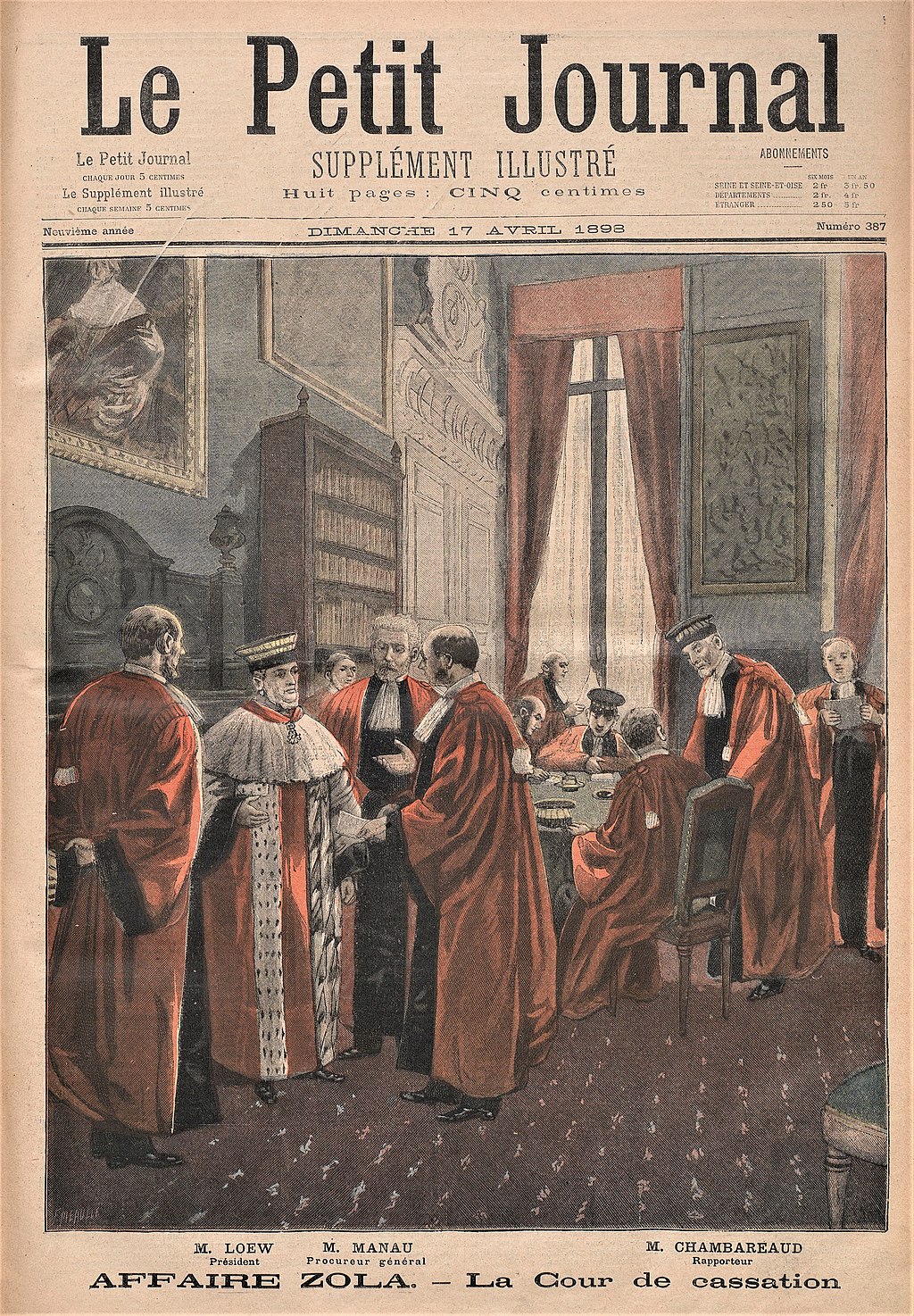 The judges of the criminal division in Le Petit Journal The Supreme Court considered the Dreyfus affair in the context of press campaigns against the Criminal Division, the magistrates being constantly dragged through the mud in nationalist newspapers from the Panama scandals.[183] On 26 September 1898, after a Cabinet vote, the Minister of Justice appealed to the Supreme Court. On 29 October 1898, after the submission of the report from the recorder Alphonse Bard, the Criminal Chamber of the Court stated that "the application is admissible and will proceed with a supplementary investigation".[184] The recorder Louis Loew presided. He was subjected to a very violent campaign of antisemitic insults due to his being an Alsatian Protestant accused of being a deserter and tainted by the Prussians. Despite the compliant silence of Mercier, Billot, Zurlinden, and Roget, who hid behind the authority of "already judged" and "state secret", understanding of the affair increased. Cavaignac made a statement two days long, but failed to prove the guilt of Dreyfus. On the contrary, he unwittingly exonerated him by a demonstration of the exact date of the bordereau (August 1894). Picquart then demonstrated all the workings of the error, then the conspiracy.[185] In a decision dated 8 December 1898 in response to his divestiture announcement, Picquart was protected from the military court by the Criminal Division of the Supreme Court.[186] This was a new obstacle to the wishes of the General Staff. A new furiously antisemitic press campaign burst during the event, while L'Aurore on 29 October 1898 published an article entitled Victory in the same character as J'accuse...![187] The work of the investigation was still to be taken back by the Criminal Division.[188] The "secret file" was analyzed from 30 December 1898 and the Criminal Division requested disclosure of diplomatic records, which was granted. On 9 February 1899, the Criminal Division submitted its report by highlighting two important facts: it was certain Esterhazy used the same paper as the bordereau and the secret file was completely void. These two major events alone destroyed all proceedings against Alfred Dreyfus. In parallel, President Mazeau conducted an inquiry by the Criminal Division, which led to divestiture thereof "to not only leave it to bear alone all responsibility for the final decision", so protecting the Criminal Division from actions arising from its report. On 28 February 1899, Waldeck-Rousseau spoke to the Senate on the floor and denounced "moral conspiracy" within the government and in the street. The review was no longer avoidable. On 1 March 1899, Alexis Ballot-Beaupré, the new president of the Civil Chamber of the Supreme Court, was appointed recorder for the consideration of the application for review. He took on the legal files and decided on a further investigation. Ten additional witnesses were interviewed, which further weakened the version of the General Staff. In the final discussion, President Ballot-Beaupré demonstrated the inanity of the bordereau, which was the only evidence against Dreyfus. The prosecutor Manau echoed the views of the President. Mornard who represented Lucie Dreyfus argued without any difficulty or opposition from the prosecution.[189] On 3 June 1899, the joint chambers of the Supreme Court overturned the judgment of 1894 in a formal hearing.[190] The case was referred to the Military Court of Rennes. By that judgment, the Supreme Court imposed itself as an absolute authority capable of standing up to military and political power.[191] For many Dreyfusards, this ruling was the prelude to the acquittal of the captain; they forgot to consider that it was again the army who would judge. The court, in overturning the judgement, believed in the legal autonomy of the military court without taking into account the laws of esprit de corps.[192] Fear of boycott Hannah Arendt writes that fear of an international boycott of the Paris Exposition of 1900 was what "united the disrupted country, turned parliament in favor of a retrial and eventually reconciled disparate elements" of France in a way "Clemenceau's daily editorials, Zola's pathos, Jaurès' speeches and popular hatred of the clergy and aristocracy" had not.[193] |
危機と政治状況の再構築 アンリは死に、ボワデッフルは辞職し、ゴンセにはもう何の権限もなく、デュ・パティはエステルハージによって大きく損なわれていた。政府は今、街頭のナ ショナリストの圧力と上層部の圧力という二つの火種に挟まれていた[175][tone]。カヴァニャックは、ドレフュサール事件に対する反ドレフュサー ル的な見方を広め続けたために辞任し、反革命派の指導者として台頭した。彼の後任で参謀本部の影響を受けたズルリンデン将軍は、1898年9月10日の閲 兵式で「閲兵式は戦争を意味する」と否定的な意見を述べ、過激派マスコミを慰めた。1898年9月26日、最高裁判所への差し戻しを決議した政府の頑迷さ は、ズルリンデンの辞任を招き、すぐにシャノワーヌ将軍が後任となった[176]。閣僚の不安定は政府の不安定を引き起こした。 1898年11月1日、ブリッソンの後任として進歩派のシャルル・デュピュイが任命された。1894年、彼はドレフュス事件の発端となったメルシエ将軍の 行動を庇い[177]、4年後には最高裁判所の判決に従うと表明し[178]、審査を圧殺し裁判所を分離しようとする者たちの行く手を阻んだ。1898年 12月5日、最高裁判所への「秘密ファイル」の送付に関する下院での議論の陰で、緊張はさらに高まった。侮辱、罵詈雑言、その他の民族主義的暴力が蜂起の 脅しへと発展した。ポール・デレドはこう宣言した: 「内戦が起こるのであれば、そうすればいい」[179]。 民事会議所のケスネ・ド・ボーレペール会頭が報道でドレフュス主義について刑事会議所を非難したためである。彼は1899年1月8日、民族主義の英雄とし て辞任した。この危機は、合同会議所のために刑事部を分割することにつながった。これが再検討の障害となった[180]。 1899年、ドレフュス事件はますます政治的な場面を占めるようになる。1899年2月16日、フランス大統領フェリックス・フォールが心臓発作で死去 し、エミール・ルベが選出された[181]。1899年2月23日、フォーレの葬儀の席上、ポール・デロレードはエリゼ宮でクーデターを強行しようとし た。しかし、軍部の支持は得られず、失敗に終わった。1899年6月4日、ルベはロンシャン競馬場で暴行を受けた。このような挑発行為に加え、極右勢力に よる恒常的なデモは、実際に共和国を危機に陥れることはなかったものの、共和主義を爆発させ、1899年6月22日にヴァルデック=ルソーを中心とする 「共和国防衛政府」が成立した。レイモン・ポアンカレをはじめとするフランス政界の中心は、親改革派と手を組んでいた。ジュール・メリーヌのような進歩的 な反ドレフュサール派の共和主義者は真っ向から否定された。ドレフュス事件は、フランスの政治状況の明確な再編成につながった[182]。 1894年の判決に対する控訴  『ル・プティ・ジャーナル』誌の刑事部の裁判官たち 1898年9月26日、閣議決定後、法務大臣は最高裁判所に上訴した。1898年10月29日、記録官アルフォンス・バルドからの報告書が提出された後、同裁判所刑事部は「申請は認められ、補充調査を行う」と述べた[184]。 記録官ルイ・ロエウが裁判長を務めた。彼は、アルザスのプロテスタントであり、脱走兵であり、プロイセンの汚名を着せられたという理由で、非常に激しい反 ユダヤ主義的侮辱キャンペーンを受けた。メルシエ、ビヨー、ズーリンデン、ロジェは、「すでに裁かれた」「国家機密」という権威の陰に隠れて従順に沈黙を 守っていたが、この事件への理解は深まった。カヴァイニャックは2日間にわたる声明を発表したが、ドレフュスの有罪を証明することはできなかった。それど ころか、ボルドローの正確な日付(1894年8月)を示すことで、知らず知らずのうちにドレフュスの容疑を晴らしていた。 1898年12月8日付の判決で、ピッカールは、彼の解任宣言に呼応して、最高裁判所刑事部によって軍事法廷から保護された[186]。1898年10月 29日付のL'Aurore紙は、「J'accuse...」と同じ性格の「勝利」と題する記事を掲載した[187]。 捜査の仕事は依然として刑事部によって引き取られることになった[188]。1898年12月30日から「秘密ファイル」が分析され、刑事部は外交記録の 開示を要求し、それは認められた。 1899年2月9日、刑事部は、エステルハージがボルドローと同じ紙を使用したことは確実であり、秘密ファイルは完全に無効であるという2つの重要な事実 を強調して報告書を提出した。この2つの重大な出来事だけで、アルフレッド・ドレフュスに対するすべての手続きが破棄された。これと並行して、マゾー大統 領は刑事部による調査を実施し、「最終的な決定に対するすべての責任を刑事部だけに負わせるだけでなく」、刑事部をその報告書に起因する行動から保護する ために、刑事部の権限を剥奪した。 1899年2月28日、ウォルデック=ルソーは上院の議場で演説し、政府内と市井の「道徳的陰謀」を糾弾した。見直しはもはや避けられないものとなった。 1899年3月1日、最高裁判所民事会議所の新議長アレクシス・バロ=ボプレが、再審査申請審議の記録係に任命された。バロト=ボープレは訴訟資料を担当 し、さらなる調査を決定した。10人の証人が追加尋問され、参謀本部の見解はさらに弱められた。最終的な討議で、バロット=ボープレ大統領は、ドレフュス に不利な唯一の証拠であったボルドローの無意味さを示した。マナウ検事も大統領の意見に同調した。リュシー・ドレフュスの代理人であったモルナールは、検 察側の反対もなく、難なく弁論を行った[189]。 1899年6月3日、最高裁判所の合同法廷は、正式な審理において1894年の判決を覆した[190]。多くのドレフュス派にとって、この判決は大尉の無 罪判決への序曲であった。裁判所は判決を覆すにあたって、エスプリの法則を考慮することなく軍事裁判所の法的自治を信じた[192]。 ボイコットへの恐怖 ハンナ・アーレントは、1900年のパリ万国博覧会に対する国際的なボイコットへの恐怖が、「クレマンソーの毎日の社説、ゾラのパトス、ジョレスの演説、 そして聖職者と貴族に対する民衆の憎悪」にはなかった方法で、フランスの「混乱した国を団結させ、議会を再審に賛成させ、最終的にばらばらの要素を和解さ せた」ものであったと書いている[193]。 |
| The trial in Rennes 1899 Conduct of the trial 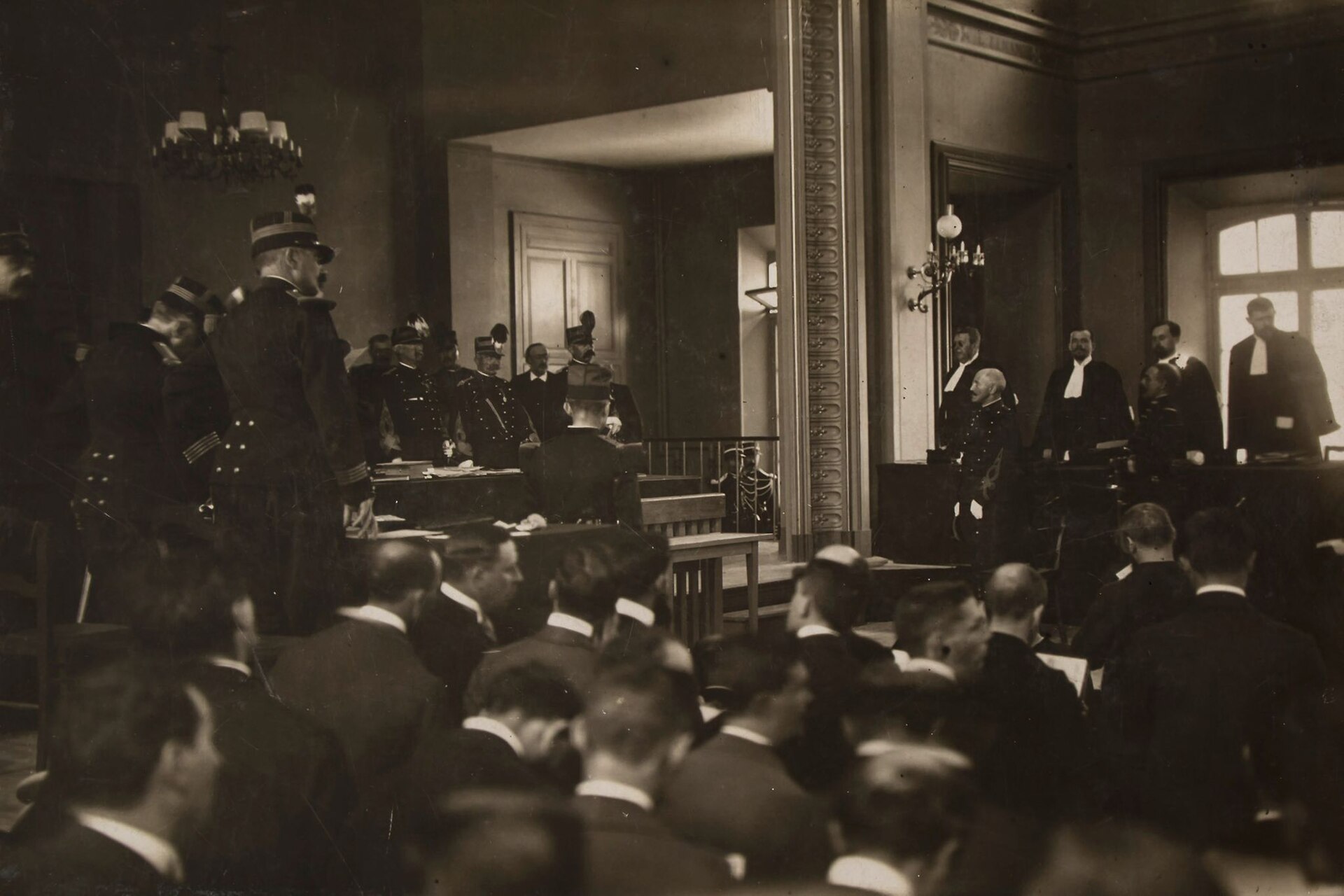 Alfred Dreyfus (standing, right of centre) at the opening session of his trial in Rennes, photographed by Valerian Griboedov Alfred Dreyfus was in no way aware of what was happening thousands of kilometres from him. Neither was he aware of the schemes hatched to guarantee that he could never return, or the commitment of countless men and women to his cause. The prison administration filtered information deemed confidential. At the end of 1898, he learned with astonishment the actual size of the affair, about which he knew nothing: the accusation by his brother against Esterhazy, the acquittal of the traitor, Henry's confession and suicide, and the reading of the record of investigations of the Supreme Court, which he received two months after its publication.[194] On 5 June 1899, Alfred Dreyfus was notified of the decision of the Supreme Court on the judgment of 1894. On 9 June 1899, he left Devil's Island, heading to France, but locked in a cabin as if guilty, even though he no longer was. He disembarked on 30 June 1899 in Port Haliguen on the Quiberon peninsula in the greatest secrecy, "a clandestine and nocturnal return".[195] After five years of imprisonment, he was on his native soil, but he was immediately locked up from 1 July 1899 in the military prison in Rennes. He was remanded on 7 August 1899 before the military court of the Breton capital. General Mercier, champion of the anti-Dreyfusards, intervened constantly in the press to confirm the accuracy of the first judgement: Dreyfus was surely guilty. Immediately, however, dissent emerged in the defence of Dreyfus. His two lawyers actually had opposing strategies. Demange wanted to stand on the defensive and just get the acquittal of Dreyfus. Labori, a brilliant lawyer who was just 35 years old, wanted to take the offensive, to aim higher and defeat and publicly humiliate the General Staff. Mathieu Dreyfus imagined a complementarity between the two lawyers. The conduct of the trial revealed the disunity that served the prosecution with a defence so impaired. 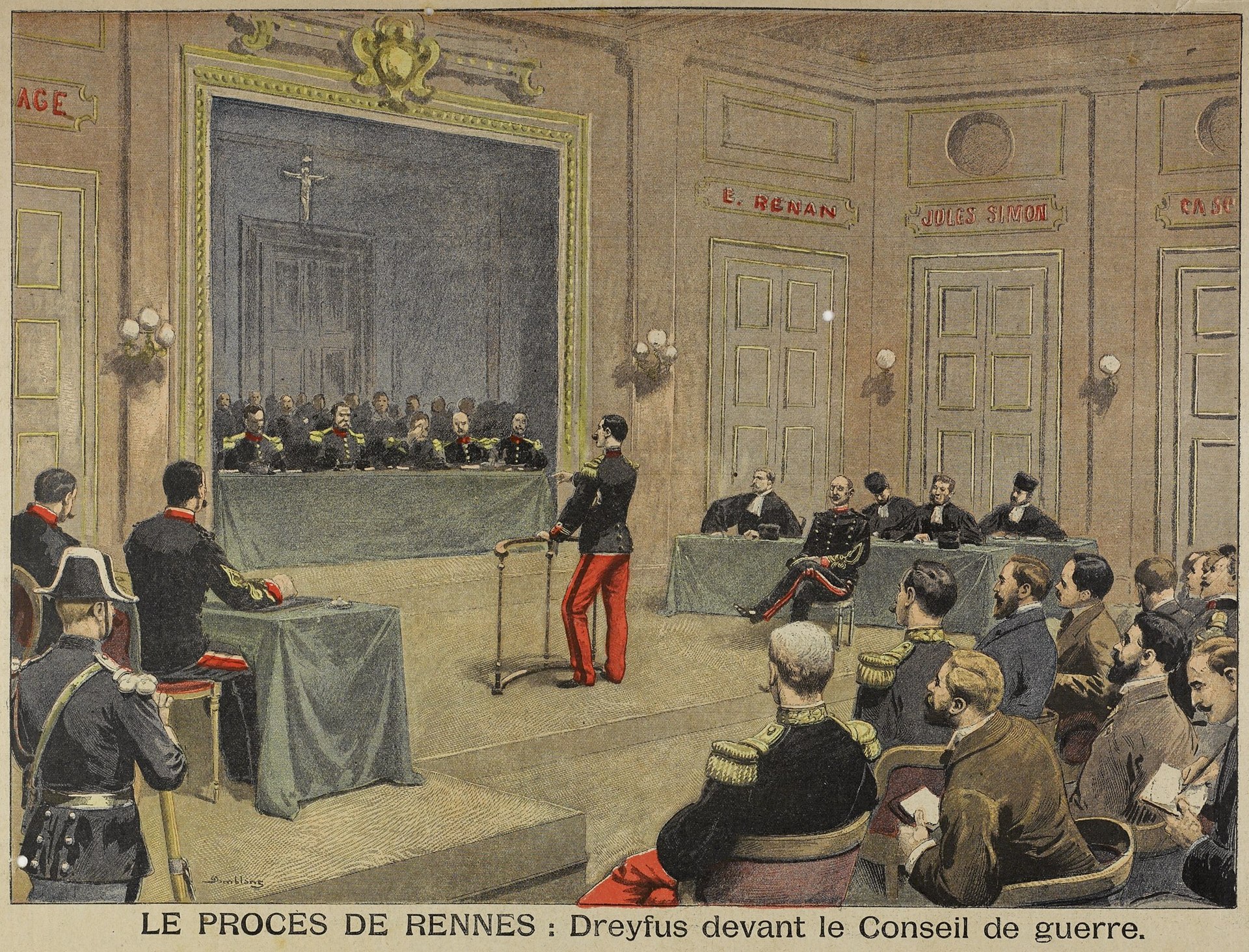 Alfred Dreyfus's trial at the Rennes Court Martial The trial opened on 7 August 1899 in an atmosphere of extreme tension. Rennes was in a state of siege.[196] The judges of the court-martial were under pressure. Esterházy, who admitted authorship of the bordereau, was in exile in England. He and du Paty were both excused. On the appearance of Dreyfus, emotions ran high. His physical appearance disturbed his supporters and some of his opponents.[Note 17] Despite his deteriorated physical condition, he had a complete mastery of the files acquired in only a few weeks.[197] All the General Staff testified against Dreyfus without providing any proof. They stubbornly considered null and void the confessions of Henry and Esterhazy. The trial even tended to go out of control to the extent that the decisions of the Supreme Court were not taken into account. They discussed in particular the bordereau, which was the proof of guilt of Esterhazy. Nevertheless Mercier was booed at the end of the hearing. The nationalist press and the anti-Dreyfusards could only speculate on his silence about the "conclusive evidence" (the pseudo-note annotated by Emperor Wilhelm II, which nobody will ever see in evidence) that he had not ceased to report before the trial.  Dreyfus's defense in Rennes: Edgar Demange and Fernand Labori On 14 August 1899, Labori was on his way to court when he was shot in the back by an extremist who escaped and was never found. The lawyer was missing from discussions for over a week at the decisive moment of the examination of witnesses. On 22 August 1899, his condition had improved and he returned. Incidents between the two lawyers for Dreyfus multiplied. Labori reproached Demange about his excessive caution. The government, in the face of the military hardening stance, still had two ways to influence events: call for testimony from Germany or abandon the charge.[198] These negotiations in the background, however, had no result. The German Embassy sent a polite refusal to the government. The Minister of War, General Gaston de Galliffet, sent respectful word to Major Louis Carrière, the government commissioner. He asked him to act in the spirit of the revised judgment of the Supreme Court. The officer pretended not to understand the allusion and helped the nationalist lawyer Auffray to make the indictment against Dreyfus. The defence needed to make a decision because the outcome of the case looked bad, despite evidence of the absence of charges against the accused. On behalf of the president of the council, Pierre Waldeck-Rousseau, aided by Zola and Jaurès, Labori was convinced to give up his argument so as not to offend the military. They decided to risk conciliation in exchange for the acquittal that seemed to be promised by the government.[199] Mr. Demange, alone and without illusions, continued the defence of Dreyfus in an atmosphere of civil war. In Paris, the antisemitic and nationalist agitators of Auteuil were arrested. Jules Guérin and those who fled and holed up in Fort Chabrol were assaulted by the police. New conviction 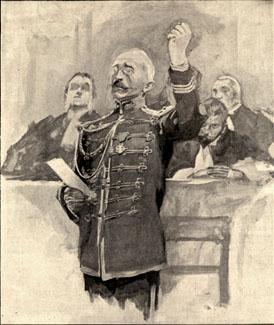 Dreyfus's reconviction On 9 September 1899, the court rendered its verdict: Dreyfus was convicted of treason, but "with extenuating circumstances" (by five votes to two) and sentenced to ten years' imprisonment and a further degradation. Contrary to appearances, this verdict was on the verge of acquittal by one vote. The Code of Military Justice adopted the principle that a minority vote of three against four was an acquittal.[200] The day after the verdict, Alfred Dreyfus, after much hesitation, filed an appeal for a retrial. Waldeck-Rousseau, in a difficult position, tackled for the first time the possibility of a pardon. Dreyfus had to accept guilt. Exhausted, having been away from his family for too long, he accepted. The decree was signed by President Émile Loubet on 19 September 1899 and Dreyfus was released on 21 September 1899. Many Dreyfusards were frustrated by this final act. Public opinion welcomed this conclusion indifferently. France wanted civil peace and harmony on the eve of the Universal Exhibition of 1900 and before the big fight that the Republic was about to take for freedom of association and secularism. It was in this spirit that on 17 November 1899, Waldeck-Rousseau filed an amnesty law covering "all criminal acts or misdemeanours related to the Dreyfus affair or that have been included in a prosecution for one of these acts" excluding only Alfred Dreyfus himself who was instead pardoned to be able to still seek acquittal. Many Dreyfusards protested as this indemnified not only Zola and Picquart against (further) punishment but also protected the real culprits. Despite these massive protests the bill was passed. Reactions 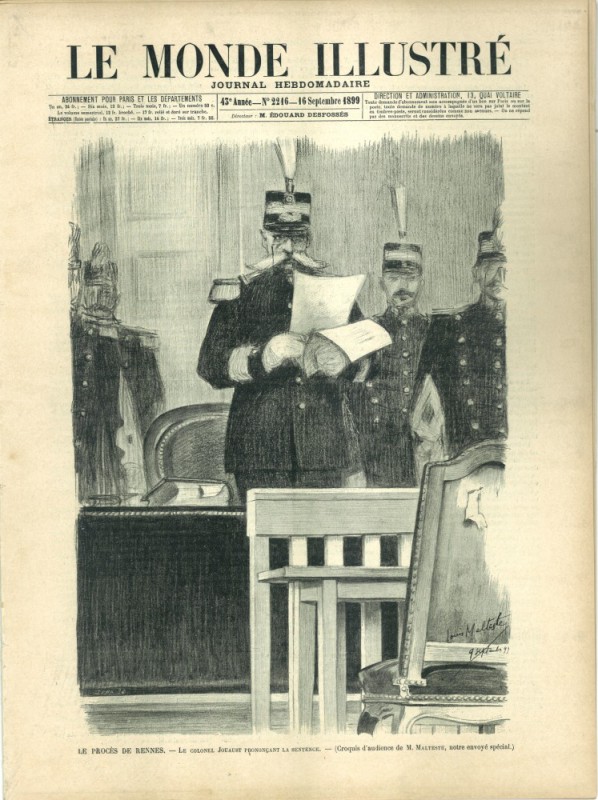 Cover of the weekly Le Monde illustré showing Colonel Albert Jouaust, Chairman of the Court Martial, reading the verdict of conviction Reactions in France were strong, consisting of "shock and sadness" in the revisionist camp.[201] Still other reactions tended to show that the "verdict of appeasement" made by the judges was understood and accepted by the population. The Republicans sought above all social peace and to turn the page on this extremely long and controversial affair. Also there were very few demonstrations in the provinces while agitation persisted somewhat in Paris.[202] In the military world appeasement was also essential. Two of the seven judges voted for acquittal.[203] They refused to yield to the implied military order. This was also clearly seen. In an apostrophe for the army, Galliffet announced: "The incident is closed". Anti-French demonstrations took place in twenty foreign capitals and the press was outraged.[204] Reactions were twofold. Norwegian composer Edvard Grieg cancelled his concerts in France in protest.[205] The British, as legalists, focused on espionage and challenged rather strongly this conviction devoid of positive arguments in its construction. As such the report of the Lord Chief Justice of England, Lord Russell of Killowen, on 16 September 1899, was a symbol of the global effect of the affair in the United Kingdom. Russell, who went as an observer to Rennes, criticised the weaknesses of the Military Court: The Military judges were not familiar with the law or criminal proceedings. They lacked the experience and skill that can see the evidence behind the evidence. They were drowning in prejudice and they acted according to what they saw as the honour of the army. Impressed, full of respect for their superiors, they accorded too much importance to fragile allegations that were only made against the accused." Thus he concluded: "For surely it might have been predicted with certainty that, if the revision trial had taken place before the Cour de cassation ... Dreyfus would now be a free man.[206] In Germany and Italy, the two countries widely challenged by lawsuits against Dreyfus, there was relief. Even if the German Emperor regretted that the innocence of Dreyfus was not recognized, the normalization of future Franco-German relations was seen as a welcome relaxation. Diplomacy between the three powers with the help of England sought to relax in an atmosphere that deteriorated again on the eve of the First World War. This judicial conclusion also had an unfortunate consequence for the relationship between the Dreyfus family and the branch of Ultra-Dreyfusards. Fernand Labori, Jaures, and Clemenceau, with the consent of Picquart openly accused Alfred Dreyfus of accepting the pardon and only gently protesting the amnesty law.[207] |
1899年レンヌでの裁判 裁判の進行  レンヌでの裁判開廷時のアルフレッド・ドレフュス(中央右、ヴァレリアン・グリボエードフ撮影 アルフレッド・ドレフュスは、自分から何千キロも離れた場所で何が起きているのか、まったく知らなかった。ドレフュスが二度と戻れないことを保証するため に企てられた計画も、彼の大義に無数の男女が献身していることも、彼は知る由もなかった。刑務所の管理部門は、機密とみなされる情報をフィルタリングして いた。1899年6月5日、アルフレッド・ドレフュスは1894年の判決に関する最高裁判所の決定を知らされた。1899年6月9日、ドレフュスは悪魔の 島を出発し、フランスに向かったが、もはや有罪ではなかったにもかかわらず、有罪であるかのようにキャビンに閉じ込められた。1899年6月30日、彼は キブロン半島のハリグアン港で、「密かに、夜間に戻る」という極秘のうちに下船した[195]。5年間の投獄の後、彼は祖国の地を踏んだが、1899年7 月1日からすぐにレンヌの軍事刑務所に収監された。1899年8月7日、彼はブルトン首都の軍事法廷に勾留された。 反ドレフュサール派の擁護者であったメルシエ将軍は、最初の判決の正確さを確認するため、絶えずマスコミに介入した: ドレフュスは間違いなく有罪だった。ドレフュスは有罪に違いない。しかし、すぐにドレフュス擁護派に反対意見が現れた。ドレフュスの弁護を担当した二人の 弁護士は、実のところ相反する戦略を持っていた。ドゥマンジュは守勢に立ち、ドレフュスの無罪を勝ち取ろうとした。35歳の若さで優秀な弁護士であったラ ボリは、攻勢に転じ、より高い目標を掲げて参謀本部を打ち負かし、公に恥をかかせようとした。マチュー・ドレフュスは、二人の弁護士の間に補完関係がある ことを想像していた。裁判の進行は、弁護に支障をきたした検察側の不和を露呈した。  レンヌ軍法会議でのアルフレッド・ドレフュスの裁判 裁判は1899年8月7日、極度の緊張の中で始まった。レンヌは包囲された状態にあった[196]。軍法会議の判事たちは重圧にさらされていた。ボルド ローの作者であることを認めたエステルハージはイギリスに亡命していた。彼とデュ・パティは共に免責された。ドレフュスが出廷すると、感情が高ぶった。ド レフュスの容貌は、彼の支持者と一部の反対者を不安にさせた[注 17]。体調が悪化していたにもかかわらず、彼はわずか数週間で入手したファイルを完全に使いこなしていた[197]。参謀本部は全員、何の証拠も示さず にドレフュスに不利な証言をした。彼らは頑なにアンリとエステルハージの自白を無効とみなした。裁判は、最高裁判所の決定が考慮されないほど制御不能にな る傾向さえあった。彼らは特に、エステルハージの有罪の証拠であるボルドローについて議論した。それにもかかわらず、メルシエは審理終了時にブーイングを 浴びた。国粋主義的なマスコミと反ドレフュス派は、彼が裁判の前に報道を止めなかった「決定的証拠」(皇帝ヴィルヘルム2世が注釈をつけた偽のノートで、 誰も証拠として見ることはない)についての沈黙について推測するしかなかった。  レンヌでのドレフュスの弁護: エドガー・ドゥマンジュとフェルナン・ラボリ 1899年8月14日、ラボリは法廷に向かう途中、過激派に背後から撃たれ、逃走したまま発見されなかった。この弁護士は、証人尋問の決定的な場面で1週 間以上も議論から姿を消していた。1899年8月22日、病状は回復し、戻ってきた。ドレフュスの弁護を担当する二人の弁護士の間に事件は絶えなかった。 レイボリはドゥマンジェの過剰な警戒心を非難した。しかし、こうした水面下での交渉は何の結果も生まなかった。ドイツ大使館は政府に対して丁重な断りを入 れた。陸軍大臣ガストン・ド・ガリフェ将軍は、政府委員ルイ・カリエール少佐に丁重な言葉を送った。彼は、最高裁判所の修正判決の精神に従って行動するよ う求めた。カリエール少佐はその言葉を理解しないふりをし、民族主義者の弁護士オフレにドレフュスに対する起訴状を作成させた。被告人不起訴の証拠がある にもかかわらず、裁判の結果が思わしくなかったため、弁護側は決断を下す必要があった。評議会議長のピエール・ワルデック=ルソーの代理として、ゾラと ジョレスの助力もあり、ラボリは軍部の機嫌を損ねないように自分の主張をあきらめるよう説得された。ドゥマンジュは一人で、幻想を抱くことなく、内戦の雰 囲気の中でドレフュスの弁護を続けた。パリでは、オートゥイユの反ユダヤ主義者と民族主義者が逮捕された。ジュール・ゲランとシャブロル砦に立てこもった 逃亡者たちは警察に暴行された。 新たな有罪判決  ドレフュスの再起訴 1899年9月9日、裁判所は判決を下した: ドレフュスは国家反逆罪で有罪判決を受けたが、「情状酌量の余地あり」とされ(5票対2票)、10年の禁固刑とさらなる劣化を言い渡された。見た目とは裏 腹に、この評決は1票差で無罪となる寸前だった。軍事裁判規範は、3票対4票の少数決は無罪であるという原則を採用していた[200]。 評決の翌日、アルフレッド・ドレフュスは逡巡の末、再審請求を行った。ウォルデック=ルソーは困難な立場に立たされ、初めて恩赦の可能性に取り組んだ。ド レフュスは罪を受け入れなければならなかった。長い間家族と離れていたため、疲れ果てていたドレフュスは、それを受け入れた。勅令は1899年9月19日 にエミール・ルベ大統領によって署名され、ドレフュスは1899年9月21日に釈放された。多くのドレフュス派は、この最後の行為に不満を抱いた。世論は この結論を無関心に歓迎した。フランスは1900年の万国博覧会を控え、結社の自由と世俗主義のために共和国が挑む大きな戦いの前に、市民の平和と調和を 望んでいた。 1899年11月17日、ヴァルデック=ルソーは、「ドレフュス事件に関連する、またはそのいずれかの罪で起訴されたすべての犯罪行為や軽犯罪」を対象と する恩赦法を提出した。多くのドレフュス派は、これはゾラとピカールを(さらなる)処罰から免責するだけでなく、真犯人を保護するものであるとして抗議し た。こうした大規模な抗議にもかかわらず、法案は可決された。 反応  軍法会議議長のアルベール・ジュオスト大佐が有罪判決を読み上げる『週刊ル・モンド』の表紙。 フランス国内の反応は強く、修正主義陣営の「衝撃と悲しみ」から成っていた[201]。さらに他の反応は、裁判官の下した「宥和判決」が国民に理解され受 け入れられたことを示す傾向にあった。共和党は何よりも社会的な平和を求め、このきわめて長く物議をかもした事件に終止符を打とうとした。また、地方では デモはほとんど起こらなかったが、パリでは煽動がいくらか続いた[202]。 軍事界でも宥和は不可欠であった。7人の判事のうち2人が無罪に投票した[203]。 彼らは暗黙の軍命令に屈することを拒否した。このこともはっきりと見て取れた。ガリフェは軍へのアポストロフィーとして、こう宣言した: 「事件は終結した」。 20の外国の首都で反フランスデモが起こり、マスコミは憤慨した[204]。ノルウェーの作曲家エドヴァルド・グリーグは抗議のためにフランスでのコン サートをキャンセルした[205]。 イギリスは法律家としてスパイ行為に焦点を当て、その構成において肯定的な論拠を欠いたこの確信にかなり強く異議を唱えた。そのため、1899年9月16 日に発表されたイギリス司法長官キローウェンのラッセル卿の報告書は、イギリスにおけるこの事件の世界的な影響を象徴するものであった。レンヌにオブザー バーとして赴いたラッセルは、軍事法廷の弱点を批判した: 軍の裁判官は法律や刑事手続きに精通していなかった。彼らは証拠の背後にある証拠を見抜く経験と技術を欠いていた。彼らは偏見に溺れ、軍の名誉のために行 動した。感銘を受け、上官への敬意に満ち、被告人だけに向けられた脆弱な申し立てを重要視しすぎた。彼はこう締めくくった: 「もし改正裁判がカッサシオン裁判所で行われていたら......。ドレフュスは今や自由人になっていたであろう」[206]。 ドイツとイタリアでは、ドレフュスに対する訴訟が広く争われていたが、救済があった。たとえドイツ皇帝がドレフュスの無実が認められなかったことを残念に 思っていたとしても、将来の独仏関係の正常化は歓迎すべき緩和と見なされた。第一次世界大戦の前夜に再び悪化した雰囲気の中で、イギリスの助けも得て、三 国間の外交は緩和されようとした。 この司法上の結論は、ドレフュス家とウルトラ・ドレフュサール派の関係にも不幸な結果をもたらした。フェルナン・ラボリ、ジャウール、クレマンソーは、ピ カールの同意を得て、アルフレッド・ドレフュスが恩赦を受け入れ、恩赦法に穏やかに抗議しただけだと公然と非難した[207]。 |
| Rehabilitation, 1900–1906 Main article: Resolution of the Dreyfus affair Preferring to avoid a third trial the government decided to pardon Dreyfus by a decree signed by President Émile Loubet on 19 September 1899 after much hesitation. Dreyfus was not found innocent. The rehabilitation process was not completed until six years later, when passions had cooled. Many books appeared during this period. In addition to the memoires of Alfred Dreyfus,[208] Reinach published his History of the Dreyfus Affair and Jaurès published The Proofs. As for Zola, he wrote the third of his Gospels: Truth. Even Esterhazy took advantage of his secrets and sold several different versions of the text of his statement to the consul of France.[209] Death of Zola On 29 September 1902, Zola, who was the initiator of The Affair and the first of the intellectual Dreyfusards, died, asphyxiated by fumes from his chimney. His wife, Alexandrine, narrowly escaped.[210] It was a shock for the Dreyfusard clan. Anatole France, who demanded that Dreyfus be present at the funeral while the Chief of Police wanted his absence "to avoid problems", read his funeral oration for the author of "J'accuse...! 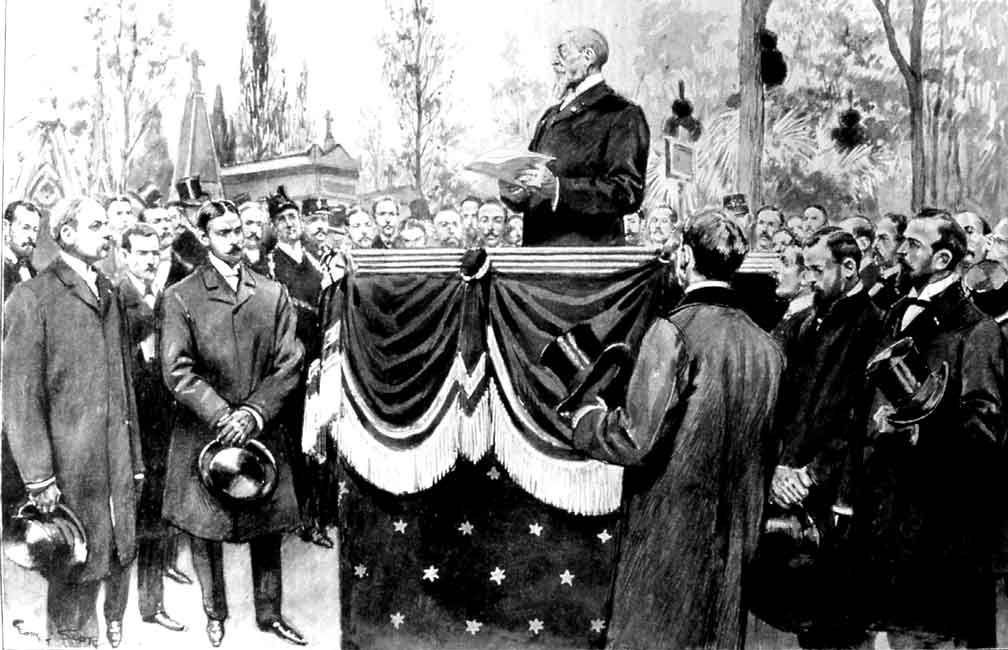 The funeral of Zola, where Anatole France paid homage to his friend In 1953, the newspaper Libération published a death-bed confession by a Parisian roofer that he had murdered Zola by blocking the chimney of his house.[211] The semi-rehabilitation Legal rehabilitation 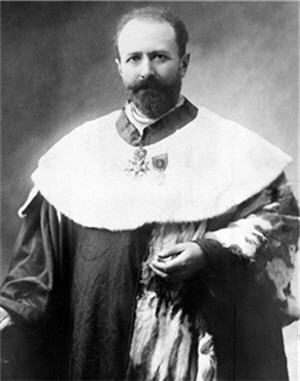 Manuel Baudoin [d], attorney general at the heart of the rehabilitation of Dreyfus The elections of 1902 saw the victory of the left. Jean Jaurès was re-elected and he revived the affair on 7 April 1903 while France thought the affair buried forever. In a speech Jaurès evoked the long list of falsehoods peppering the Dreyfus case, and placed particular emphasis on two things. First, the letter of resignation from Pellieux, which was worded in very harsh terms. Legally, it formed an admission of the collusion of the General Staff: [It] dupes people without honour [and] can no longer rely on the trust of subordinates, without which command is impossible. For my side I can not trust any of my chiefs who have been working on falsehoods, I ask for my retirement. In addition, the note allegedly annotated (by Kaiser Wilhelm II), which General Mercier had alluded to at the Rennes trial, which is reported by the press to have influenced the judges of the Military Court.[Note 18][212][213] Given these developments, General Louis André, the new Minister of War, led an investigation at the instigation of Émile Combes and assisted by judges. The investigation was conducted by Captain Antoine Louis Targe, aide to the minister. During searches of the Statistics Section he discovered numerous documents, most of which were obviously fabricated.[214] In November 1903 a report was submitted to the Minister of Justice by the Minister of War. This was in compliance with the regulations since the Minister found an error committed by the Military Court. This was the beginning of a new review led by lawyer Ludovic Trarieux, the founder of the League of Human Rights, with a thorough investigation to run over two years. The years 1904 and 1905 were devoted to different legal phases before the Court of Cassation. The court identified three events (grounds) for review, the demonstration of the falsification of the Panizzardi telegram, demonstration of a date change on a document in the 1894 trial (April 1895 changed to April 1894) and demonstration of the fact that Dreyfus had not removed the minutes related to heavy artillery in the army. 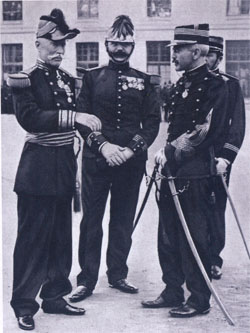 At right, Captain Alfred Dreyfus rehabilitated at Les Invalides, talks with General Gillain [d]. In the centre, Targe, investigator and discoverer of many falsehoods. With regard to the writing of the bordereau, the court was particularly severe against Alphonse Bertillon who "reasoned badly on forged documents". The report[Note 19] showed that the writing was certainly by Esterhazy and that the latter had also confessed subsequently. Finally the Court demonstrated by a comprehensive and skilled analysis of the bordereau the futility of this purely intellectual construction and a commission of four headed by a general of artillery, General Sebert, maintained "it is highly unlikely that an artillery officer could write this missive".[215] On 9 March 1905, Attorney-General Baudouin delivered an 800-page report in which he demanded the convictions be quashed without further reference to another court and denounced the army. He began a divestiture of the military justice system, which did not conclude until 1982.[216] It was not until 12 July 1906 that the Court of Cassation unanimously cancelled the judgment without reference to the military trial at Rennes in 1899 and pronounced "the end of the rehabilitation of Captain Dreyfus". The anti-Dreyfusards protested at this hasty rehabilitation. The goal was obviously political: it was to finish and finally turn the page. Nothing could dent the conviction of the opponents of Dreyfus. This method was the most direct and most definitive. What was annulled not only put a stop to Rennes, but the entire chain of prior acts, beginning with the arraignment order given by General Saussier in 1894. The Court focused on the legal aspects only and observed that Dreyfus did not have a duty to be returned before a Military Court for the simple reason that it should never have taken place due to the total absence of charges: Whereas in the final analysis of the accusation against Dreyfus nothing remains standing and setting aside the judgment of the Military Court leaves nothing that can be considered to be a crime or misdemeanour; therefore by applying the final paragraph of Article 445 no reference to another court should be pronounced. Subsequent career  Alfred Dreyfus in 1935, the year of his death Dreyfus was reinstated in the army with the rank of artillery major by law on 13 July 1906. This reflected the rank to which he could reasonably have been expected to have risen had his career not been interrupted by the false charges against him.[217] However, Dreyfus and his supporters were disappointed that his five years of imprisonment were not taken into account for the reconstruction of his career and that his promotion to major was back-dated only to 10 July 1903.[217] This decision blocked any hope of a career worthy of his past successes before his arrest in 1894. After serving for a year as commander of the artillery depot at Fort Neuf de Vincennes, Major Dreyfus retired in June 1907; a decision taken in part because of recurrent tropical fevers and chronic fatigue arising from the strain of his imprisonment.[218] On 4 June 1908, on the occasion of the transfer of the ashes of Émile Zola to the Pantheon, Alfred Dreyfus was the target of an attack. Louis Grégori, an extreme right-wing journalist and assistant of Drumont, fired two shots from a revolver and wounded Dreyfus slightly in the arm. He was driven to do this for Action Française (French Action) not only to disrupt the ceremony for the "two traitors" Zola and Dreyfus, but also to remake the Dreyfus trial through a new trial, a revenge of some sort.[219] The trial was at the Assises of the Seine, where Grégori was acquitted – the latest in a long series of judicial misconducts. It was an occasion for new antisemitic riots that the government suppressed half-heartedly.[220] As a reserve officer, Dreyfus participated in the First World War of 1914–1918, serving as head of the artillery depot at a fortified camp near Paris and commander of a supply column. In 1917 he saw frontline service at the Chemin des Dames and Verdun. Apart from Major Du Paty de Clam, Dreyfus was the only officer directly involved in the affair to serve in the war.[221] Having been named as a Chevalier of the Legion of Honour at the time of his reinstatement in 1906, Dreyfus was promoted to the rank of officer of the Legion of Honour in 1919. His son, Pierre Dreyfus, also served in World War I as an artillery officer and was awarded the Croix de Guerre. Alfred Dreyfus's two nephews also fought as artillery officers in the French Army and both were killed. The same artillery piece (the Obusier de 120 mm C modèle 1890), the secrets of which Dreyfus was accused of revealing to the Germans, was among those used in blunting the early German offensives. He ended his military career as a colonel.[222] Dreyfus died on 12 July 1935 at the age of seventy-five. His funeral cortège passed through ranks assembled for Bastille Day celebrations at the Place de la Concorde and he was buried in Montparnasse Cemetery. Colonel Picquart was also officially rehabilitated and reintegrated into the army with the rank of Brigadier general. Picquart was Minister of War from 1906 to 1909 in the first Clemenceau government; he died in January 1914 in a horse riding accident.[223] On July 21, 1935, The New York Times published a feature by Walter Littlefield headlined “Dreyfus Unaware to End He Had Been Victim of Plot…” The piece fills 2 full pages and leads with the statement that the truth could not be published during Dreyfus' lifetime “because while he lived this would have caused him pain and resentment.”[224] |
リハビリテーション、1900-1906年 主な記事 ドレフュス事件の解決 3度目の裁判を避けるため、政府は1899年9月19日、エミール・ルベ大統領による勅令によってドレフュスを赦免することを決定した。ドレフュスの無実 は認められなかった。更生手続きが完了したのは、6年後、情熱が冷めてからであった。この間に多くの本が出版された。アルフレッド・ドレフュスの回想録に 加え[208]、ライナッハは『ドレフュス事件史』を出版し、ジョレスは『証拠』を出版した。ゾラに関しては、『福音書』の3作目を執筆した: 真理』である。エステルハージでさえも彼の秘密を利用し、彼の声明文のいくつかの異なるバージョンをフランスの領事に売りつけた[209]。 ゾラの死 1902年9月29日、『情事』の発案者であり、知的ドレフュザードの第一人者であったゾラは、煙突からのガスで窒息死した。妻のアレクサンドリーヌは間 一髪で助かったが[210]、ドレフュサール一族にとっては衝撃的な出来事だった。アナトール・フランスは、ドレフュスの葬儀への参列を要求したが、警察 署長は「問題を避けるため」欠席を望み、『J'accuse...』の作者のために葬儀のオラショを読んだ!  アナトール・フランスが友人に敬意を表したゾラの葬儀 1953年、『リベラシオン』紙は、パリの屋根葺き職人がゾラの家の煙突を塞いでゾラを殺害したという死の床での告白を掲載した[211]。 半リハビリテーション 法的リハビリテーション  ドレフュス更生の中心となった司法長官マニュエル・ボードワン[d]。 1902年の選挙では左派が勝利した。ジャン・ジョレスが再選を果たし、1903年4月7日にドレフュス事件を復活させた。ジョレスは演説の中で、ドレ フュス事件にまつわる長い虚偽のリストを想起させ、特に二つのことを強調した。第一に、ペリューからの辞表である。この辞表は非常に厳しい言葉で書かれて いた。法的には、参謀本部の共謀を認めたことになる: [参謀本部は)名誉なき人間を騙しており、もはや部下の信頼に頼ることはできない。私としては、虚偽の仕事をしてきた参謀の誰一人として信用できない。 加えて、メルシエ将軍がレンヌの裁判で言及したとされる(カイザー・ヴィルヘルム2世による)注釈付きメモが、軍事裁判所の裁判官たちに影響を与えたと報道されている[注釈 18][212][213] 。 このような動きを受けて、新しい陸軍大臣であったルイ・アンドレ将軍は、エミール・コンブの扇動と裁判官の支援によって調査を指揮した。調査は大臣補佐官 のアントワーヌ・ルイ・タージュ大尉によって行われた。統計課の捜索中に、彼は多数の文書を発見したが、そのほとんどは明らかに捏造されたものであった [214]。1903年11月、陸軍大臣によって報告書が法務大臣に提出された。陸軍大臣は軍事裁判所の誤りを発見したので、これは規則に従ったもので あった。これは人権連盟の創設者である弁護士ルドヴィク・トラリューが率いる新たな見直しの始まりであり、2年にわたる徹底的な調査が行われた。1904 年と1905年は、大審院での様々な法的段階に費やされた。パニツァルディ電報の改ざん、1894年の裁判における文書の日付変更(1895年4月が 1894年4月に変更された)、ドレフュスが軍の重砲に関する議事録を削除していないことの証明である。  右は、アンヴァリッドで社会復帰したアルフレッド・ドレフュス大尉がジラン将軍[d]と話す。中央は、調査官であり多くの虚偽を発見したタルジュ。 ボルドローの作成に関して、法廷は「偽造文書でひどい理屈をこねた」アルフォンス・ベルティヨンに特に厳しく当たった。報告書[注釈 19]は、この書き込みは確かにエステルハージによるものであり、エステルハージもその後自白していることを示した。最終的に裁判所は、ボルドローの包括 的かつ熟練した分析によって、この純粋に知的な構成が無益であることを示し、砲兵大将セベール将軍が率いる4人の委員会は「砲兵将校がこの親書を書くこと は非常にあり得ない」と主張した[215]。 1905年3月9日、ボードゥアン検事総長は800ページに及ぶ報告書を提出し、その中で、別の法廷に諮ることなく有罪判決を破棄するよう要求し、軍を糾 弾した。216年] カッサシオン裁判所が全会一致で1899年のレンヌでの軍事裁判に言及することなく判決を取り消し、「ドレフュス大尉の更生の終結」を宣言したのは 1906年7月12日のことであった。反ドレフュス派はこの性急な更生に抗議した。その目的は明らかに政治的なものであった。ドレフュス反対派の信念をへ し折ることはできなかった。この方法は最も直接的で決定的なものだった。取り消されたのは、レンヌだけでなく、1894年にソシエ将軍が下した罪状認否命 令から始まる一連の先行行為全体であった。法廷は法的側面だけに注目し、ドレフュスには軍事法廷に引き出される義務はなかったとした: ドレフュスに対する告発の最終的な分析においては、何も残っておらず、軍事法廷の判決を破棄しても、犯罪または軽罪とみなされるものは何も残らないのであるから、第445条最終項を適用して、他の法廷への付託は宣告されるべきではない。 その後の経歴  1935年、アルフレッド・ドレフュス死去の年 ドレフュスは1906年7月13日、法律により砲兵少佐の階級で復職した。しかし、ドレフュスとその支持者たちは、彼の5年間の投獄生活が彼の経歴の再構 築に考慮されず、少佐への昇進が1903年7月10日までしか遡及されなかったことに失望した[217]。この決定によって、1894年に逮捕される前の 彼の過去の成功にふさわしい経歴の望みは絶たれた。ドレフュス少佐はヌフ・ド・ヴァンセンヌ要塞の砲兵部隊司令官として1年間勤務した後、1907年6月 に退役した。 1908年6月4日、エミール・ゾラの遺灰がパンテオンに移された際、アルフレッド・ドレフュスは攻撃の標的となった。極右ジャーナリストでドラモンの助 手だったルイ・グレゴリはリボルバーで2発撃ち、ドレフュスの腕に軽傷を負わせた。彼はアクション・フランセーズ(フランス・アクション)のために、「二 人の反逆者」ゾラとドレフュスの式典を妨害するためだけでなく、新たな裁判によってドレフュス裁判を作り直す、ある種の復讐をするために、このような行動 に駆り立てられた[219]。裁判はセーヌ河畔のアシスで行われ、グレゴリは無罪となった。それは新たな反ユダヤ主義的暴動のきっかけとなり、政府は半ば 強引にこれを鎮圧した[220]。 予備役将校として、ドレフュスは1914年から1918年の第一次世界大戦に参加し、パリ近郊の要塞化されたキャンプで砲兵部隊長や補給部隊の指揮官を務 めた。1917年にはシュマン・デ・ダムとヴェルダンで最前線に立った。1906年の復員時にレジオン・ドヌール勲章シュヴァリエに叙されたドレフュス は、1919年にレジオン・ドヌール勲章将校に昇格した。息子のピエール・ドレフュスも砲兵将校として第一次世界大戦に従軍し、クロワ・ド・ゲールを授与 された。アルフレッド・ドレフュスの2人の甥もフランス軍の砲兵将校として戦い、2人とも戦死した。ドレフュスがドイツ軍に機密を漏らしたとして告発され た同じ砲(1890年製120ミリC型オブジエ)は、ドイツ軍の初期攻勢を鈍らせるのに使用された。ドレフュスは大佐としてのキャリアを終えた [222]。 ドレフュスは1935年7月12日に75歳で死去した。ドレフュスの葬列はコンコルド広場で行われたバスティーユ・デーの祝賀に集まった隊列を通り抜け、 モンパルナス墓地に埋葬された。ピッカート大佐はまた、正式に更生し、准将の階級で軍に復帰した。ピッカールは1906年から1909年まで第一次クレマ ンソー政権で陸軍大臣を務めたが、1914年1月に乗馬事故で死去した[223]。 1935年7月21日、『ニューヨーク・タイムズ』紙はウォルター・リトルフィールドによる「ドレフュス、謀略の犠牲になっていたことに最後まで気づか ず...」という見出しの特集記事を掲載した。この記事は2ページにわたって掲載され、ドレフュスの存命中に真実を公表することはできなかったという記述 で始まる。 |
| Consequences of the Dreyfus affair For some the Dreyfus affair marked French society as a tortured society. All sections of society were affected; some were devastated.[225] According to Katrin Schultheiss, a modern historian: The enduring significance of the Dreyfus Affair ... lies in its manifest embodiment of multiple narratives and multiple strands of historical causality. It shows how longstanding beliefs and tensions can be transformed ... into a juggernaut that alters the political and cultural landscape for decades. In the interest of increasing our understanding ... the complexities of that transformation should be recognized and analyzed rather than packaged for moral or political usefulness.[226] Political consequences 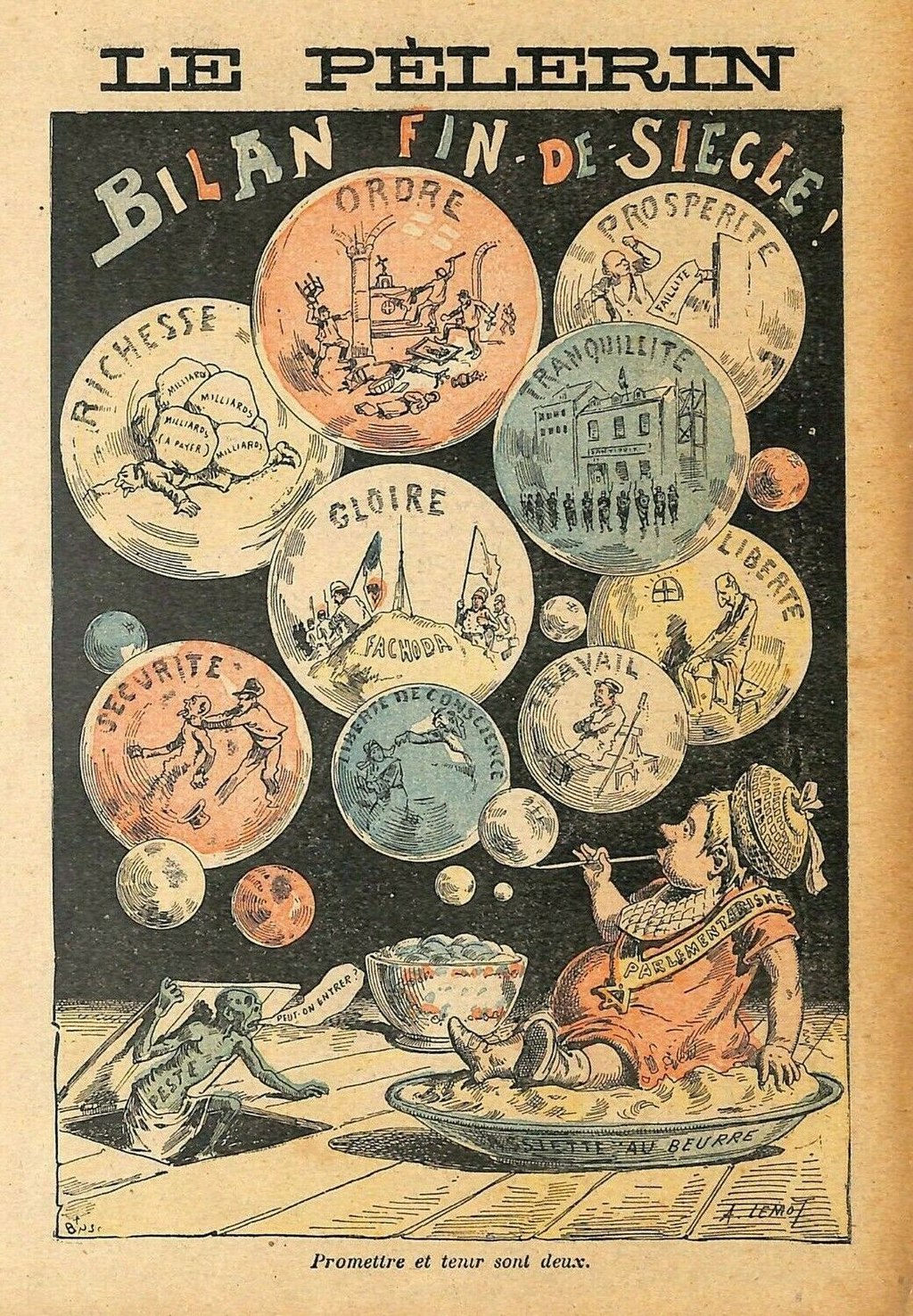 "Bilan fin de siècle" (Assessment at the end of the century), anti-Republican caricature published in Le Pèlerin in 1900 The Dreyfus affair brought the confrontation between two sides of France to life.[227] However, according to most historians, this opposition served the republican order. There was indeed a strengthening of parliamentary democracy and a failure of monarchist and reactionary forces. The excessive violence of the nationalist parties brought together republicans in a united front, which defeated attempts to return to the old order.[228] In the short term, progressive political forces from the elections of 1893 and confirmed in 1898 as a result of the Dreyfus affair disappeared in 1899. The shock trials of Esterhazy and Zola created a dreyfusian politics whose aim was to develop a republican consciousness and to fight against authoritarian nationalism, which expressed itself during the affair. For the uninhibited growth of populist nationalism was another major result of the event in French politics even though it did not originate from the Dreyfus affair. It grew out of the Boulanger affair, 1886–1889, and was shaped into a coherent theory by Maurice Barrès in 1892.[229] Nationalism had its ups and downs, but managed to maintain itself as a political force under the name of Action Française, among others. On that occasion many republicans rallied to Vichy, without which the operation of the State would have been precarious, which showed the fragility of the republican institution in extreme circumstances.[230] Upon liberation, Charles Maurras who was convicted on 25 January 1945 for acts of collaboration exclaimed at the verdict: "This is the revenge of Dreyfus!"[231] The other result was an intellectual mutation of socialism. Jaurès was a late Dreyfusard (January 1898) and was persuaded by revolutionary socialists.[232] His commitment became unwavering alongside Georges Clemenceau and from 1899 under the influence of Lucien Herr. The year 1902 saw the birth of two parties: the French Socialist Party, which brought together jaurésiens; and the Socialist Party of France under the influence of Guesde and Vaillant. Both parties merged in 1905 as the French Section of the Workers' International (SFIO). In addition, 1901 saw the birth of the Republican Radical and Radical-Socialist Party, the first modern political party,[233] conceived as an electoral machine of the republican group. It had a permanent structure and relied on networks of Dreyfusards. The creation of the French League for Human Rights was contemporaneous with the affair. It was the hub of the intellectual left and extremely active at the beginning of the century, the conscience of the humanist left. The final consequence on the political scene at the turn of the century saw a profound renewal of political personalities with the disappearance of great republican figures beginning with Auguste Scheurer-Kestner. Those who at the end of the century could weigh heavily on the events of the affair had now disappeared giving way to new men whose ambition was to reform and correct the errors and injustices of the past. The Dreyfus affair created difficulties and blocked the way for improved relations between France and Italy after the customs war as Italy was Europe's most Dreyfusard nation.[234] Social consequences 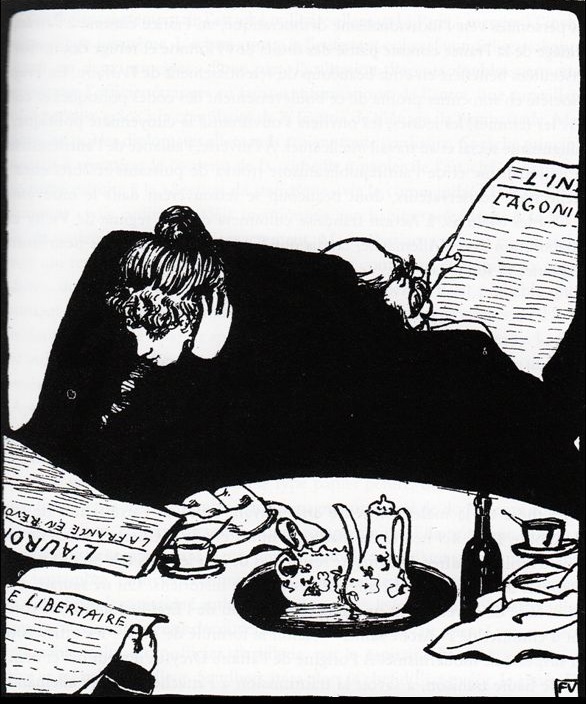 At Home, woodcut by Félix Vallotton in Le Cri de Paris. The Dreyfus affair lastingly cut France in two, even within families. Socially, antisemitism was prominent. Existing prior to the Dreyfus affair, it had expressed itself during the Boulangisme affair and the Panama scandals but was limited to an intellectual elite. The Dreyfus affair spread hatred of Jews through all strata of society, a movement that certainly began with the success of Jewish France by Édouard Drumont in 1886.[235] It was then greatly amplified by various legal episodes and press campaigns for nearly fifteen years. Antisemitism was from then on official and was espoused in numerous settings including the working classes.[236] Candidates for the legislative elections took advantage of antisemitism as a watchword in parliamentary elections. This antisemitism was reinforced by the crisis of the separation of church and state in 1905, which probably led to its height in France. Antisemitic actions were permitted on the advent of the Vichy regime, which allowed free and unrestrained expression of racial hatred. Another social consequence was the enhanced role of the press. For the first time it exerted an important influence on French political life.[237] It was possible to speak of a fourth estate since it could act the part of all state organs.[238] Especially as the high editorial quality of the press was mainly derived from the work of writers and novelists who used newspapers as a revolutionary way of expression. The power of the press certainly brought politicians to action, an example of which was Mercier, who appeared to have pushed at the Dreyfus trial in 1894 to please La Libre Parole who attacked ferociously. This being said the role of the press was limited by the size of circulation, influential in Paris but to a lesser extent nationwide.[239] The entire run of the national press appeared to revolve around four and a half million copies whose real influence was relatively strong. There was also assistance through the publication in 1899 of a specific newspaper intended to coordinate the fight (in the dreyfusard camp), with the People's Daily of Sébastien Faure. Zionism 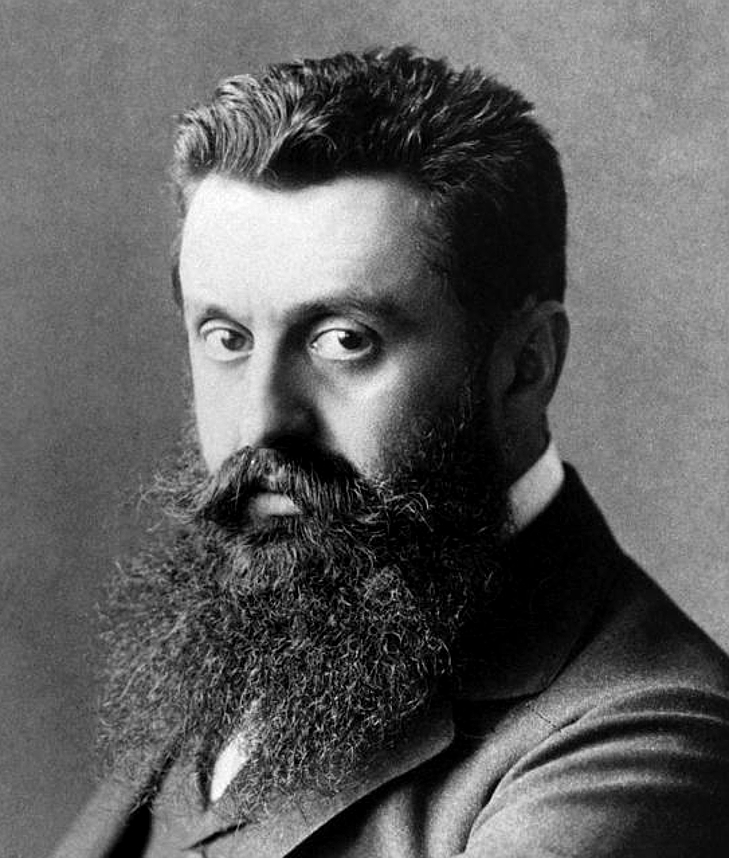 Theodor Herzl created the Zionist Congress after the Dreyfus affair. The shock of the Dreyfus affair also affected the Zionist movement "which found fertile ground for its emergence".[240] The Austro-Hungarian journalist Theodor Herzl appeared profoundly moved by the Dreyfus affair, which followed his debut as a correspondent for the Neue Freie Presse of Vienna and was present at the degradation of Dreyfus in 1895. "The catalyst for Herzl's 'conversion' is usually seen as the Dreyfus affair, which made him realise the impossibility of Jewish existence in Europe",[241] although some scholars believe that Herzl may have exaggerated the influence that the Dreyfus affair had on him.[242][243] Before the wave of antisemitism that accompanied the degradation Herzl was "convinced of the need to resolve the Jewish question", which became "an obsession for him". In Der Judenstaat (State of the Jews), he considered that: [I]f France – bastion of emancipation, progress and universal socialism – [can] get caught up in a maelstrom of antisemitism and let the Parisian crowd chant 'Kill the Jews!' Where can they be safe once again – if not in their own country? Assimilation does not solve the problem because the Gentile world will not allow it as the Dreyfus affair has so clearly demonstrated.[244] Herzl's shock was great, for, having lived his youth in Austria, an antisemitic country, he chose to live in France for its humanist image, which made it appear a shelter from extremist excess. He had originally been a fanatic supporter for assimilation of Jews into European Gentile society. The Dreyfus affair shook Herzl's view on the world, and he became completely enveloped in a tiny movement calling for the restoration of a Jewish State within the biblical homeland in the Land of Israel. Herzl quickly took charge in leading the movement. He organized on 29 August 1897, the First Zionist Congress in Basel and is considered the "inventor of Zionism as a real political movement".[attribution needed] Theodor Herzl wrote in his diary (1 September 1897): Were I to sum up the Basel Congress in a word – which I shall guard against pronouncing publicly – it would be this: At Basel I founded the Jewish State. If I said this out loud today, I would be answered by universal laughter. Perhaps in five years, and certainly in fifty, everyone will recognize this.[245] The Dreyfus affair also marked a turning point in the lives of many Jews from Western and Central Europe, as the pogroms of 1881–1882 had done for the Jews of Eastern Europe, as many Jews had believed that they were Frenchmen first. Yet Jews, despite the state-sanctioned efforts of the emancipation movement, were never truly accepted into society and were often deemed aliens and outsiders,[246] even when they showed extreme devotion by fighting courageously in the wars of their respective countries.[16] 21st century aftermath In October 2021, French President Emmanuel Macron opened a museum dedicated to the Dreyfus affair in Zola's former home in Médan in the northwestern suburbs of Paris. He said that nothing could repair the humiliations and injustices Dreyfus had suffered, and "let us not aggravate it by forgetting, deepening or repeating them".[247] The reference to not repeating them follows attempts by the French far right to question Dreyfus's innocence. An army colonel was cashiered in 1994 for publishing an article suggesting that Dreyfus was guilty; far-right politician Jean-Marie Le Pen's lawyer responded that Dreyfus's exoneration was "contrary to all known jurisprudence". Éric Zemmour, a far-right political opponent of Macron who had said that France's Second World War collaborationist leader Philippe Pétain, who had assisted deportation of French Jews to Nazi death camps, had, in certain cases, saved their lives, said repeatedly in 2021 that the truth about Dreyfus was not clear, his innocence was "not obvious".[247] Though Alfred Dreyfus was eventually exonerated of all charges, the scandal and its aftermath had lasting repercussions in French society. In the 21st century, the Dreyfus affair remains an important part of French history and has been the focus of much public debate. The controversy has been used to frame discussion on issues such as immigration, religious freedom, minority rights, and the French Republic itself. In recent years, the Dreyfus affair has also been used to draw attention to the resurgence of antisemitism in Europe, and to advocate for legislation that would protect minority rights across the continent. In recent years, there has been a significant push to create legislation to protect minority rights throughout Europe, with the Dreyfus affair serving as an important reference point. In France, lawmakers have proposed a number of bills that would extend protections to minority communities, such as prohibiting discrimination based on ethnicity or religion, and providing additional resources for victims of hate crimes. On a broader European level, the European Union has implemented a variety of measures, such as a hate crime reporting system and a program of positive discrimination to ensure that minority communities are not disproportionately affected by social and economic policies. Additionally, the European Commission has set up a coordinating body to ensure that member states are upholding their obligations to protect minority rights. |
ドレフュス事件の結果 ドレフュス事件は、フランス社会が拷問を受けた社会であることを示すものであった。現代史家のカトリン・シュルタイスは言う: ドレフュス事件の永続的な意義は......複数の物語と複数の歴史的因果関係を顕在化させたことにある。この事件は、長年の信念や緊張関係が、数十年に わたって政治的・文化的景観を変えるような巨大な影響力を持つに至ったことを示している。私たちの理解を深めるためには、道徳的あるいは政治的に役立つよ うにパッケージ化するのではなく、その変容の複雑さを認識し、分析すべきである[226]。 政治的帰結  1900年に『ル・ペレラン』誌に掲載された反共和党の風刺画「世紀末の評価」(Bilan fin de siècle ドレフュス事件は、フランスにおける二つの対立を浮き彫りにした[227]。しかし、ほとんどの歴史家によれば、この対立は共和制の秩序に貢献するものであった。確かに議会制民主主義は強化され、君主主義勢力と反動勢力は失敗した。 民族主義政党の過剰な暴力は共和主義者たちを統一戦線に結集させ、旧体制への回帰の試みを打ち破った[228]。短期的には、1893年の選挙から進歩的 な政治勢力が1899年に消滅し、ドレフュス事件の結果として1898年に確認された。エステルハージとゾラの衝撃的な裁判はドレフュス政治を生み出し、 その目的は共和主義的な意識を発展させ、事件中に表明した権威主義的なナショナリズムと闘うことであった。ポピュリスト的ナショナリズムの野放図な成長 は、ドレフュス事件に端を発するものではないにせよ、フランス政治におけるこの事件のもう一つの大きな結果であった。それは1886年から1889年にか けてのブーランジェ事件から発展し、1892年にモーリス・バレスによって首尾一貫した理論として形成された[229]。国民主義は浮き沈みを繰り返した が、アクション・フランセーズなどの名の下に政治勢力としての地位を維持することに成功した。その際、多くの共和主義者がヴィシーに結集し、ヴィシーがな ければ国家の運営は不安定なものとなっていたであろうが、これは極限状況下における共和制の脆弱性を示していた[230]。解放後、1945年1月25日 に協力行為により有罪判決を受けたシャルル・モーラスは、判決の際に「これはドレフュスの復讐だ!」と叫んだ[231]。 もうひとつの結果は、社会主義の知的変異であった。ジョレスはドレフュサール(1898年1月)に遅れて入国し、革命的社会主義者に説得された [232]。ジョルジュ・クレマンソーとともに、また1899年からはルシアン・ヘルの影響下で、彼のコミットメントは揺るぎないものとなった。1902 年には、フランス社会党とフランス社会党の2つの政党が誕生した。両党は1905年に合併し、労働者インターナショナル(SFIO)フランス支部となっ た。 さらに1901年には、共和主義グループの選挙機関として構想された最初の近代的政党である共和急進急進社会主義党が誕生した[233]。この政党は恒久 的な構造を持ち、ドレフュサール派のネットワークに依存していた。フランス人権擁護連盟の設立はこの事件と同時期であった。この連盟は知識人左派の中枢で あり、今世紀初頭には非常に活発で、ヒューマニスト左派の良心であった。 世紀末の政治情勢の最終的な帰結は、オーギュスト・ショイエール=ケストナーを始めとする共和主義的な大物政治家が姿を消し、政治的人格が大きく刷新され たことであった。世紀末にドレフュス事件に大きな影響を与えた人々は姿を消し、過去の過ちや不公正を改革し正そうとする新たな人物に道を譲った。 ドレフュス事件は、イタリアがヨーロッパで最もドレフュス派の国民であったことから、関税戦争後のフランスとイタリアの関係改善に困難をもたらし、道を閉ざした[234]。 社会的影響  『ル・クリ・ド・パリ』に掲載されたフェリックス・ヴァロットンの木版画『家庭にて』。ドレフュス事件は、家族内でもフランスを二分した。 社会的には反ユダヤ主義が目立った。ドレフュス事件以前にも、ブーランジェスム事件やパナマ事件で反ユダヤ主義は存在したが、それは知的エリートに限られ ていた。ドレフュス事件は社会のあらゆる階層にユダヤ人への憎悪を広めたが、この動きは1886年にエドゥアール・ドゥルモンが『ユダヤ人フランス』を出 版したことから始まった[235]。反ユダヤ主義は当時から公式なものであり、労働者階級を含む多くの場面で支持されていた[236]。 議員選挙の候補者は、議会選挙における合言葉として反ユダヤ主義を利用した。この反ユダヤ主義は、1905年の政教分離の危機によって強化され、おそらく フランスにおける反ユダヤ主義の最盛期をもたらした。ヴィシー政権が誕生し、人種的憎悪を自由奔放に表現できるようになると、反ユダヤ主義的な行動が許さ れるようになった。 もうひとつの社会的帰結は、報道機関の役割が強化されたことである。報道機関はすべての国家機関の役割を果たすことができたため、第四の権力と呼ぶことも 可能であった[237]。特に、新聞を革命的な表現方法として利用した作家や小説家の仕事によって、報道機関の高い編集力がもたらされた。その例として、 1894年のドレフュス裁判では、猛烈に攻撃してきた『ラ・リーブル・パロル』を喜ばせるために、メルシエが押し切ったように見えた。とはいえ、新聞の役 割は発行部数の大きさによって制限され、パリでは影響力があったが、全国的にはそれほどでもなかった[239]。国民新聞の発行部数は全体で450万部ほ どで、その実質的な影響力は比較的強かったようだ。1899年には、セバスチャン・フォールの『人民日報』によって、(ドレフュサール陣営の)戦いを調整 することを意図した特定の新聞が発行された。 シオニズム ドレフュス事件の後、テオドール・ヘルツルがシオニズム会議を創設した。 ドレフュス事件の衝撃はシオニズム運動にも影響を与え、「その出現のための肥沃な土壌を見出した」[240]。  オーストリア=ハンガリーのジャーナリストであるテオドール・ヘルツルは、ウィーンの『ノイエ・フライ・プレス』紙の特派員としてデビューした後、ドレ フュス事件に深く心を動かされ、1895年のドレフュス追放に立ち会った。「しかし、ドレフュス事件が彼に与えた影響を誇張していると考える学者もいる [242][243]。ドレフュス事件に伴う反ユダヤ主義の波の前に、ヘルツルは「ユダヤ人問題を解決する必要性を確信していた」。彼は『ユダヤ人の国 家』(Der Judenstaat)の中で次のように考えている: [解放、進歩、普遍的社会主義の砦であるフランスが反ユダヤ主義の渦に巻き込まれ、パリの群衆に『ユダヤ人を殺せ!』と唱えさせることができるのであれ ば、彼らが再び安全に暮らせる場所はどこにあるだろうか。自国でなければ、彼らはどこで再び安全に暮らせるのだろうか?同化しても問題は解決しない。ドレ フュス事件がはっきりと示したように、異邦人世界がそれを許さないからである[244]。 反ユダヤ主義国であるオーストリアで青春時代を過ごしたヘルツルは、過激主義者の行き過ぎた行動から保護されるようなヒューマニズムのイメージのあるフラ ンスでの生活を選んだからである。彼はもともと、ユダヤ人のヨーロッパ異邦人社会への同化を熱狂的に支持していた。ドレフュス事件はヘルツルの世界観を揺 るがし、彼はイスラエルの地に聖書の祖国であるユダヤ人の国家を回復することを求める小さな運動にすっかりのめり込んでしまった。ヘルツルはすぐにこの運 動を率いることになった。 彼は1897年8月29日にバーゼルで第1回シオニスト会議を開催し、「真の政治運動としてのシオニズムの発明者」とみなされている: バーゼル大会を一言で要約するとすれば-公言は避けたいが-それはこうであろう: バーゼルで私はユダヤ国家を建国した。今日、私がこのことを大声で言えば、万人の笑いが返ってくるだろう。おそらく5年後には、そして間違いなく50年後 には、誰もがこのことを認識するだろう[245]。 ドレフュス事件はまた、1881年から1882年にかけてのポグロムが東ヨーロッパのユダヤ人にとってそうであったように、多くのユダヤ人が自分たちはま ずフランス人であると信じていたように、西欧と中欧の多くのユダヤ人にとって人生の転機となった。しかしユダヤ人は、解放運動の国家公認の努力にもかかわ らず、社会に真に受け入れられることはなく、それぞれの国の戦争で勇敢に戦うことによって極度の献身を示したとしても、しばしば異国人や部外者とみなされ た[246]。 21世紀の余波 2021年10月、フランスのエマニュエル・マクロン大統領は、パリ北西郊外のメダンにあるゾラの旧宅にドレフュス事件専門の博物館を開設した。彼は、ド レフュスが受けた屈辱と不当な扱いを修復できるものは何もなく、「それらを忘れたり、深めたり、繰り返したりすることによって、それを悪化させないように しよう」と述べた[247]。 ドレフュスの潔白を問うフランスの極右勢力による試みに続いて、同じことを繰り返してはならないという言及がなされた。極右政治家ジャン=マリー・ルペン の弁護士は、ドレフュスの無罪は「すべての既知の法学に反する」と反論した。極右政治家でマクロンに反対していたエリック・ゼムールは、フランスの第二次 世界大戦の協力主義者であり、ナチスの死の収容所へのフランス人ユダヤ人の強制送還を支援したフィリップ・ペタンが、場合によっては彼らの命を救ったと発 言していたが、ドレフュスに関する真実は明らかではなく、彼の無実は「明白ではない」と2021年に繰り返し発言した[247]。 アルフレッド・ドレフュスは最終的に無罪となったが、このスキャンダルとその余波はフランス社会に永続的な影響を与えた。21世紀になっても、ドレフュス 事件はフランス史の重要な一部であり、多くの国民的議論の焦点となっている。この論争は、移民、宗教の自由、マイノリティの権利、フランス共和国そのもの といった問題についての議論の枠組みとして使われてきた。近年では、ドレフュス事件は、ヨーロッパにおける反ユダヤ主義の復活に注意を喚起し、ヨーロッパ 大陸全体のマイノリティの権利を保護する法律を提唱するためにも利用されている。近年、ドレフュス事件を重要な参照点として、ヨーロッパ全土でマイノリ ティの権利を保護するための法律を制定しようとする動きが顕著になっている。フランスでは、民族や宗教に基づく差別の禁止や、ヘイトクライムの被害者への 追加的な支援など、マイノリティ・コミュニティの保護を拡大する法案が議員によって数多く提出されている。より広範な欧州レベルでは、欧州連合(EU) が、社会・経済政策によってマイノリティ・コミュニティが不釣り合いな影響を受けないようにするため、ヘイトクライム報告制度や積極的差別プログラムな ど、さまざまな施策を実施している。さらに欧州委員会は、加盟国がマイノリティの権利を保護する義務を確実に守るための調整機関を設立した。 |
| Other related events Commission of sculpture 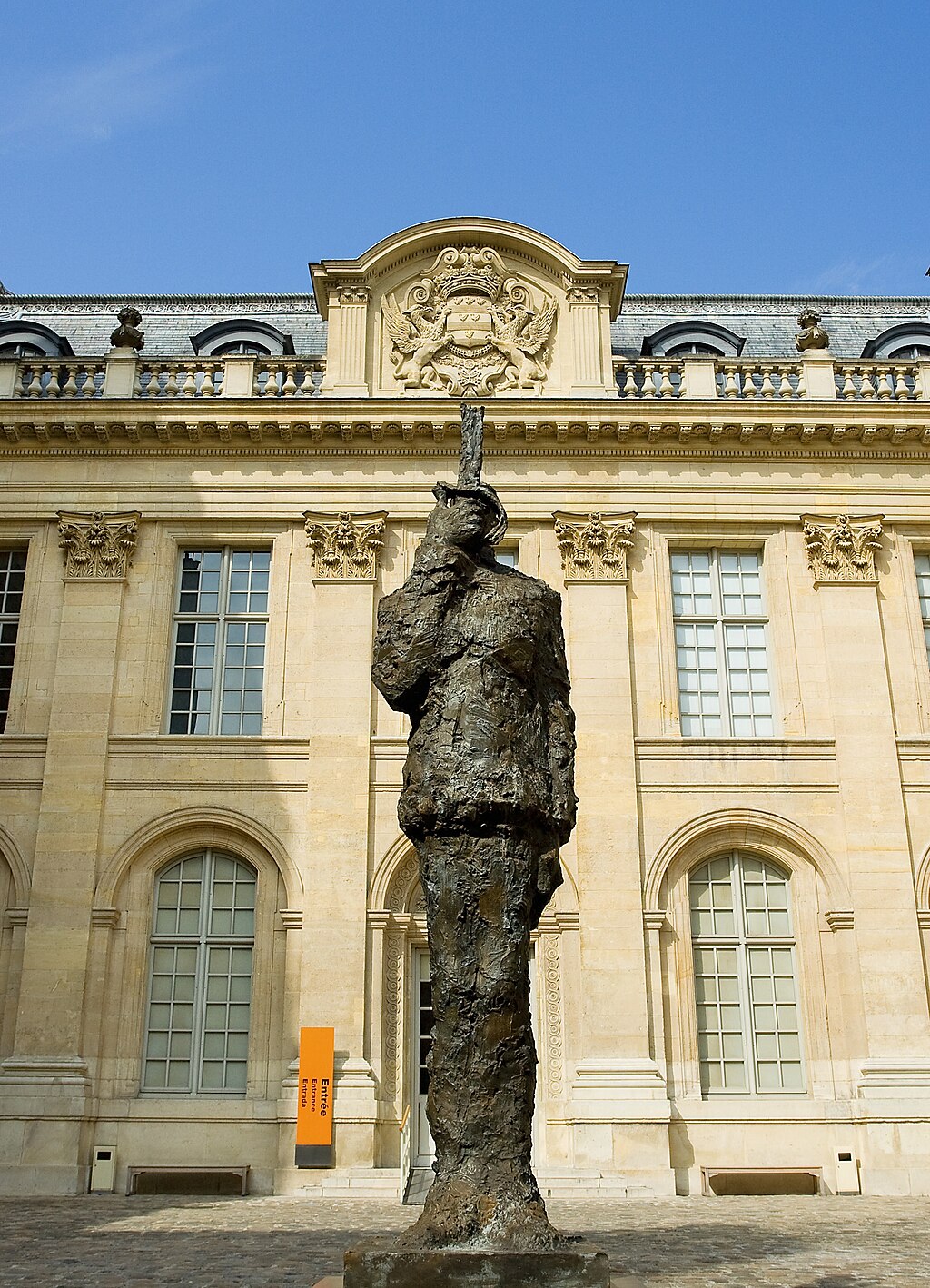 The statue of Captain Dreyfus in the courtyard of the Hôtel de Saint-Aignan, home of the Musée d'Art et d'Histoire du Judaïsme In 1985, President François Mitterrand commissioned a statue of Dreyfus by sculptor Louis Mitelberg. It was to be installed at the École Militaire but the Minister of Defense Charles Hernu refused to display it there.[248] Hernu claimed that this was because the École Militaire is not open to the public, but it was widely believed that this was done to avoid provoking the army.[249][250] Mitterrand did not override his minister and the statue was instead installed at Boulevard Raspail, No. 116–118 at the exit of the Notre-Dame-des-Champs metro station, where it can be found today. A replica is located at the entrance of Paris's Museum of Jewish Art and History, which houses the Fonds Alfred Dreyfus of over 2500 historical documents donated by the grandchildren of Captain Dreyfus.[251] Centennial commemoration On 12 July 2006, President Jacques Chirac held an official state ceremony marking the centenary of Dreyfus's official rehabilitation. This was held in the presence of the living descendants of both Émile Zola and Alfred Dreyfus. The event took place in the same cobblestone courtyard of Paris's École Militaire where Capitaine Dreyfus had been officially stripped of his officer's rank. Chirac stated that "the combat against the dark forces of intolerance and hate is never definitively won", and called Dreyfus "an exemplary officer" and a "patriot who passionately loved France". The French National Assembly also held a memorial ceremony of the centennial marking the end of the affair. This was held in remembrance of the 1906 laws that had reintegrated and promoted both Dreyfus and Picquart at the end of the Dreyfus affair. Historiography of the Dreyfus affair 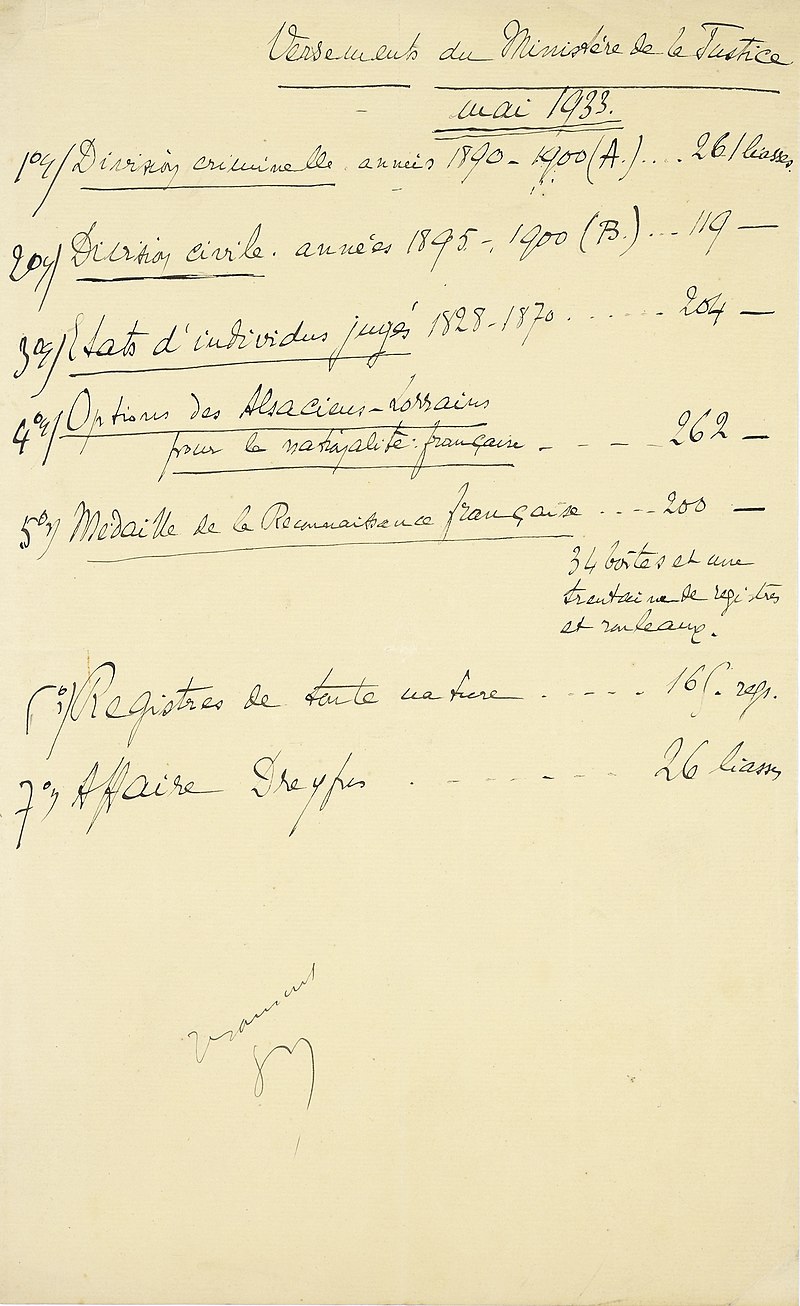 List of documents in the French National Archives related to the Dreyfus affair and given by the ministry of Justice The Dreyfus affair is distinguished by the large number of books published on this subject.[252][253][254] The contemporary literature of the case was published between 1894 and 1906. It began with the pamphlet of Bernard Lazare, the first intellectual Dreyfusard. The Precis of the Dreyfus Affair by "Henri-Dutrait Crozon", a pseudonym of Colonel Larpent, is the basis of all anti-Dreyfusard literature after the affair to the present time. The author develops the theory of conspiracy, fueled by Jewish finance, to push Esterhazy to accuse himself of crime. Under a scientific exterior there will be found there an elaboration of theories without evidence or support. The publication of notes by Schwartzkoppen in 1930 shed light on the guilty role of Esterházy in the affair and exonerated Alfred Dreyfus at the same time, if such vindication was needed. The extreme right questioned the value of this testimony but most historians hold it to be a valid source despite some ambiguities and inaccuracies. The period of the occupation throws a veil over the case. The liberation and the revelation of the Holocaust brought a deep reflection on all of the Dreyfus affair. Jacques Kayser (1946) then Maurice Paléologue (1955) and Henri Giscard d'Estaing (1960) revived the case without great revelations, a process generally considered insufficient historically.[by whom?] 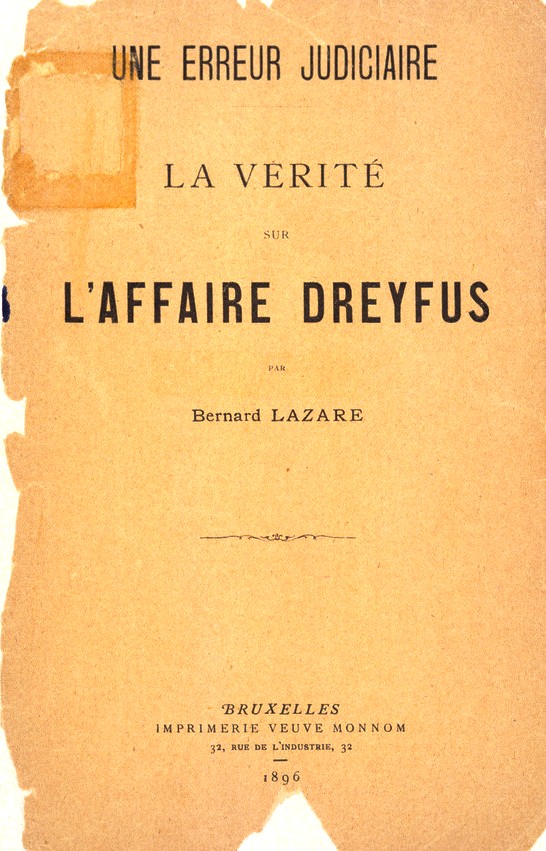 First brochure of A Miscarriage of Justice, Bernard Lazare published in 1896 in Brussels Marcel Thomas, chief curator at the National Archives, in 1961 provided through his The Affair Without Dreyfus in two volumes a complete review of the history of the affair supported by all available public and private archives. His work is the foundation of all subsequent historical studies.[255] Reflecting the intense interest in social history that gripped historians since the 1960s and 1970s, Eric Cahm wrote The Dreyfus Affair in French Society and Politics (1996), an analysis of the sociology of the affair. Michael Burns, Rural Society and French Politics, Boulangism and the Dreyfus Affair, 1886–1900 (1984) does the same in a more limited fashion. Vincent Duclert's Biography of Alfred Dreyfus (2005) includes, in 1300 pages, the complete correspondence of Alfred and Lucie Dreyfus from 1894 to 1899. Early writers marginalized the role of antisemitism. However since the publication of Jean-Denis Bredin, The Affair: The Case of Alfred Dreyfus (1986) and Stephen Wilson, Ideology and Experience: Antisemitism in France at the Time of the Dreyfus Affair (1982), more attention has been paid to the undercurrent of antisemitism in French society and its effect on the evolution of the case.[256] In 1983, the lawyer and historian Jean-Denis Bredin published L'Affair (The Affair). The interest of the book focuses on a strictly factual relating of the story with documented facts and multifaceted reflection on the different aspects of the event. The book also revealed for the first time the existence of homosexual correspondence in the prosecution case. Expanding on a 2008 article they published in la Revue d'histoire moderne et contemporaine, in 2012 the historians Pierre Gervais, Pauline Peretz and Pierre Stutin published Le dossier secret de l'affaire Dreyfus (The Secret Record of the Dreyfus Affair). Their research enabled the original contents of the secret file to be established. Their thesis was that historians had neglected the correspondence of Schwartzkoppen and Panizzardi, and that homosexuality played a central role in the slandering of Dreyfus.[10][11][clarification needed] |
その他の関連イベント 彫刻の依頼  ユダヤ美術・歴史博物館のあるサン・テニャン宮殿の中庭にあるドレフュス大尉像 1985年、フランソワ・ミッテラン大統領は、彫刻家ルイ・ミテルベルグにドレフュス像を依頼した。エコール・ミリテールに設置される予定であったが、 シャルル・エルヌ国防大臣が展示を拒否した[248]。エルヌは、エコール・ミリテールが一般公開されていないからだと主張したが、これは軍を刺激しない ためだと広く信じられていた[249][250]。ミッテランは大臣を制止せず、代わりに像は地下鉄ノートルダム・デ・シャン駅出口のラスパイユ大通り 116-118番地に設置され、現在に至っている。レプリカはパリのユダヤ美術歴史博物館の入り口にあり、ドレフュス大尉の孫から寄贈された2500点以 上の歴史的資料を所蔵するアルフレッド・ドレフュス財団がある[251]。 100周年記念 2006年7月12日、ジャック・シラク大統領は、ドレフュスの社会復帰100周年を記念する公式式典を開催した。この式典は、エミール・ゾラとアルフ レッド・ドレフュス双方の存命中の子孫の出席のもとで行われた。このイベントは、ドレフュス捕囚が将校の階級を公式に剥奪されたのと同じ、パリのエコー ル・ミリテールの石畳の中庭で行われた。シラク大統領は、「不寛容と憎悪の暗黒の力との戦いに決定的な勝利はない」と述べ、ドレフュスを「模範的な将校」 であり、「フランスを熱烈に愛した愛国者」と呼んだ。フランス国民議会はまた、事件終結100周年記念式典を開催した。これは、ドレフュス事件終結後、ド レフュスとピカールを再統合し昇進させた1906年の法律を記念して行われた。 ドレフュス事件の歴史的経緯  ドレフュス事件に関連するフランス国民公文書館所蔵の文書(司法省提供)のリスト ドレフュス事件は、このテーマについて出版された多くの書籍によって特徴づけられる[252][253][254]。 この事件に関する現代の文献は1894年から1906年にかけて出版された。最初の知識人ドレフュサールであるベルナール・ラザールの小冊子から始まった。 ラルパン大佐のペンネームである「アンリ=デュトワ・クロゾン」による『ドレフュス事件詳報』は、事件後現在に至るまで、すべての反ドレフュサール文学の 基礎となっている。著者は、ユダヤ人金融の煽りを受け、エステルハージに罪を着せようとした陰謀説を展開している。科学的な外観の下で、そこには証拠も裏 付けもない理論の推敲が見られるだろう。 1930年に出版されたシュバルツコッペンのノートは、この事件におけるエステルハージの有罪の役割を明らかにし、同時にアルフレッド・ドレフュスの冤罪 を晴らした。極右勢力はこの証言の価値を疑問視したが、ほとんどの歴史家は、いくつかの曖昧さや不正確さにもかかわらず、この証言は有効な情報源であると している。 占領時代がこの事件にベールをかけている。解放とホロコーストの発覚は、ドレフュス事件のすべてに深い反省をもたらした。ジャック・カイザー(1946 年)、モーリス・パレオローグ(1955年)、アンリ・ジスカール・デスタン(1960年)は、歴史的には不十分とされるこの事件を、大々的に暴露するこ となく復活させた。  ベルナール・ラザールが1896年にブリュッセルで出版した『正義の誤算』の最初のパンフレット 国民公文書館の主任学芸員であったマルセル・トマスは、1961年に『ドレフュスなき事件』(全2巻)を出版し、入手可能なすべての公文書と私文書によってこの事件の歴史を全面的に検証した。彼の著作は、その後のすべての歴史研究の基礎となっている[255]。 エリック・カームは、1960年代から1970年代にかけて歴史家を虜にした社会史への強い関心を反映し、この事件の社会学を分析した『フランス社会と政 治におけるドレフュス事件』(1996年)を著した。Michael Burns, Rural Society and French Politics, Boulangism and the Dreyfus Affair, 1886-1900 (1984)は、より限定された形で同様の分析を行っている。ヴァンサン・デュクレールの『アルフレッド・ドレフュス伝』(2005年)には、1894年 から1899年までのアルフレッドとリュシー・ドレフュスの書簡全1300ページが収められている。 初期の作家たちは、反ユダヤ主義の役割を疎外していた。しかし、ジャン=ドニ・ブレダン『アルフレッド・ドレフュスの事件』が出版されてからは、反ユダヤ 主義がドレフュスに与えた影響は無視されるようになった: アルフレッド・ドレフュスの場合』(1986年)とスティーヴン・ウィルソン『イデオロギーと経験』(1986年)が出版されて以来、反ユダヤ主義がフラ ンスの反ユダヤ主義に与えた影響は無視されるようになった: ドレフュス事件当時のフランスにおける反ユダヤ主義』(1982年)が出版されて以来、フランス社会における反ユダヤ主義の底流と、それが事件の進展に及 ぼした影響に注目が集まっている[256]。 1983年、弁護士であり歴史家でもあるジャン=ドニ・ブレダンは『L'Affair(事件)』を出版した。この本の興味は、文書化された事実と事件のさ まざまな側面に関する多面的な考察によって、物語を厳密に事実に関連付けることにある。同書はまた、検察事件における同性愛者の手紙の存在を初めて明らか にした。歴史家のピエール・ジェルヴェ、ポーリーヌ・ペレツ、ピエール・ストゥーティンは、2008年に『la Revue d'histoire moderne et contemporaine』誌に発表した論文を発展させ、2012年に『ドレフュス事件の秘密の記録』を出版した。彼らの調査によって、秘密ファイルの 本来の内容が明らかにされたのである。彼らの論文は、歴史家たちがシュバルツコッペンとパニツァルディの書簡を軽視してきたこと、ドレフュスへの中傷にお いて同性愛が中心的な役割を果たしたというものであった[10][11][要解説]。 |
| In literature The Dreyfus affair provided the basis for many novels. The last work of Émile Zola (1902), Truth, transposes the Dreyfus affair to the world of education. Anatole France published The Island of Penguins (1907), which recounts the affair in Book VI: "The Case of 80,000 bundles of hay".[257] Franz Kafka's short story "In the Penal Colony" drew inspiration from Devil's Island and the debate about justice and punishment the Dreyfus affair provoked in French society. Marcel Proust devoted significant passages of his second, third and fourth volumes of In Search of Lost Time to Parisian society's reaction to the Dreyfus affair. Other authors have also contributed, such as Roger Martin du Gard and Maurice Barrès. The 2013 novel An Officer and a Spy by Robert Harris, and the 2019 film adapted from it, tell the story of the Dreyfus affair from Picquart's perspective. |
文学 ドレフュス事件は多くの小説の原作となった。エミール・ゾラの遺作『真実』(1902年)は、ドレフュス事件を教育界に置き換えている。アナトール・フラ ンスは『ペンギンの島』(1907年)を出版し、第6巻「8万本の干し草の束の事件」で事件を再現している[257]。フランツ・カフカの短編小説『流刑 地にて』は『悪魔の島』から着想を得ており、ドレフュス事件がフランス社会で引き起こした正義と刑罰に関する議論を描いている。マルセル・プルーストは、 『失われた時を求めて』の第2巻、第3巻、第4巻のかなりの部分を、ドレフュス事件に対するパリ社会の反応に割いている。ロジェ・マルタン・デュ・ガール やモーリス・バレスなど、他の作家も寄稿している。 ロベール・ハリスによる2013年の小説『An Officer and a Spy』と、それを映画化した2019年の『An Officer and a Spy』は、ドレフュス事件をピカールの視点から描いている。 |
| Menahem Mendel Beilis affair Hilsner affair Leo Frank affair Human Rights League (France) The Dreyfus Affair (film series), an 1899 series of short silent docudramas Musée d'Art et d'Histoire du Judaïsme Henry Ossian Flipper Bibliography of the Dreyfus Affair |
メナヘム・メンデル・ベイリス事件 ヒルスナー事件 レオ・フランク事件 人権連盟(フランス) ドレフュス事件(映画シリーズ)、1899年の短編無声ドキュメントドラマシリーズ ユダヤ美術歴史博物館 ヘンリー・オシアン・フリッパー ドレフュス事件の文献目録 |
| https://en.wikipedia.org/wiki/Dreyfus_affair |
|
【設問】
1.
2.
リンク
文献
Copyleft, CC, Mitzub'ixi Quq Chi'j, 1996-2099
Do not paste, but
[Re]Think our message for all undergraduate
students!!!